











Elegance is an attitude
Simon Baker


















The Longines Master Collection
T. 0322389192
INFO@MOTIF.GE


BUDAPESHTI ST. 7
WWW.MOTIF.GE
MAXALTO IS A B&B ITALIA BRAND. COLLECTION COORDINATED BY ANTONIO CITTERIO. WWW.MAXALTO.IT

pc studiophoto tommaso sartori




ARCHIDEA 25 V. Petriashvili str. Tel: +995 322 253 434




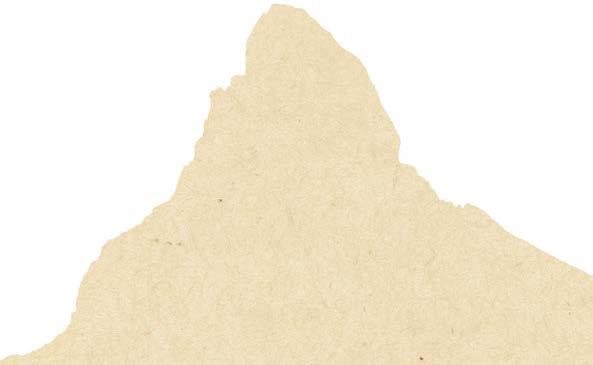


8 VOYAGER 5/2016 CONTENT ZURICH Museums / Cathedrals Hotels / SPA Restaurants / Bars / Clubs Shopping Chocolate / Pastry BASEL Museums Cathedrals Restaurants Shopping ART BASEL "Olympic Games" of the Contemporary Art World 44 WINTER Zermatt / St. Moritz Saas-fee / Verbier / Gstaad Davos Klosters / Crans-Montana SWISS MADE 56 A Carved Space 72 First Time in Switzerland... 76 The Ambitious Charm 78 of Swiss Education THE NOBLE DRAGON 82 An Oasis of Relaxation 86 On the Verge of 92 Cosmetics and Medicine Competition with Own Self 96 CITIES Geneva Bern Lucerne Vevey Montreux Lugano 16 / 35 38 / 43 ZURICH .. Portugieser Grande Emmental Zai Testa Matterhorn Boskar Weekender Alperchibi yveli saaTi Sokoladi beWedi brendi yava Rvino yelsabami le korbuzie, arqiteqtori romis papis gvardieli Txilamurebi eqskluziuri festivali samgzavro CanTa droSa, saxelmwifo simbolo matarebeli mTa dana edelvaisi, qveynis simbolo S L mogzaurisaTvis O O 50 / 63 116 / 126

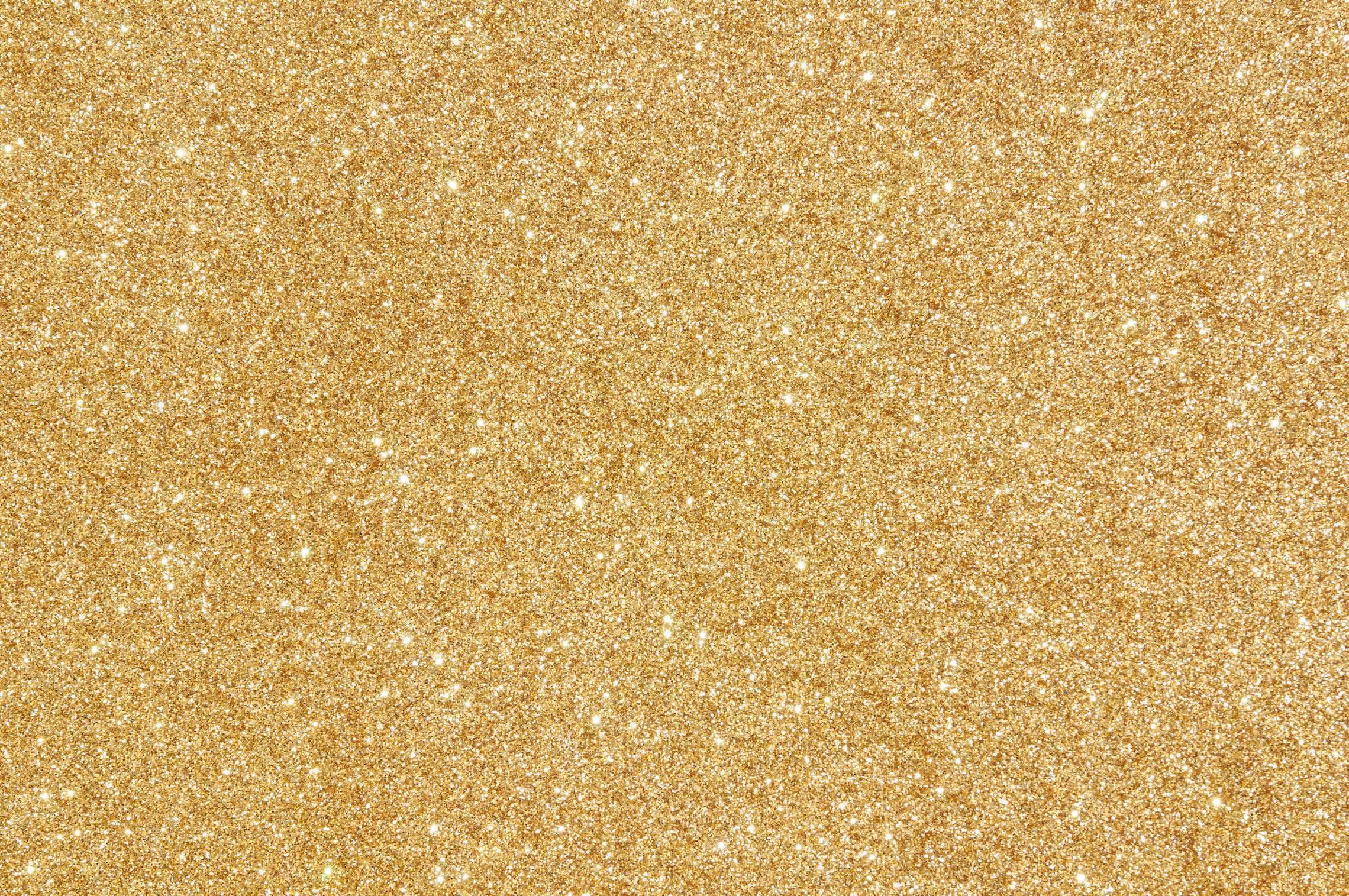
5, 2016
Editor-in-Chief Tea Skhirieli
Designer
Nino Kavelashvili
Illustrations by Maia Sumabdze

Translation by Lika Barabadze
Art - Director
Nino Daraseli
Authors:
Aka Morchiladze
Margarita Antidze
Bidzina Baratashvili
Nikoloz Chkhaidze
Marika Shalikashvili
Nino Lursmanashvili
Irena Popiashvili
Zaza Chiladze
Mzia Chikhradze
Marina Kipshidze
Lasha Bughadze
Editor Salome Dadunashvili
Administrative Assistant
Giorgi Vasadze
Advertisement Manager
Nazi Goshadze
We would like to thank Tea Kekelidze and Rimma Shaginian.
Project Manager / SOLO DIRECTOR
Eka Duchidze
Project Consultant
Publisher: LTD SOLO
Phone.: +995 32 2 44 44 00
ISSN: 2346-8130
Printed by:
Bauer Medien Productions & Handels Gmbh
Adress: Baumannstrasse 3/19, A – 1030 Vienna, Austria
e-mail: office@bauermedien.at www.bauermedien.at
Nino Gegeshidze
SOLO Brand Manager
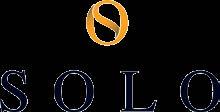
Keti Nikoleishvili
Print Management: Ctrl P
Address: Tbilisi 0186, Kavtaradze 27a
Phone: +995 32 2 381 908
10 VOYAGER 5/2016
Photo - Shutterstock
Published material owned by LTD SOLO. Written Consent of the Company necessary for use of any material published in this magazine.
Advertising: +995 599 330 364 /

I t ’ s t i m e f o r s o l a r p ow e r. TAC T I L E T EC H NO LO GY T I S S O T T - T O U C H E X P E R T S O L A R TAC T I L E T E C H NO LO G Y P O W E R E D WEATHER FORECAST AND COMPASS. T I S S O T W A T C HE S C O M P O W E R E D B Y S O L A R E N E R G Y
TBILISI SOLO LOUNGE MTASTMINDA 11 Chitadze Str.
TBILISI SOLO LOUNGE PALIASHVILI 23, Paliashvili Str.
TBILISI SOLO LOUNGE ABASHIDZE 70, Abashidze Str.
TBILISI SOLO LOUNGE TSINTSADZE 12, Tsintsadze Str.
TBILISI SOLO LOUNGE Chavchavadze 29, Chavchavadze Ave.
TBILISI SOLO LOUNGE KAZBEGI 24G Kazbegi Ave.
TBILISI SOLO LOUNGE KAZBEGI 25 Kazbegi Ave.
KUTAISI SOLO LOUNGE KUTAISI 5 Q. Tamar Str.
BATUMI SOLO LOUNGE Batumi 22 Rustaveli Ave.
TBILISI SOLO LOUNGE TSERETELI 73 Tsereteli Ave.
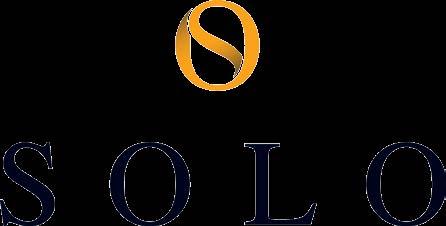
TELAVI SOLO LOUNGE Telavi 3 Cholokashvili Str.

www.solo.ge Tel: +995 32 2 44 44 00


NEW YEAR PRESENTS EXCLUSIVELY FOR SOLO CUSTOMERS Buy a car insurance policy from ALDAGI and receive for free: • Motor Third Party Liability Insurance • Motor Personal Accident Insurance CONTACT YOUR SOLO BANKER TO GET A QUOTE
Amazingly beautiful mountains, chalets, trains flying on bridges suspended in thin air, paradise winter resorts and lake coastlines— this magazine contains so many wonderful photos. Nevertheless, no visual image is able to carry the true meaning of Switzerland; it is probably best described by the word “trust”. Swiss people unconditionally believe in honesty and that is their attitude towards life and their country.
Honesty is the basis of Swiss bank security and stability. The banks reflect society. The direct democracy is based on trust as well, and it makes the Confoederatio Helvetica stand out from the rest of the world. Swiss people vote via referendums at least four times a year, deliberating on an average of 15 issues, and publicly decide how to live.
You will notice the absence of security cameras in Switzerland; every guest leaves his/her coat in the restaurant lobby; unattended goods adorn the storefront; yes, this is how it is, since Swiss people trust each other. No one tries to break the rules or “cheat the system”.
It is impossible to find a Georgian who has travelled to Switzerland without being reminded of Georgia and then hasn’t reflected in pain, how is it possible that a country, similar to Georgia with geographical features and cultural and lingual diversity, not rich with minerals – a small country as well – could reach such economic and political stability on such a grand scale.

EDITOR’S NOTE
Switzerland leads the list of the most healthy and wealthy nations. The average life expectancy is 83.1, second only to Japan. GDP per capita is 80,603 USD, which makes Switzerland fourth in the world.
This is why everybody dreams of spending their old age in the country that runs likes clockwork and where trains are never late; where the biggest city, Zurich, is also the cleanest city in the world; where the teachers have the highest salaries; where people have refused via the referendum system to receive an additional 2,500 CHF profit from the budget; where every man is drafted and then considered a reserve soldier despite his ancestry, profession, position or money in the bank account; and where they even attempted to harness air energy and can actually fly with no fuel. The Solar Impulse plane is an excellent example of the country’s philosophy: this plane, which runs on solar energy, has travelled around the world. Solar Impulse undertook a 40,000 km epic journey and landed 16 times without using a single drop of fossil fuel.
Switzerland is a country of such well-being: people live here for a long time, in peace and prosperity; people’s faces reflect their physical health and confidence, based on their financial stability.
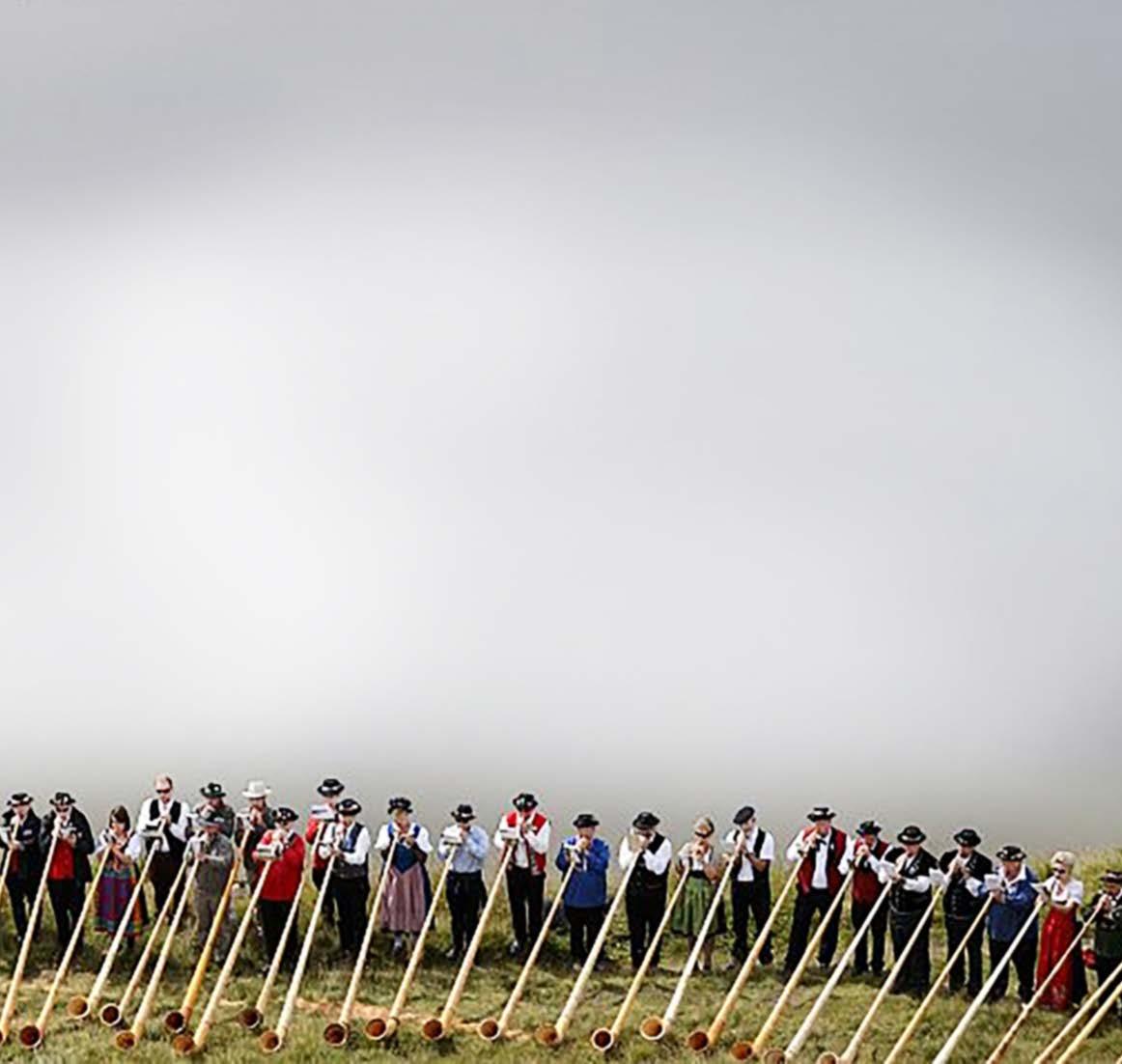 Tea Skhirieli Editor-in-Chief
Tea Skhirieli Editor-in-Chief
SALOME DADUNASHVILI
The peace of the daytime and the night are only interrupted by the tolling bells and the velvety sound of “Lamborghini” engines. The bells toll loudly, once every hour – remember, time is ticking away, and time is money!
The Zurich airport train is also full of the sound of bells – a peal of cow bells. Big, heavy bells, so that the cows keep eating grass. Birds singing and cows mooing tell you that you are in the country of mountains, valleys and lakes, a country divided into cantons, with 1,500 lakes; a country of neutrality; a symbol of prolonged peace and stability. Just go a little further, and you will be able to breathe in the freshest air on earth.
That’s the truth. The air is shiny here, like a freshly frozen icicle, as if it will break over your teeth like a lollipop.
Switzerland is obsessed with garbage recycling. Zurich contains hundreds of public bathrooms, in an appeal to tourists to act civilized; everything is tidy here, unlike Europe’s other countries during the crises.
Clean water streams from the fountains covering the city. You can drink it. Zurich, situated along two banks of the river, is beautiful. Respectable, noble, hard-working people live here. The city’s mayor was serious when he asked his citizens to laugh more, as laughter is good for their health.
Only tourist children disrupt the peace around the clear lake. Birds fly in an orderly manner and only eat organic bird feed. The windows of the villas around the lake smell like cool air and the dust that settles on the frames of Rembrandt paintings.
Zurich is famous for its mountains and turquoise water. These mountains and lakes are worth as much as the most expensive gemstones on the planet.
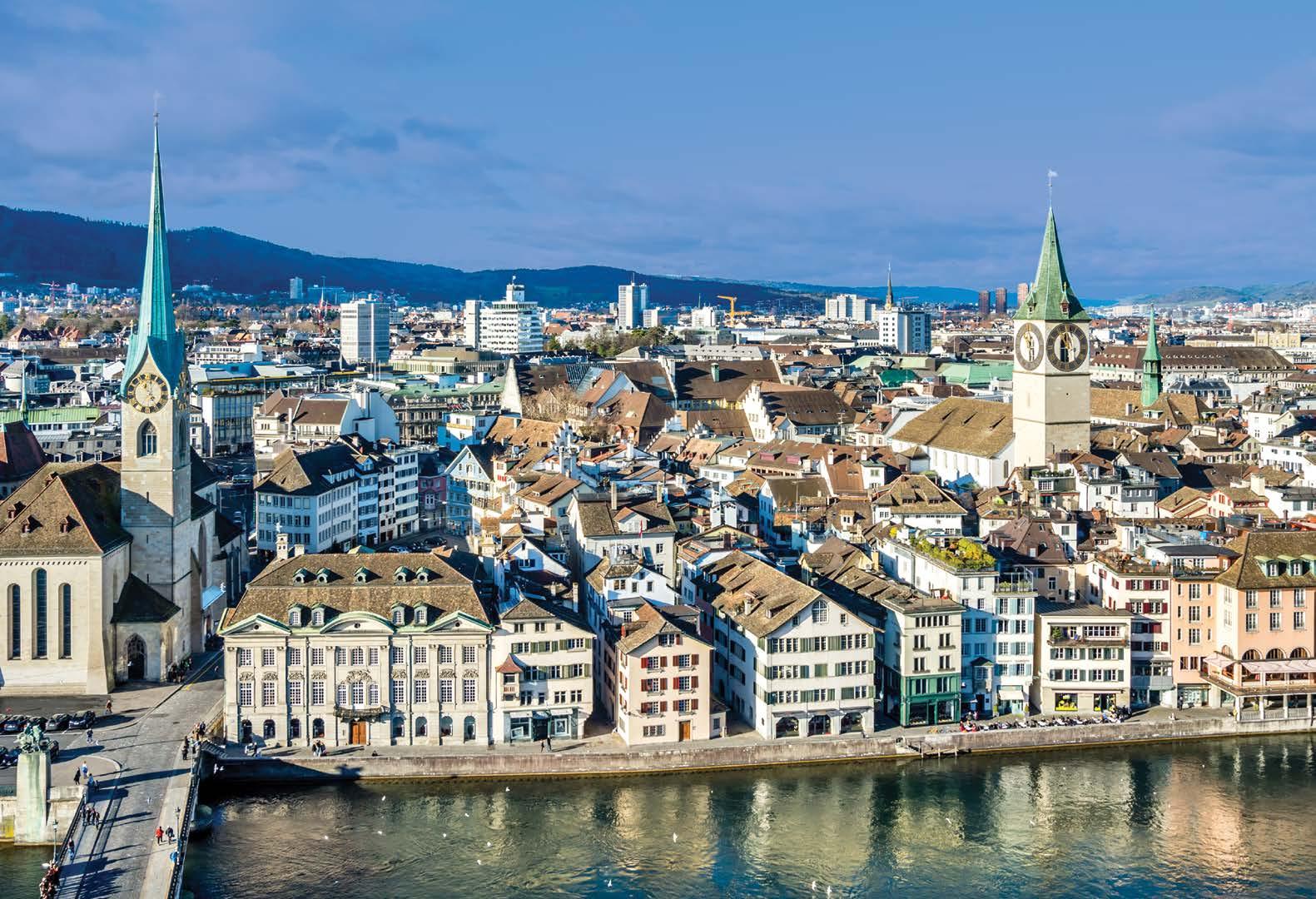
A magic sadness, typical of mountain resorts spreads around these peaks. Nobody gets sick here. Rather, people die of old age and extraordinary boredom. The elderly – light and transparent, similar to dried leaves – relax at the resorts that smell like old money. The wind would take them if it were not for the heavy golden jewelry on their wrinkled hands.
And still it was here, in Zurich, where Dada wagged his long tail. Swiss people put all of their passion into the local chocolate. And they treasure time here, like nowhere else.
They know the price of time. The best time machine masters live here and this country has been running perfectly for a century, just like the watches that it creates. Swiss hearts beat in an orderly manner; silence is golden, while money is better kept in peace.
16 VOYAGER 5/2016
ZÜRICH
GROSSMÜNSTER
Legend has it that Grossmünster was built on the second bank of the river, on the tomb of the city's patron saints, Felix and Regula, because Charlemagne's horse bent its knee here. For years, it struggled to compete with Fraumünster, so having its own legend was important. In truth, Charlemagne had commissioned the construction of the church and it was completed in 1220. This Romanesque-style cathedral is one of Zurich's main attractions. Nevertheless, Richard Wagner did not like the church facade and mocked its towers. You can see Augusto Giacometti’s stained glass in Grossmünster. The work, which he completed in 1932, is the cathedral’s main ornament.
Grossmünsterplatz
KUNSTHAUS ZURICH

This small museum hosts some real treasure of world culture – the best works of artists and sculptors. Take Van Gogh's "Self-Portrait", for example!


The first floor of the museum houses works by Swiss artists. No artists anywhere else in the world have painted so many cows as the wonderful Swiss. They have respected this noble animal and you will witness proper regard for it here.
The classic modernism section includes Kandinsky, Picasso, Leger, Braque, Miro and Bacon and other works from the XIX-XX cen-
FRAUMÜNSTER
Fraumünster is one of the oldest buildings in Zurich, having been built in 853. The Abbey, founded by the Carolingian dynasty, had the right to mint own coins. It has contributed to the development of Zurich as a city. Visitors come here today to appreciate Chagall's stained glass windows, created in the 1970s. The five colorful, romantic works really dominate the whole area of the temple. The last one, which has pink stained glass, was created by the 90-year-old Chagall for the abbey in 1978.
Swiss artist Augusto Giacometti started working on the stained glass in 1920. "Heavenly Paradise" was installed in the cathedral in 1945. This act has become a symbol of the end of the war. Legend has it that the princesses Hilgerda and Berta were visited by a beautiful deer sent by God. Light shone from its horns. The princesses followed the deer and founded a monastery where it stopped.

Stadthausquai 19
Recommendation
The Reformation in Zurich began in the XVI century, influenced by the preacher Ulrich Zwingli and his successor, Henry Bullinger. Zurich became the center of the Reformation in German-speaking Switzerland. Churches, monuments and historic places today allows visitors to trace the history of the Reformation of Christianity. Zurich will celebrate the 500th anniversary of the Reformation in 2019.
Opening times: Tues/Fri–Sun 10 a.m.–6 p.m. Wed/Thu 10 a.m.–8 p.m. Closed on Monday
Limmatstrasse 270

17 VOYAGER 5/2016
turies. The French section houses Cezanne, Van Gogh, Matisse, Monet and Degas; the museum also houses works by Chagall, the Giacometti family and hundreds of other unique masterpieces.
ZURICH / MUSEUMS / CATHEDRALS
MUSEUM RIETBERG
Museum Rietberg is located between the villas sprawled across the mountains. The Museum itself is a villa too — a midcentury build — and nothing compares to a walk in its grounds. Many Zurichers and city guests visit this place just to lie down on the grass or to have a coffee at its delightful café.
As in many other instances in Switzerland, the transformation of Wesendonck Villa to Museum Rietberg occurred during the public referendum of 1949. Baron Eduard von der Heydt donated
his private collection of Eastern, African and Ancient American art to the state and his private displays are now shown at the villa.

The collection is an absolutely amazing admixture of Japanese garments, African masks and sculptures and Indian miniatures that appeal to art connoisseurs as well as everyday visitors. Architecturally, Museum Rietberg consists of several buildings that aesthetically highlight its great merging of tastes.
DADA ZURICH
During WW1, the avant-garde Dadaists brought bustle and disorder to calm and peaceful city life.
Ticket price for temporary exhibitions and permanent collection _ 18chf. Open: 10:00-17:00; museum is closed On Monday.


Though Dadaists were initially perceived as agitators by the locals, later development was unpredictable. From its origins in Zurich the Dada Art Movement was spread worldwide and obtained huge popularity. This year the 100th year anniversary of Dada Art was celebrated.
Zurich hosts many famous annual festivals, such as the Sechseläuten Guild Parade and the summer Street Parade. Discover horsemen dressed in historic costumes, demonstrations and a fantastic atmosphere at the oldest Sechseläuten festival of Zurich, organized by the guilds of

the city and taking place in April. During the festival, a figure of snowman 'Böögg' is placed on a bonfire, stuffed with explosives, waiting for the blast to the head. According to the legend, the quicker he explodes, the longer and sunnier the summer will be.
Later on, in June-July the Street Parade, one of the largest house and techno music festivals in Europe has a completely different spirit. Here, thousands of partygoers dressed in multicolored clothes dance in the sun. The fantastic Street Parade also combines opera performances, concerts, plays and experimental theater shows.
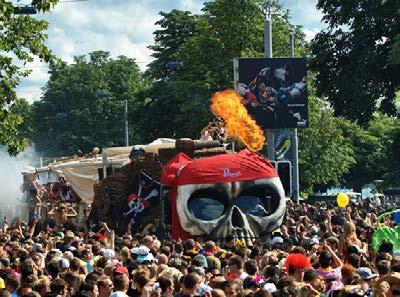
FIFA WORLD FOOTBALL MUSEUM
Get familiar with the exciting history of the most popular global sport at the first football museum in the world established by FIFA. Covering 3000 square meters, the museum collates an enormous variety of interesting and informative exhibitions. There are presentations on display by 209 FIFA member national associations. At the sport bar you can enjoy watching live streams of football matches. The FIFA World Football Museum also boasts an interactive playground where you can imitate the real football match.
 Spiegelgasse 1
Seestrasse 27
Gablerstrasse 15
Spiegelgasse 1
Seestrasse 27
Gablerstrasse 15
18 VOYAGER 5/2016 MUSEUMS / ZURICH
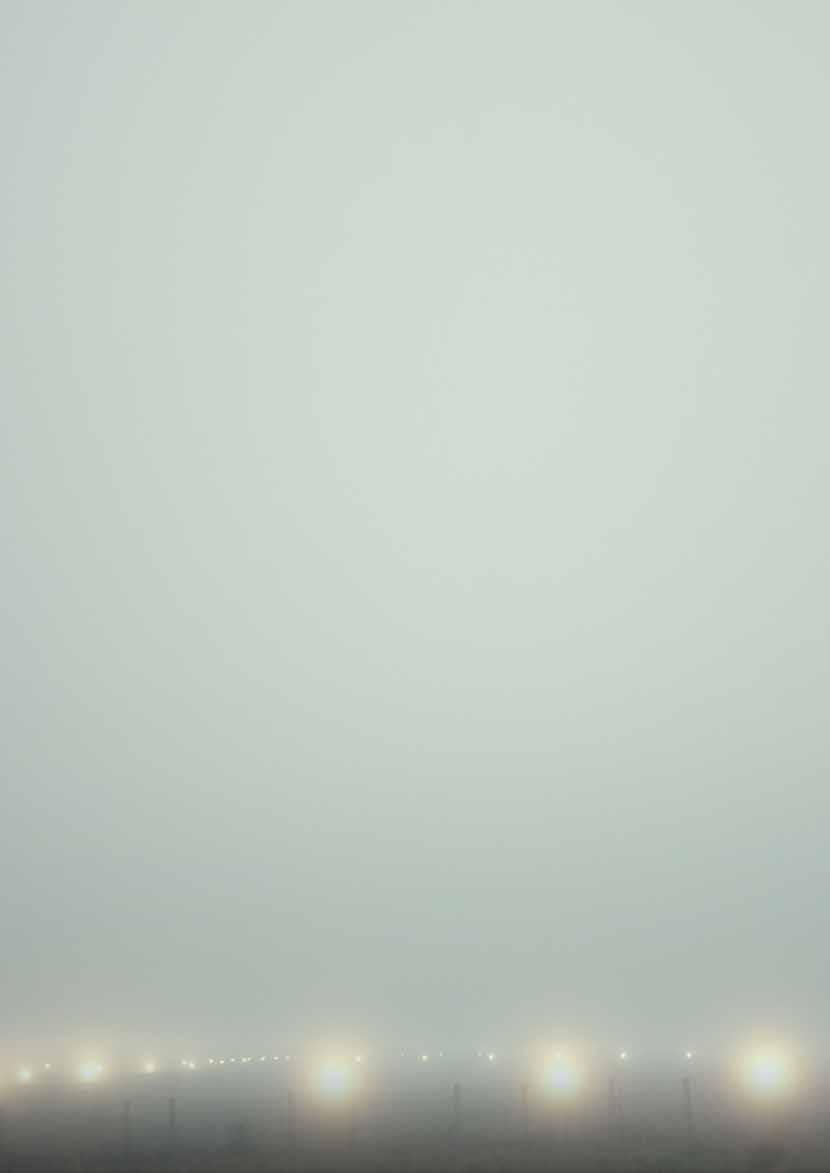
© 2015 EYGM Limited. All Rights Reserved. ED0617 Is your biggest tax obligation the one you can’t see? Taxes can quickly become prohibitive. Find out how we can help navigate your tax complexities at ey.com/tax #BetterQuestions
The Hotel Dolder Grand looks like a fairytale palace. It's a white building encrusted with towers, situated on one of Zurich’s hills overlooking the reflective surface of the lake.


THE DOLDER GRAND
The air is extra fresh around the hotel. Forest borders on the golf grounds. A new construction was recently added to the old historical building. The new wing of the hotel was designed by the architect Norman Foster. Now the guests face a dilemma: Norman Foster’s transparent, lightweight, modern design or the Dolder Grand classic rooms. The hotel is constructed to provide almost all of the rooms with an excellent views of the lake. However, we must admit that the view from the bathroom of the Foster wing is a special event and is, in fact, tantamount to the spa experience.
The Dolder Grand spa is as exclusive as the hotel itself. The spa offers every kind of body and facial procedures. Amala, Kerstin Florian and La Prairie beauty products are used here. Even if you do not plan to get a massage, the spa offers so much opportunity for peace of mind and body, that one day may not be enough.
The spa pool has a beautiful shape and imitates the flow of water: it overlooks the open terrace. A jacuzzi is also available on
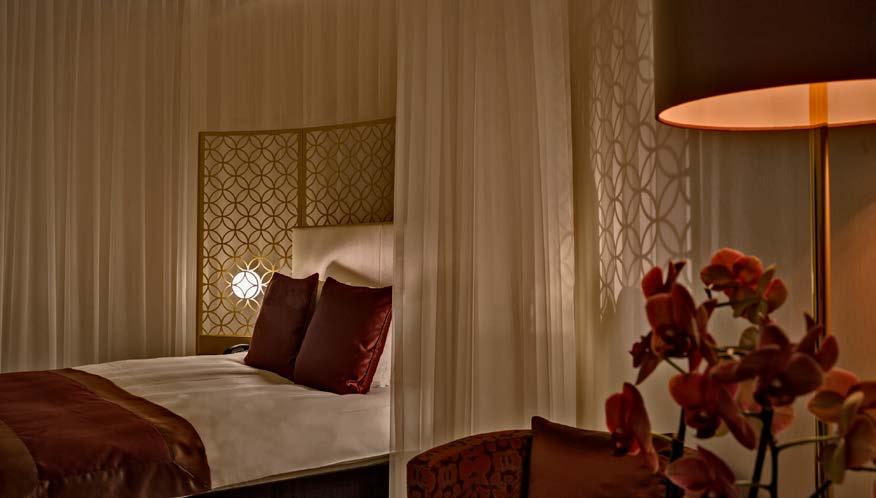
20 VOYAGER 5/2016
the terrace, right by the views of Zurich, the lake, forest and mountains. If you decide to lie in the sun, you can do so under a Fernando Botero sculpture.


One of the specialties of the Dolder Grand spa are baths full of small, smooth, black volcanic pebbles. These smooth stones are very pleasant to touch, their surface is like silk. They are specially brought from Japan, where the entire coast is dotted with the pebbles.
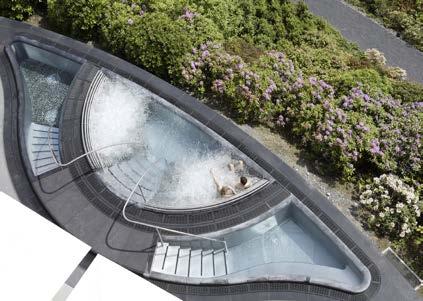
The stones are warmed up; during the procedure you can be completely immersed in their smooth structures. Aside from the tactile pleasure, the pebbles have magnetic properties and are indispensable for the treatment of many diseases such as joint and muscle pain.
The Dolder Grand Hotel offers a special individual spa package for those who do



not want to enjoy the jacuzzi and sauna in public. Couples, famous people and celebrities often appreciate this service. An assistant will lead you to a special space with a sauna, jacuzzi and massage table.
After your body is completely relaxed, it's time for restoring the spiritual equilibrium of your mind. Upon your request, an invited instructor will conduct relaxation sessions. You can also rest alone. Walking through the spiraling corridor will put you into the meditation mood. Tiles on the corridor walls gradually reduce in size and with the help of this visual effect, you may enter a pleasant trance.

21 VOYAGER 5/2016
HOTEL / SPA / ZURICH
Kurhausstrasse 65
BAUER AU LAC
Kings, presidents, archbishops, famous painters and writers have stayed at this fabulous five-star hotel located in the center of Zurich. Owned by the same family for 170 years, Bauer au Lac boasts stunning lakeside views, as well as its own private park that borders on the Swiss Alps. The Zurich business center Paradeplatz is only three minutes walk from here, and the famous shopping street Bahnhofstrasse is just a dozen meters away. Bauer au Lac is steeped in tradition whilst offering modern comforts and elegant rooms to its guests.
Nearby, Rive Gauche — a pavilion-type restaurant with a wonderful terrace — is headed by Michellin star Chef Lorain Eperon. Diners are presented with high-class dishes in a cozy and casual environment.

Rive Gauche is a perfect example of a bar and restaurant fusion where you can get to know Zurich youth alongside cosmopolitans. The food on offer is a flawless combination of Mediterranean cuisine and a modern grill-restaurant menu.
Standard double room price starts from 850 Swiss Francs.
Talstrasse 1
HOTEL ST. GOTTHARD

SCHWEIZERHOF
ZUM STORCHEN
Nobody knows how the Stork Hotel (Hotel Zum Storchen) got its name, but we do know that its the oldest hotel in Zuric, opening way back in 1357. The hotel is located in the heart of the city, nestled in the romantic square of Weinplatz and alongside the bank of the river Limmat. Hotel Zum Storchen has 66 rooms with a couple of luxury ones too. Classical furniture, warm colours and modern technologies promise guests an unforgettably cozy time. Here, you are surrounded by picturesque views of the river and over old Zurich. The hotel restaurant, Rôtisserie, is charming with a stunning terrace where you can enjoy breakfast, lunch and dinner if you so choose. As for the classic Storchen-Bar, it's believed to be the best gathering place for locals and city guests. You’ll be offered a light dinner, delicious cocktails and refreshing drinks during evening hours. Standard double room price starts from 500 Swiss Francs.
Weinplatz 2
This four-star hotel has 138 rooms and suites. Located in the heart of Zurich, at Bahnhofstrasse, Hotel St. Gotthard offers three restaurants. The Lobby Bistro serenades its guests with live piano music during the winter months under a huge glass dome. Indulge in a glass of sparkling Champagne with dinner in the charming musical atmosphere.
Alternately, the legendary Lobster and Oyster Bar (Hummer-und-Austernbar) has been offering fine fish and seafood since 1935. This is the perfect place to host a business dinner. Guests are welcome at Manzoni Bar, designed by a famous Italian coffee producer, which is a real insider tip for coffee lovers.
A standard double room will cost you 250 Swiss Francs and up.
Bahnhofstrasse 87
THE FLORHOF
A boarding house opened in 1907 and then transformed into Hotel Florhof. It's a refreshing oasis in the centre of Zurich which is extremely welcoming to guests. It's not just its illustrious history that makes this place exceptional; it's also the deep sense of tranquility, comfort and security the hotel offers its guests.
All its rooms convey the charm of bygone times. Hotel Florhof's rooms offer
The highly traditional Hotel Schweizerhof Zürich is directly opposite the main train station, right where the famous pedestrian shopping street Bahnhofstrasse starts. Just a few steps away is the smart world of exclusive shops and banks, and visitors can admire the attractive sights on the bank of the river Limmat.


Here you’ll find original but sophisticated interiors. These elegant rooms also have electrically adjustable beds and other exceptional comforts.
It's restaurant La Soupière will pamper you with French traditional cuisine of supreme quality, with specialties freshly sourced from local markets of the day. Here you’ll experience true culinary pleasures, exquisite design and a discreet atmosphere.
The price of a standard double room varies from 300 Swiss Francs.
Bahnhofplatz 7
both garden views and open out onto Zurich’s enchanting old town. The delightful restaurant spoils its guests with exquisite delicacies alongside its new lounge, garden and historic vaulted cellar. The seasonal cuisine is complemented by specially selected wines and will satisfy appetites both large and small.
The Florhof offers room with starting price of 350 Swiss Francs. 14 points Guide GaultMillau 2016.
Florhofgasse 4
22 VOYAGER 5/2016 HOTELS / ZURICH
MULTIFUNCTIONAL LIVING COMPLEX IN BAGEBI
• Apartments from 48 m²

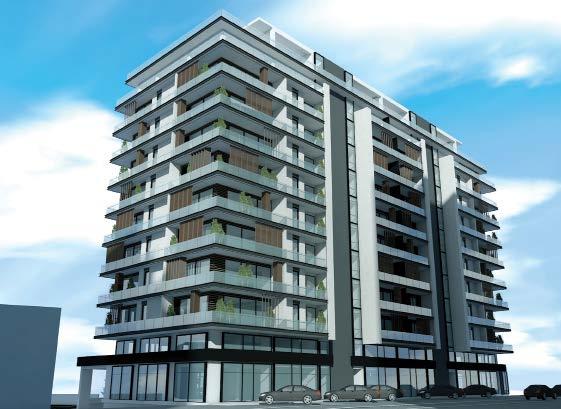
• Ecologically clean environment
• Energy efficient building materials
• External wall insulation
• Schindler glass elevators
• Green internal yard
• Football pitch
• 24h security
Tskneti Highway 15/17
TEL: +995 322 422 611
www.vivadevelopment.ge
Zurich’s restaurants are as diverse as the city itself. Creative chefs develop culinary classics and modern versions of traditional dishes, which are popular on the menus.

MESA
Diverse classical and modern dishes are paired with a large variety of rare and selected European wines. The host, Linda Milimani, has turned Mesa into a place with a naturally cozy, quiet atmosphere and the highest quality service.
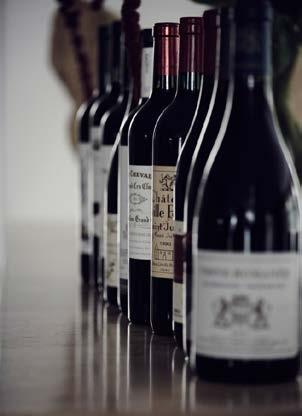
Taste homemade ravioli, spicy spinach and lobster, with green papaya and romaine lettuce sesame as an appetizer.
For the main course, try the beef Ennetbürgen with courgette, pearl onions and gnocchi.
Weinbergstrasse 75
KORNER BURGER
The local menu includes the best homemade Swiss beef burgers and a variety of 10 crafted burgers, as well as veggie or chicken burgers. Chili lovers should try the Mr Scoville burger. You may also order special dishes: wild boar, beef or venison roasted in breadcrumbs. Restaurants stands out for their bare brick walls and massive wooden furniture; two sofas are arranged along the hall to create an amazing sense of coziness. Red wines dominate the wine list and it is quite natural as most of the dishes on the menu are made of meat.
Gartenstrasse 10
KRONENHALLE
The legendary Kronenhalle was initially a gathering point for musicians, actors, writers and artists. Some paid for the bill with their own work, therefore, guests can dine and enjoy the painting of Chagall, Picasso, and Miro, displayed on the walls. French-style dishes or classic creations, such as the Zürcher Geschnetzeltes (veal stewed in its own juice) taste special in this environment.
The restaurant and bar are now recognized all over the world. Since 1924, the place has become a favorite place for friends and family to gather in Zurich. It is also used for business meetings.


Rämistrasse 4
HOLY COW
This is one of the best burger restaurants in Zurich, where the fundamental principle consists of featuring at least one type of product from each canton. The menu contains 100% Swiss beef with a variety of dishes and infinite numbers of burgers. Dishes with smoked goats cheese, mixed with honey and chili, are especially delicious.
Kanzleistrasse 15
STERNEN GRILL
This legendary bistro is known for its veal sausages and rolls. St. Gallery bratwurst and cervelat is considered a classic; you have to taste them with ketchup or mustard. You may eat there, or have the dish to go. The second floor of the restaurant is open for those who have nowhere to hurry; the menu is almost the same, though with a bigger selection of salads and garnishes.
Theaterstrasse 22
24 VOYAGER 5/2016
ZEUGHAUSKELLER
You cannot find a better place for family meals. You will taste gourmet dishes in a rural and, one might say, historic setting. The menu covers everything from meat dishes to new inventions of Swiss cuisine. However, tradition is respected and the secrets of some recipes are passed on from generation to generation. In short, these ancient walls provide a distinctive gastronomic experience. It should be noted, also, that the menu does not include raclette or fondue, however, in has no equal in Zurich-style meat. The baked pork legs and so-called rösti are absolutely delicious. Reservations are essential otherwise will leave hungry.
Bahnhof strasse 28A, Beim Paradeplatz
SWISS CHUCHI
Chuchichäschtli is the most difficult word to pronounce in the Swiss-German subdialect. What does it mean? We recommend visiting this Swiss Chuchi restaurant to find out.
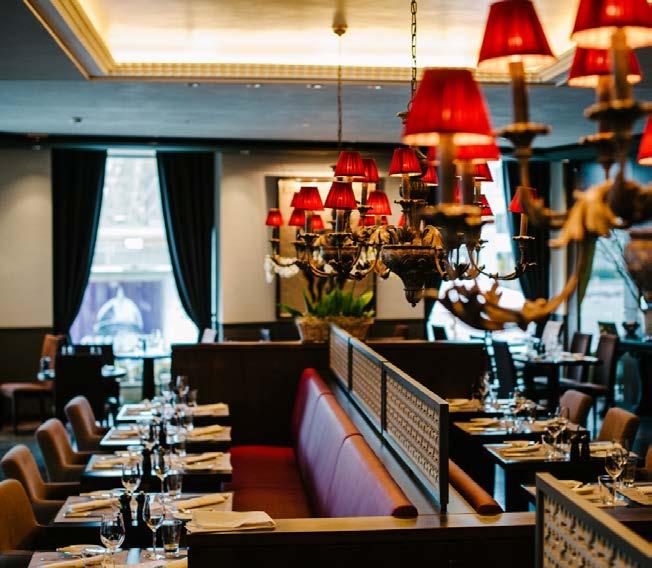
Chuchiо means "kitchen”; the restaurant is located in the hotel “Adler” and became famous for traditional Swiss cuisine. Swiss Chuchi is gladly visited by both local residents and tourists. It offers an excellent “Adler” fondue and raclette, not to mention the alpine macaroni and Zurich-style veal. The “Adler” fondue and crackling Rösti are simply unrivaled. The tables are always busy and you need to make a reservation.
A meat entrée will cost you up to 40 CHF; a raclette 2537 CHF.
Hotel Adler, Rosengasse 10
BRASSERIE SCHILLER
This place stands out for its class and classicism. It is the best choice for those who want to impress their business partners. This historic building was home to one of the leading newspaper publishing companies. Today it is a modern restaurant. It attracts visitors and guests who like to stay up late on Sunday evenings with its classic cuisine.
Sechseläutenplatz 10
SALA OF TOKYO
Everything here is saturated with Japanese magic: the dishes are seasonally prepared and fantastically decorated.

Limmatstrasse 29
SWISSALPECHUCHI
This seemingly simple rural basement wine cellar brings the Swiss mountains fragrance to your plate! Eight different types of cheese fondues are offered while the meat is grilled on hot stones.
If you wish, you may try classic dishes : sausage with garlic sauce, and Bauernbratwurst or Geschnetzeltes – Zurich-style roasted veal.
Zähringerstrasse 21
FONDUE HOUSE/ PinteVaudoise
This restaurant is known throughout the city for the best fondue in Zurich and other delicacies made from Swiss cheese.


Kruggasse 4

25 VOYAGER 5/2016 RESTAURANTS / ZURICH
TAO
Tao restaurant is a real oasis of peace in the heart of the business district due to its Chinese Garden and sophisticated interior. Its Euro-Asian cuisine menu includes a variety of dishes and, among them, a variety of Chinese Tao burgers and dumplings.
A garden, bar and restaurant are at guests' disposal. The bar is crowded in the evenings because many visit it for the special "Tao" cocktails.
Augustinergasse 3
RISTORANTE ORSINI
This Italian restaurant is a sort of Savoy Bauren Villе, with the unforgettable smell of Tuscany; any dish you taste here is an unforgettable lifetime experience.
Poststrasse 12
LE POISSON
This restaurant has been considered Zurich’s special place for many years. You’re offered traditional local fish and meat dishes. Many of them are promptly grilled in front of you.
Claridenstrasse 30
CHÄSALP
The restaurant is located on a hilltop overlooking the Zuurberg Mountain and boasts a cozy atmosphere. The menu offers a wide variety of cheese, as well as various types of pasta dishes and fondue. Enjoy the fabulous view of the garden in good weather.

The restaurant is only open on Sundays and holidays; appetizers cost 10-19 CHF, raclette 36 CHF, fondue 36 CHF.
Tobelhofstrasse 236
SPICE
This modern, stylish restaurant has been awarded Michelin stars and 15 GAULT MILLAU points thanks to the menu, which successfully combines different cuisines from several countries and offers a bouquet of extremely fine taste.
The experimental approach, healthy dishes and variety of signature dishes attracts a number of visitors.
Germaniastrasse 99 RIVE GAUCHE
Zurich’s downtown restaurant Rive Gauche is the best place to bring guests to observe the local youth and their lifestyle.
Chef Olivier Rais and his team of chefs have worked hard to prepare meat or fish with their unrivaled mastery; they take into account vegetarian preferences as well.
Talstrasse 1
BAUR AT THE SAVOY
The Savoy Restaurant is particularly attractive as it is located at the heart of the Swiss financial center.



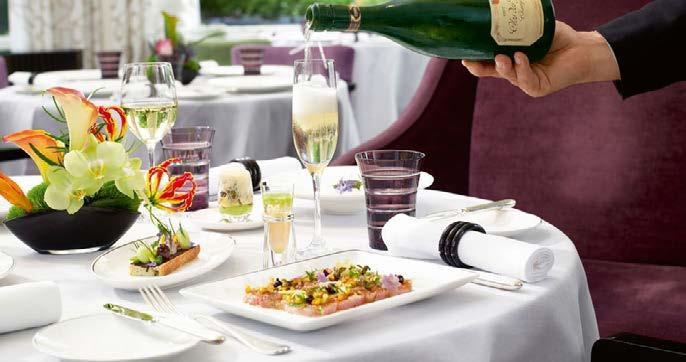
The menu is a perfect example of tradition and constant innovation, and, in general, is a crossing point for business and pleasure.
Poststrasse 12
26 VOYAGER 5/2016 RESTAURANTS / ZURICH

ZURICH HAS THE MOST DIVERSE NIGHTLIFE IN SWITZERLAND. THERE ARE A LOT OF UNIQUE BARS AND CLUBS HERE, SOME OF WHICH ARE EVEN FAMOUS OUTSIDE THE COUNTRY.
IN GENERAL, ZURICH IS THE PERFECT PLACE FOR NIGHTLIFE LOVERS, AS WELL AS FOR CLUBBERS.
MANY DIFFERENT TYPES OF BARS SATISFY THEIR TASTES AND DESIRES, AND EVERYONE CAN FIND GREAT ENTERTAINMENT, BE IT COCKTAILS, WHISKEY, GIN SIPPING, KARAOKE, CONCERTS OR EVEN A PUBLIC READING. SMOKING IS PROHIBITED EVERYWHERE, BUT MANY BARS AND CLUBS OFFER FUMOIRS (SPECIAL ROOMS FOR SMOKERS).

RAZZIA & CO
Razzia has a rich history. It was built in the 1920s in a neoclassical style. The first movie theater in Zurich opened here. Since 2007, it has been transformed into one of the most fashionable event halls.

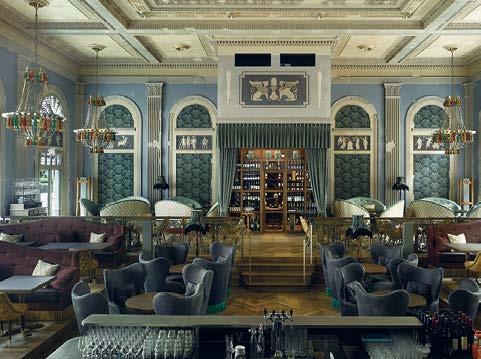
Seefeldstrasse 82
ODEON
This is indeed a historic venue. Anyone who visits Odeon probably thinks:
“Einstein might have thought a lot about the theory of relativity here, while Somerset Maugham maybe drafted a short story or even a new novel”. Dadaism was born within these walls, and this was the first place that served champagne by glass.
Limmatquai 2
WIDDER BAR
Aside from dinner and drinks, you can enjoy concerts or browse through the rare book collection.
Widder Bar stands out due to its drinks and cocktails. Jazz evenings are held once every two weeks, on Tuesdays. You can taste rare drinks that are not served elsewhere – delicious cocktails or wonderful wine – accompanied by jazz music.
The first bar manager Dirk Heine’s cucumber, mustard and vodka cocktails are believed to be a wonder.
Rennweg 7
GEORGE BAR & GRILL
George has become a favorite gathering place for businessmen and locals alike in Zurich. The black-and-white floor is furnished with typical 1950s colorful chairs, and everything glows strangely under the neon lights.

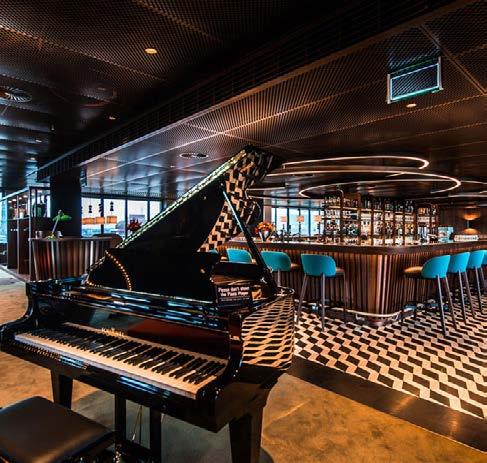
You can spend the whole night here, in the restaurant or the small dance hall. The terrace is open in the summer, and although free space is always hard to find, it offers an amazing view of the city. A highly varied musical offering, ranging from jazz to the Ibiza style, is featured. This bar is the right choice for all-night entertainment lovers.
Sihlstrasse 50
KAUFLEUTEN
This 100-year old building holds a diverse world of gastronomy, night life and cultural diversity.
The legendary nightclub restaurant serves global cuisine.
The lounge offers deftly mixed drinks, while the Pelikanbar serves fragrant morning coffee; you can also try a light lunch at noon and drink cold beer in the evening.
28 VOYAGER 5/2016
Pelikanplatz
BARS / CLUBS / ZURICH
IN SHORT, EVERYONE HEREFEELSRIGHT AT HOME, DESPITE THE DIVERSE SOCIETY.

GRIEDER
Grieder Bongénie became famous for its fashionable clothing more than a hundred years ago. The selection is really diverse: clothes, furs, accessories, jewelry, and shoes. This used to be the best-known textile trading facility and now features worldknown designer creations on display. Visitors may enjoy an open terrace lounge bar which offers a wonderful view of Zurich. The bar has become a favorite place for relaxation for the locals since it offers the lightest and most delicious dishes that satisfy even the most capricious gourmands.
Bahnhofstrasse 30
JELMOLI
Jelmoli opened in 1899, after the Paris and London model; it is the best fashion house in town. It carries high-quality brand products for women, men and children. In addition to the best fragrances, you can buy clothes, accessories, and shoes here too. A well-known food department is located on the first floor, offering the best Swiss cheese, as well as a rich variety of wine and food; it is also open for lunch.
Seidengasse 1
BALLY
The Bally brand was founded by brothers Karl and Fritz Bally in 1851; they opened their own shoe factory. Bally shoes stood out from the very beginning due to their high quality and original design, which turned Bally into a cult brand. The firm started offering a wide variety of clothes, bags and leather accessories in the 1970. Bally products are fully compliant with the expression: “true Swiss quality". The brand’s trademark is a red and white ribbon, as a symbol of the Swiss flag.

We recommend buying Bally travel bags of exceptional quality and their very comfortable shoes.


Bahnhofstrasse 20
MOHO
Moho offers interesting items for women. It carries a wide selection of wooden clutches, scarves and hair pins. Hair pin quality (material, stone, pearl) is quite high. It also offers high quality accessories.
Strehhlgasse 13
OSSWALD PARFÜMERIE
GLOBUS
You will encounter a newly-founded shopping center in the biggest city in Switzerland. Shopping here is unforgettable. Everything is done to pleasantly surprise the customers: the wellknown brands are arranged with taste and knowledge.
Schweizergasse 11
This perfume house has been serving clients with care and knowledge for 90 years now. It offers the highest quality cosmetic products, rare perfumes, fashion accessories and even jewelry.
The local beauty spa is also one of the most distinguished in Zurich. La Mer, La Prairies and Shirley have their own rooms here.
Here you can buy unique brands, such as: Roja, M. Micallef, Chabaud –perfumes created especially for the Osswald house.
Bahnhofstrasse 17, Paradeplatz
30 VOYAGER 5/2016
PANTA RHEI
This elegant fashion boutique is located next to the popular chap é terrasse, featuring mainly women's clothes and accessories. Famous brand products are sold here.
Limmaquai 1
FABRIC FRONTLINE
Precious silk fabrics, woven scarves, handkerchiefs, cravats and such are sold here.
Silk was valued in Zurich as early as the Middle Ages, and silk production became traditional in the 1980 and made Fabric Frontline part of the high-fashion world. The silks created here stand out for their colorful abstract designs and many famous consumers buy them, such as Vivienne Westwood, Nina Ricci and Olivier Theyskens.
Ankerstrasse 118
DOMEISEN
Visit Domeisen if you are looking for high-class, elegant jewelry. The store uses only selected precious stones for its jewelry. Every item is unique.
In gassen 7
ZIGARREN DÜRR
You may taste cigars in the Davidoff Cigar Lounge, where eight people can rest and enjoy excellent tobacco flavors.
The building stands out for to its original glass façade, while the interior offers a wide selection of the highest quality cigars from around the world.
The exhibited products have long been establishing their own standards for tobacco.
Bahnhofsplatz
FATMA TURK
Fatma Turk is an exciting women's clothing store; it offers trendy clothing and a pleasant environment. It is difficult to find extravagant clothing in Switzerland and this store offers different styles.

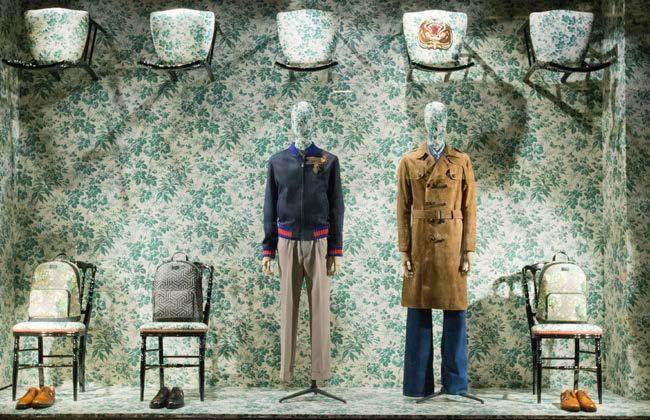
In gassen 14
KOENIG
If you are interested in high-quality diamonds and precious stones and would like the services of a private jeweler, then this is the store for you.
Many kinds of jewelry are created here. These products are marked for their high quality and unique design.

In gassen 9
LOCO D’ORO
Loco d'Oro sells original men’s jewelry. Massive and elegant silver and black gold rings will interest men; however, women can select from its the jewelry as well, such as enamel rings. This is a jewelry shop as well, so there will be no problems adjusting rings.
Munstergasse 13
PECLARD
Come to the Peclard store if you are looking for minimalist modern jewelry. There is a wide variety of jewelry in silver and gold.
Strehjgasse 33 Munsterhof 8
WOODMONKEY
Woodmonkey is the place where novelty, originality and taste-seekers will definitely find something.
Geroldstrasse 23
GÖTTE OPTIK
Götte has offered the highest quality glasses to its clients since 1922. Experienced specialists will help you frame glasses; moreover, the brand selection is diverse, offering: Cartier, Chanel, Maybach, Paul Smith and Zuerihor. Götte also creates its own glasses. Here you may have a test, repair a damaged frame and have a specialist make a house call.
Here are some of the exclusive brands:
THIERRY LASRY
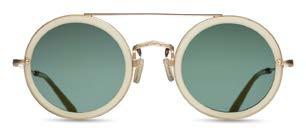
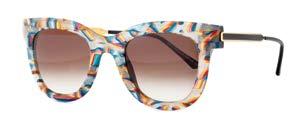
Thierry Lasry’s unique sunglasses really stand out from all of the others; it is almost obligatory to wear them in Hollywood.
MATSUDA
Matsuda blends the Japanese tradition of craftsmanship with fashion intuition seamlessly; the brand is a hallmark of a true retro style, as well as fine glasses frames.
31 VOYAGER 5/2016 SHOPPING / ZURICH
HANGARNTER
Visit Hangarnter if you wish to buy classic, body-fitting men’s clothing. This classic tailoring salon-shop offers a high-class service to its clients.
The center of Zurich houses many art galleries that trade modern and classic works and antiquities. Galerie Helvetia offers graphic works, paintings and modern prints.
In Gassen 11
GALERIE HELVETIA
The center of Zurich houses many art galleries that trade modern and classic works and antiquities.
Galerie Helvetia offers graphic works, paintings and modern prints.
Munstergasse 10
GALERIE ALEXANDER E. RABER
Alexander E. Raber sells upscale artwork. Here you will find paintings, sculptures, graphics, gravures, and prints.
Alexander E. Raber supplies hotels and private collectors with high-class art, though individuals can buy art in the gallery as well.
Oberdorfstrasse 21/23
VESTIBULE
Visitors come to this hospitable environment to select wellknown brands to their own taste: Phillip Lim, Chloé, Isabel Marant, Nina Ricci, Alexander Wang, Marc, R13, Forte Forte, Phillip Lim da others..
St. Peterstrasse 20; Seefeldstrasse 56
ZSUZSANNA LANDORLF
Zsuzsanna Landorlf stands out among the many up-market shops on Rennweg Street. The most beautiful walking sticks are sold here. Although this extravagant accessory is not so popular, you may appreciate their diversity and beauty from a decorative point of view.
You may also purchase jewelry and watches here. The store also sells jewelry boxes, which are as beautiful as the high-quality canes.
Rennweg 201
FRANZ CARL WEBER
This shop is a paradise for children of any age. The building has been a synonym for fun, diversity, high quality and good service for 130 years. Here, in Switzerland, you can find the longest ball trail, a dragon-shaped slide, a bubble corner and many other entertainments. Due to the host’s boundless imagination, the impression is unforgettable, not only for children.
Bahnhofstrasse 62 Rennweg 43
FIDELIO
The most populous center of fashion in Zurich combines modern and experimental trends. Anyone can improve their own style in the cozy environment of this boutique.

Nüschelerstrasse 30
WOODMONKEY
Woodmonkey offers trendy young people works of famous or yet-to-becomefamous designer clothes daily. This store is unusual for the fashion world - the place where anyone looking for novelty, singular and tasteful items will definitely find something.

Geroldstrasse 23
BOUTIQUE ROMA
Boutique Roma can be described as a store that carries incomparable style, distinctive brands and collections. At a time when the rest of the world takes the path of mass production and industrialization, Roma remains faithful to its vision.
International avant-garde designers, such as Rick Owens, Ann Demeulemeester, Dries Van Noten and others are available here. Roma creates extremely fine clothing and women’s and men’s shoes. Traditional craftsmanship, high quality materials and hand stitching are still valued above everything else here.
Pelikanstrasse 6/8
32 VOYAGER 5/2016
NIEDERDORFMARKET
Zurich's oldest Christmas market is a whole world in itself. The shopping stalls are placed along the Neiderdorstrasse.
Visiting the market in the run up to Christmas is a must-do for any tourist, even just to browse and taste the mulled wine.
This Christmas market begins at the end of November and lasts through to December 24.
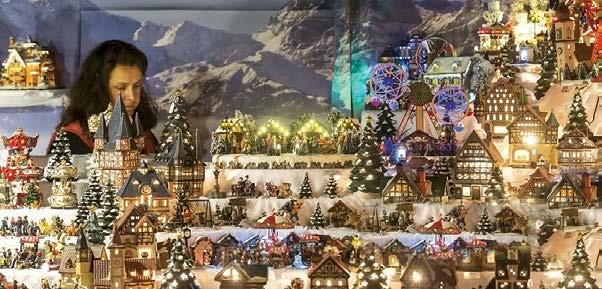

HAUPTBAHNHOFMARKET
This market is located at Zurich’s main railroad station. Here you can taste delicious culinary produce, find healthy, fresh vegetables and, in general, everything that you need to prepare delicious dishes.

Open on Wednesdays, 10: 00 to 20:00.
VICTORINOX
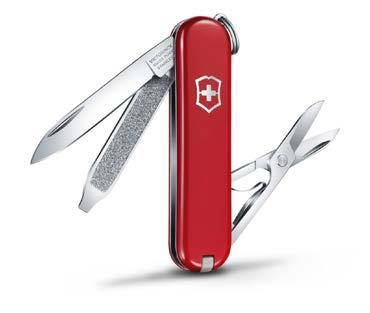
A Swiss knife with a twoedged mouth is a cult object, created by the engineer Karl Elsener in 1897 us.
The firm Victorinox produces tens of thousands of knives annually.
MAX AFFOLTER
A cuckoo clock is a traditional Swiss souvenir to take home. Everyone remembers from their childhood a small wooden houses with tiny doors and birds that peek through them once every hour.

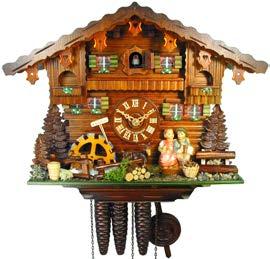
Switzerland has traditionally produced these clocks and is still engaged in their production.
BOOKBINDERS DESIGN

You may acquire them in the Max Affolter store.
Strehlgasse 25
ROSENHOF MARKET
Rozenhop market features not only foreign items that are brought from the other countries but also local products made by Swiss craftsmen. Many items are displayed on the store shelves: clothing, jewelry, semi-precious gems, leather, clay products, a variety of spices and antiques.
Open from March to October, Thursdays, 10: 00 to 20:00 and on Saturdays from 10: 00 to 17:00.
Visit this store if you particularly like stationery. It is impossible to leave this high-class place empty-handed. It features paper albums, notebooks, pencils, pens, typewriters and rulers of unique beauty and quality.
You may also buy coloring pencils and other school supplies for children.
Oberdorfstrasse 34
SWISS INSPIRATIONS
Here you can find the highest quality products such as rare souvenirs, jewelry, handmade items and even baby toys. Desserts and cosmetics are sold here as well. In short, Swiss Inspirations offers a diverse selection of completely different goods, and all of the items are made in Switzerland.
Niederdorfstrasse 90

33 VOYAGER 5/2016 FAIRS / SOUVENIRS / ZURICH
SPRÜNGLI
The pastry shop “Sprüngli” has played an important role in Swiss chocolate production since 1836.


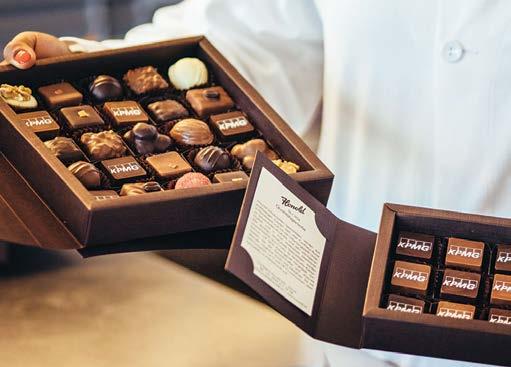
Every dessert in this shop, including Almond Cake Luxemburgerli, truffles and different types of chocolate is completely hand-made from the fresh ingredients.
Though “Sprüngli” is located in every large city, the Zurich classic café-salon is truly wonderful. It is the best place for breakfast and delicious cakes.
Cream, butter and milk are all produced in Zurich. Whether you love white or dark chocolate, with or without nuts, truffles or grillage or just traditional chocolate, “Sprüngli” confiserie will satisfy you.

Bahnhofstrasse 21
HONOLD
Honold confectionary was opened in 1905 in the Bahnhofstrasse vicinity. It produces chocolate, pastry and a variety of desserts.
You can taste desserts on the first floor balcony cafe-bar “Honold” and observe the busy shops and street life below.
A FAMOUS HONOLD CHOCOLATE CAKE IS MIXED WITH FRUITS, OATMEAL FLAKES AND YOGURT.


LUXEMBURGERLI
WONDERFULLY LIGHT TEMPTATION!
This delicious almond cake is prepared using only the highest quality natural raw materials, which is why “Sprüngli” Luxemburgerli has an unrivaled, fresh flavor.
This dessert includes vanilla, chocolate, champagne, currants, lemon and pistachio nuts, and more and more new ingredients are added to the mixture.
Luxemburgerli is known as “confiserie Sprüngli” in Switzerland, and abroad. It is a “Sprüngli” protected brand.
Bahnhofstrasse 21
The confectionary and cafe offers delicious muesli, though they are primarily known for the amazing nougat in milk chocolate.
Rennweg 53
LÄDERACH
If you want to witness the real Swiss chocolate manufacturing, visit the Laderach shop, where the best chocolate is made using traditional methods; you will be offered a number of original gifts as well.

You may also try an exceptionally tasty fruit ice cream.
Bahnhofstrasse 106
SAY CHOCOLATE
Order a chocolate set of your liking in this boutique, whether it is 65% dark chocolate from the Maracaibo or Swiss milky chocolate.
Here you can select other desserts made of the best cocoa, with fruity aromas or any other blend.
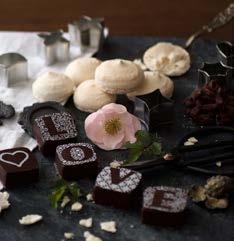
Lagerstrasse 28

34 VOYAGER 5/2016
New York Times
TEUSCHER
“Teuscher” confectionary has been producing desserts from the best raw materials around the world for 70 years. These chocolates and truffles are free from chemical preservatives or additives and are praised by experts and gourmands.


This is only one part of the Teuscher production, a number of cakes and pastries are made here as well. Handmade desserts are made from the fresh ingredients on a weekly basis and immediately sent to Europe, the US, Canada, Asia or the Middle East.
Storchengasse 9
TRY THE CHAMPAGNE TRUFFLES THAT MADE THIS CONFECTIONERY SHOP FAMOUS; THE DIVERSE SELECTION INCLUDES DIFFERENT SIZES AND FLAVORS, INCLUDING UNIQUE TRUFFLES WITH A ROSE FLAVOR.
THE SWISS LEAD IN CHOCOLATE CONSUMPTION: THEY EAT 12 KILOS OF CHOCOLATE ANNUALLY

18 LEADING CHOCOLATE FACTORIES PRODUCE 200,000 TONS OF CHOCOLATE ANNUALLY, OF WHICH 6 0% IS EXPORTED.
MAX CHOCOLATIER
The high quality and exquisite taste of this chocolate or other desserts is very distinguished.
The choice is really diverse: dragées, truffles, chocolate bars of various shapes, hot chocolate, pastries and different snacks.
Theaterstrasse 12
H. SCHWARZENBACH
Recommendation
Would you like to buy delicacies as gifts? Then you won’t find a better store in Zurich than “H. Schwarzenbach”. It has been supplying Zurich dwellers with is astonishing quality tea, coffee, chocolate and spices since 1864.

It also features the best produce from all over the world, rare and high-quality organic rice, nuts, citrons, fruit, and honey.
You can taste the showcased delicious coffee or tea with an assortment of desserts and cookies.
Munstergasse 19
PECLARD
Despite the fact that cafe “Peclard” is located on one of the main tourist streets in Zurich, it has not lost its historic charm.
Excellent rolls and fruit tarts are baked here and it is a great breakfast place. The café offers a beautiful terrace, which overlooks the street, but nothing beats sitting down in the courtyard.
These small hidden courtyards are a typical Zurich phenomenon.
It is as if time has stopped in this nice little café, making you appreciate its passage. You will be tempted by the hand-made chocolate, pastry and other special treats…

you can acquire this deliciousness over a 19th-century counter.
Napfgasse 4
"Most experts believe that“Teuscher”is the best in the world."
35 VOYAGER 5/2016 PASTRY / ZURICH
MAILENDERLI
Mailenderli stands out among the classic Swiss Christmas cakes. This pastry became famous 600 years ago when the Confederation sent an ambassador to Lombardy, where he presented the tiny cakes to the Duke. Catherine Medici, the future queen of France, tasted Mailenderli in Florence and was very impressed. Since then, the Swiss have called it Milane or Milanezini (small Milanese).
CHERRY CAKE
Pastry chef Heinrich Höhn invented cherry cake in 1921. It is made of almond meringue, cherry syrup, moist dough and cream. The confiserie “Speck” in the canton of Zug still prepares it according to traditional recipes.
Its surface is decorated with snowy sugar powder, shining like a diamond, and with a whole circle of roasted almonds.

In March 2015, Zug cherry cake was granted protected product status according to its origin.

LECKERLI BISCUITS
This pastry has a long and rich history and is associated with the Christmas holidays in Switzerland. Although its culinary ancestor is a German dessert, this fragrant biscuit, or to be more precise, gingerbread, has been enjoyed with nuts in Bern, capital of Switzerland. You have to try Leckerli pastry. It is better to dip it in tea before biting a piece off.
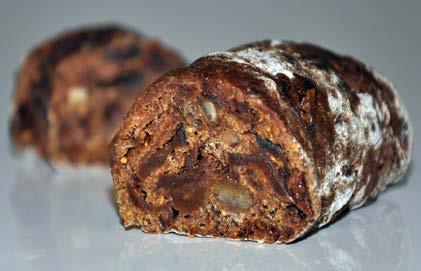
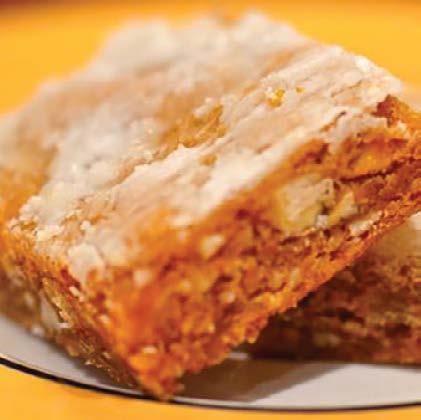
MERINGUE

Meringue is enjoyed everywhere is Switzerland. It is believed that it was first baked in the small town of Meiringen (by the way, Sherlock Holmes and Professor Moriarty fought each other in the vicinity of this city, in the Conan Doyle story).
GLARNER FRUCHTEBROT IS BAKED FOR SOME OF THE FESTIVALS LIKE ST. NICHOLAS DAY. THE FILLING IS MADE OF APPLES, PEARS, DRIED PLUMS, RAISINS, WALNUTS AND A CHERRY INFUSION.
BASEL BROWNIE

This excellent desert owes its distinctive taste mainly to the high quality of the Swiss chocolate used. At first glance, the recipe is nothing special: flour, sugar, butter, and so on. However, due to the virtues of the chocolate, Basel Brownies can contribute to any festive table
MUESLI
Aside from fondue and milk chocolate, Switzerland has added another wonderful thing to the world--healthy breakfasts. So healthy that you may not want to try what looks like cold porridge!
Let’s keep this between us, but Muesli can indeed be considered a porridge, especially if it is prepared the Swiss way. The Swiss place the flakes in milk overnight, then mix in yogurt and fresh fruit (berries or apples). The result looks a little bit strange but tastes wonderful.

36 VOYAGER 5/2016
PASTRY

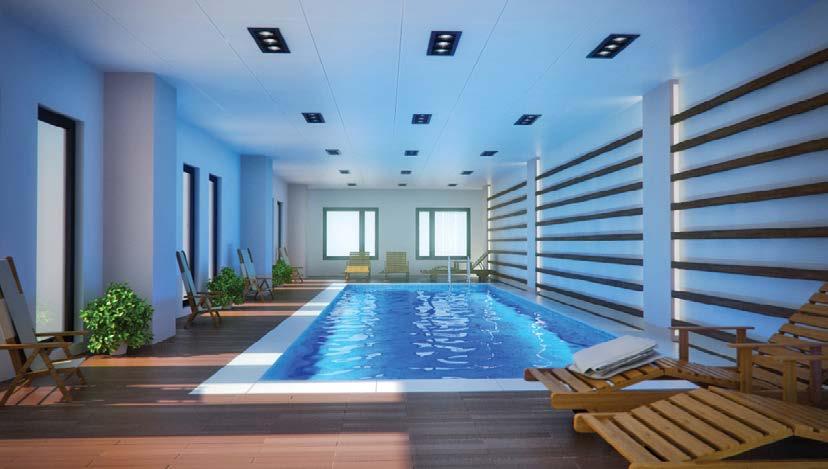


#37 Chavchavadze Ave ARCHI TOWER Fully renovated apar tments • Concierge-ser vice • Underground park ing • Pool, gym and sauna for residents • + 995 32 2 602 602 ww w. archi.ge Completion date: Dec. 2016
BASEL IS ON THE RHINE, TOWARDS THE NORTHERN SWISS BORDER AND IS CALLED "THE CULTURAL CAPITAL". IT HAS WORLDCLASS MUSEUMS AND AN OLD CITY CENTER, AND IS THE THIRD LARGEST CITY IN THE COUNTRY. THE CITY IS LOCATED WITHIN THE SWISS, FRENCH AND GERMAN BORDERS, AND ITS HISTORIC MONUMENTS, STATUES AND MODERN BUILDINGS BY RENOWNED ARCHITECTS CREATE AN ECLECTIC ATMOSPHERE.
BASEL


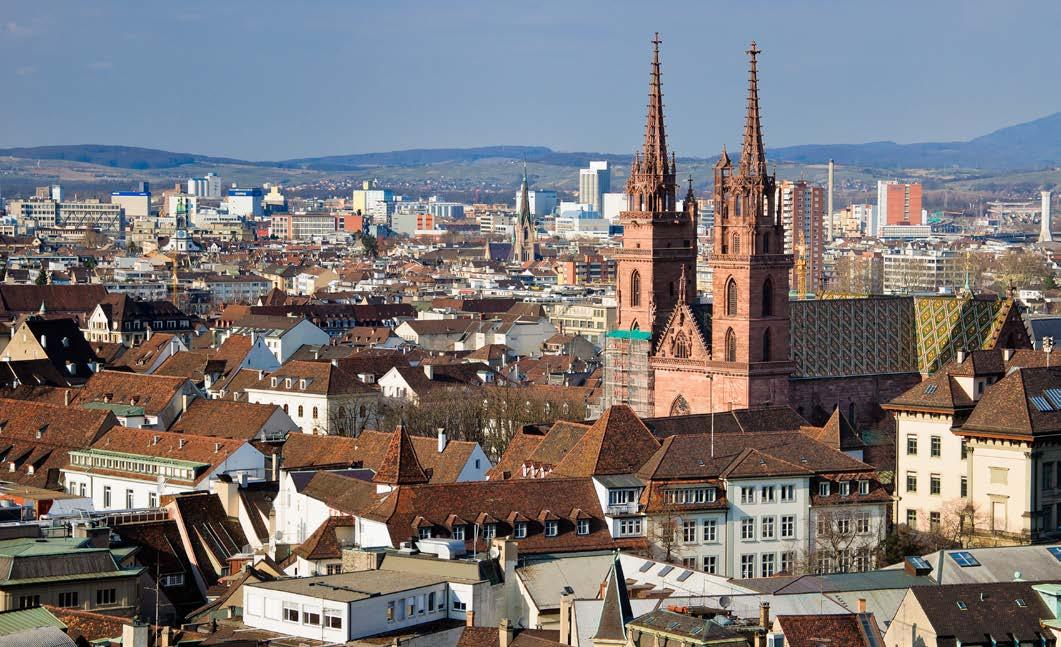
The Romans founded the city in the medieval period, transforming it into a center for education, art and industry. In the 15th century, the University of Basel, the first Swiss university, was founded, where the humanist Erasmus of Rotterdam taught for a long time. Currently the pharmaceutical and chemical industries are the leading fields there, but modern Basel is truly a cultural oasis. If you manage to feel the spirit of Basel, you will polish all your five senses. The meeting point of three countries gives its citizens a sense of the good life. Excellent cuisine is as important as the arts and culture.
Basel is the heart of Europe. You can mark Basel as a starting point of your travel in Europe or Switzerland. It will take you less than an hour to get to Bern, Zurich or Lucerne, as well as Strasbourg, Colmar, and Freiburg am Breisgau. Basel is very close to the Black Forest and Alsace, and reaching mountainous ski resorts will take you a bit more than an hour. The city is fairly easy to reach from any part of the world.
BASEL TOWN HALL (RATHAUS) - the town hall, which was built in the late Gothic style, can be distinguished from other buildings in the background by its red color. It was built in 1504-1514, after Basel joined the Swiss Confederation. In 1608, a new office was added to the building on the northern side. The town hall was painted by Hans Boc by that time. The entrance of the Rathaus is decorated by the coat of arms and other ornaments. The sculpture of the founder of Basel stands inside the courtyard of the city hall. It was created in the 16 th century.
SWIM IN RHEINE
The Rhine is not only a navigable trade route, but also a place of relaxation. It significantly affects the environment and people, offering them a way of life that makes Basel proud and attracts locals and visitors alike – it is a place for relaxing on the beach with a mild climate and the sun.

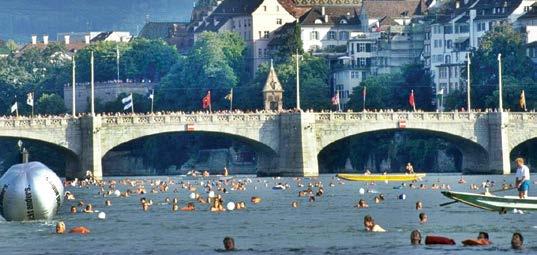
38 VOYAGER 5/2016
MÜNSTER
The city’s main landmark is a cathedral, built in the 11th century. The church has been rebuilt many times and has a Gothic and Romanesque interior facade. Renaissance humanist Erasmus Rotterdam is buried here. The main facade is characterized by sculptural diversity, while the west facade (Galluspforte – entering of Galls) is decorated with Swiss Romanesque statues.
MÜNSTERSCHATZ
For 500 years the cathedral kept treasures, relics and sacred vessels. The oldest items date from the first century. The cathedral also preserves parts of the saints. The treasury survived the vandalism of iconoclasm in 1529. In 1833, when the canton of Basel was separated from Baselland, the city was given only a part of the treasury, the other part was sold at auction for economic reasons and is now kept in museums in Munich, Britain, Amsterdam and other cities.
KUNSTMUSEUM
Basel Museum of art contains collections from two periods: the Middle Ages (1400-1600 AD.) and the new era (1800-present).
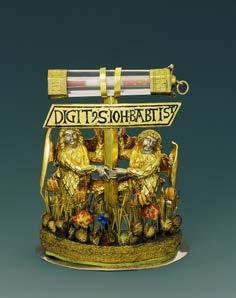
The first exhibition presents the largest collection of works by Hans Holbein, and the second a large display of Impressionists, where you will find works by Picasso, Rodin, Gauguin, Renoir, Van Gogh and other famous masters.
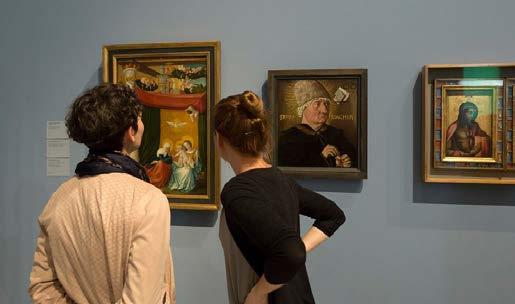

St. Alban-Graben 16
BASELWORLD

Baselworld is universally recognised as the most important marketplace and trendsetting event for the world's watch and jewellery industry. Next show: March 23 - 30, 2017.
MUSEUM JEAN TINGUELY
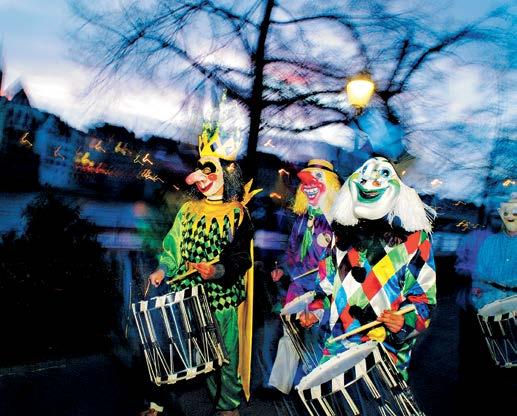
The museum was designed by famous Ticino architect, Mario Botta. Inside, you will find Jean Tinguely’s (19251991) most unusual, fun "kinetic sculptures". One of his mechanical masterpieces adorns the lake of Zurich, while the rest are in the Basel Museum.

ENTRY COSTS 10 SWISS FRANCS FOR ADULTS AND 7 FRANCS FOR THE ELDERLY AND STUDENTS. THE MUSEUM IS OPEN FROM TUESDAY THROUGH SUNDAY (11:00-19:00)

Paul Sacher Anlage 1
OLD AND NEW BASEL SHINES WITH ILLUMINATED WINDOWS, DECORATED FACADES, GARLANDS, AND BEAUTIFUL CHRISTMAS TREES. YOU CAN FIND A DISTINCTIVE ATMOSPHERE IN THE CITY CENTER, WHERE THE CHRISTMAS MARKET STRETCHES TO MORE THAN 100 BOOTHS AND DESKS.
FONDATION BEYELER
At first it was a private collection of Hilde and Ernst Beyelers. Now the Museum is located in the light Italian-style building, designed by the architect Renzo Piano. The exhibition displays sculptures by Joan Miro and Max Ernst, as well as old family statues, and the walls of the museum are decorated by paintings by artists from the 19th and 20th centuries. The museum is open every day (10:0018:00) and on Wednesdays until 20:00.Tickets cost 21 Swiss francs for adults and 10 francs for children.
Baselstrasse 101
39 VOYAGER 5/2016 MUSEUMS / BASEL
Even on your very first glance of the restaurant you will feel a sense of loftiness from this multi-floor hall with the space filled with refined luxury. Les Trois Rois is both cult and culture. You’ll be lucky to get a place near the windows to enjoy the views of the Rhine.
A glass of champagne before dinner will guarantee a pleasant mood (Maison Ruinart, 19 FR). The richly varied and color-



ful menu bears witness to the efforts of Chef de Cuisine Pablo Löhle. A business lunch will cost you 47 CHF; a regular lunch 79 CHF.
You may enjoy your appetizers at the exclusive bar snugged up in a comfortable chesterfield couch.

Blumentrain 8 www.lestroisrois.com
STORCHEN
This petite hotel and restaurant is located in Schmidhofen, close to Baden. The proud owner of a Michelin star, it offers regional specialties to its guests, along with classic haute cuisine. Minced bull’s tail and calf-head salad or Baden Hechtklösschen are this venue’s most memorable dishes.
The restaurant offers fresh ingredients chosen with great care for their supreme quality and inimitable taste. The white wine selection features Markgraeflerland or Breisgrau; summer red wines and other varieties of regional wine promise you new flavors.
 Felix und Nabor Straße 2 Bad Krozingen-Schmidhofen
Felix und Nabor Straße 2 Bad Krozingen-Schmidhofen
195 CHF. “Making dishes is our hobby, we want to delight you and wake up your cravings for our restaurant”- writes Chef Erik Schröter in Michelin Guide. A varied menu for each season will astonish you.
Surprise yourself with flavorsome sparkling wine (Grand cru Brut, 19 CHF) and for dinner choose whatever you fancy from the magnificent selection of wines. You can get familiar with and sample 25 different cheeses.
Keep in mind that this restaurant serves extraordinary desserts: for example, sour Sanddorn-Beere (saturated with 10 times more vitamin C than any citrus) with caramel ;and chestnuts; after one
MATISSE
It’s very rare to get such satisfaction from delightful food and pleasant and qualified service as you get in Matisse.

The dinner menu is comprised of 4, 5, 6, 7 or even 8 dishes and costs approximately 105-

bite, the coconut milk will burst in your mouth. It is always best to have a table reserved in advance.
Also, consider sitting outside on the terrace in good weather for a pleasant experience.
Burgfelderstrasse 188
www.matisse-rastaurant.ch
BRASSERIE GRAND HOTEL LES TROIS ROIS
40 VOYAGER 5/2016
ST ALBAN-STUEBLI
Alban-Vorsradt is a suburb of the city where you should visit one of the more classic restaurants for one reason only – to get what you want.
Here you’ll be offered French, Mediterranean, Italian and Swiss cuisine and Italian and other wines. The wonderful host Charlotte Bleile takes care in delighting each and every guest. Each choice here will be exceptional and full of surprises.
Swiss poulet is served not just regularly fried but caramelized with crunchy potatoes accompanied with a tomato salsa. Sea wolf filet with Asian spices is served with orange sauce, sweet potatoes and celery purée.
As for the à la carte menu, leaving this place without tasting it would simply be a crime – it means that you are refusing caramelized crème with lavender, sau-
AROMA A CASA
“All roads lead to Aroma”. This Italian trattoria is just a few steps away from the central square Marktplatz. The design is simple: wooden floor, white tablecloths and abstract sketches on white walls. This is a much crowded place so you better reserve a table beforehand.
The four-section menu is simple as well (Antipasti, Primi, Secondi and Dolci) and each one is comprised of five dishes. The secret of Aroma lays not only in the chef’s mastery and the freshness of the produce, but also in the aromas of the Roman spices used.
For example, wonderfully light spaghetti alla carbonara (served for 26 CHF) is saturated with Roman gianciale, pecorino and parmesan.
Sattelgasse 3
www.a-roma.ch
ACQUA
While walking from Binningerstrasse in the direction of the zoo, you should visit Acqua on the right side of the street. This unusual osteria and lounge presented in the old factory territory maintains the charm of the factory with metal ware details.
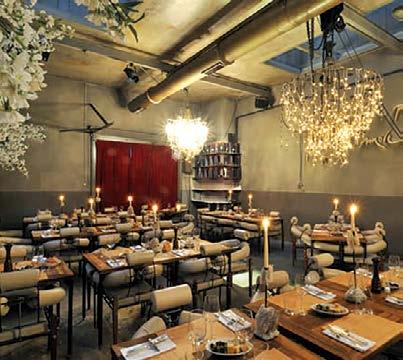
When the weather is warm, you will be delighted with the small olive garden and pleasant views of the fountain. Visitors with different tastes will be satisfied by choosing specialties from the classic, fish or vegetarian à la carte menu with the cost varying between 49 and 89 CHF.
téed peach with anise-spiced biscuits or caramel Chöpfli. Everyone knows that the local desserts surpass all other desserts of 99.9% restaurants country-wide.
St. Alban-Vorstadt 74 www.st-alban-stuebli.ch
As for the simple lunch menu, it offers pasta, risotto and secondo. Cauliflower ravioli, pumpkin pie with rosemary and chili, pumpkin amuse bouche, parme -
BEL ETAGE
The Teufelhof hotel offers two restaurants, a bar, a wine shop and a theater in one space. It is an irreplaceable center of Basel offering a combination of art, culture and gastronomy.


“Eating is an obligation but getting pleasure from it is an art”.
The gourmet restaurant Bel Etage is located on the 1st floor of the Art Hotel in an open and light space with the character of a salon. The atmosphere is calm and the mood discreet, with young courteous staff. Chef Michael Baader has been responsible for the cuisine since the venue opened. This Michelin-starred restaurant offers a versatile selection of à la carte dishes. The wine menu includes 450 different wines. Don’t forget to taste the legendary praline for dessert here.
Leonhardsgraben 49 www.teufelhof.com
san chips, and bacon risotto are just a few of the delightful meals served in a fairly short time.
As per the rules of Osteria, the price includes wine (Gagliassi Zero Langhe Rosso) and water, although you may choose wine from a diverse menu.

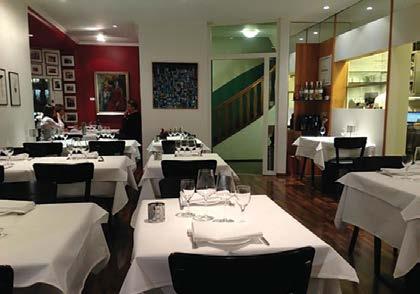
Binningerstrasse 14
www.acquabaselia.ch
41 VOYAGER 5/2016 RESTAURANTS / BASEL
Basel shares borders with France and Germany and is part of the tri-national agglomeration. Thus, its shops are located in various locations, including the city center, on both sides of the Rhine River, in the suburbs and over the borders into France and Germany.
On the left bank of the Rhine, the old town offers more mainstream shopping, via the major department store Globus. As for the right bank, it offers a smaller and more individual shopping experience.
Basel's shopping mile starts at Claraplatz. Cross the bridge to Marktplatz before following Freie Strasse and ending at Bankverein. For designer brands, take a detour to Spalenberg. Alongside well-known brands, there are numerous smaller, specialized shops and boutiques.
BALLY
FreieStrasse 88
EMPORIO ARMANI
Aeschenvorstadt 55
HERMÈS
FreieStrasse 107
JIL SANDER TROIS POMMES
Bäumleingasse 10
JITROIS TROIS POMMES
FreieStrasse 74
LOUIS VUITTON
FreieStrasse 88
TROIS POMMES
This is a conglomerate of multi-brand high fashion boutiques in Switzerland with stores in Zurich, Basel, St. Moritz and Gstaad. Each store carries luxurious high fashion brands for both men and women. Their aim is to provide a profound depth and unique identity of every collection they represent. Apart from high fashion they also offer a large variety of fine jewelry and art. Here all details tend to change high fashion and bring it back to its luxurious beginning.
FreieStrasse 74
TOI ET MOI
KLEINBASEL
The Kleinbasel label offers timeless fashion, leather bags and accessories from Basel-based designer Tanja Klein. Twice a year she launches a collection of designer clothing, leather bags and accessories for women.
The designer creates items that she would love to wear herself: clean-cut, feminine and timeless styling with a perfect balance of functionality and aesthetic.
Kleinbaselalso has an extensive collection for men, with a range of leather bags and accessories.
Schneidergasse 24
HOT LEMON
BLUE LEMON
This brand name is famous in Switzerland for its daywear and underwear.
Only premium fabrics from renowned manufacturers from Italy and Switzerland are used for the apparel and therefore their production meets the highest standards. Of course, only the high quality fabrics are considered and garments made with such fabrics are unsurpassed infashion, design, comfort and function.
Blue Lemon’s products are wonderfully light and supple – you’ll love to wear this underwear on any occasion: in your day-to-day life, or as yoga or Pilates clothing.
FreieStrasse 44
Marc Tschachtli's boutique on Gerbergässlein is a popular destination for trendsetters.
3.1
PHILLIP LIM TROIS POMMES
FreieStrasse 74
Toi et Moi is a true paradise for kids! The shop is run by Nina Mösch, a designer specializing in children's fashion. Alongside cute T-shirts from her own label Lilalotta, there is also fashion from the Scandinavian brands Drappa Dot, Katvig and Duns. Since it is all about the children, the shop would not be complete without a large, well-equipped play area.
Spalenvorstadt 3
The boutique is packed full of hip outfits by designers such as Kenzo, Ferré, Paul Smith, Diesel and Andrew Mackenzie. Hot Lemon also stocks a small but exquisite selection of shoes by labels such as La Martina Shoes and Daniele Alessandrini.
Gerbergässlein 22
FELDPAUSCH
Fashion house Feldpauschwas founded in Basel almost 80 years ago and has now expanded throughout Switzerland.
The store is spread over four floors and presents collections by famous brands and many international designers.
Falknerstrasse 19

42 VOYAGER 5/2016
HOME SHOPPING DANIELA SPILLMANN
“Couture-à-porter” is how Daniela Spillmann describes her fashion: “wearable haute couture”.
Her collection is notable for its use of the finest materials and fanciful, imaginative details.
In addition to its own label, the shop on Rheinsprung also carries quality garments by brands such as Nanni, Fabiana Filippi and Seventy.
Rheinsprung 1
TONJAONJAONJA BOUTIQUE
This is a fabulous boutique store specializing in high quality fabrics, tops and shirts. Boasting some of the best names in fashion, the stock changes according to the season and its careful selections and service are guaranteed to satisfy even the most demanding elite shopper.
This summer’s top fabrics are linen, silk and cotton and the main stock includes French, Swiss and Danish labels such as Repeat, DTLM, Style Butler, Berenice and many more.
Bäumleingasse 4
Comments
THINGS TO CONSIDER WHEN SHOPPING IN SWITZERLAND:

• MOST SHOPS ARE CLOSED ON SUNDAYS IN SWITZERLAND. THE ONLY SHOPS OPEN ON A SUNDAY ARE AT TRAIN STATIONS, AIRPORTS, AND AT GAS STATIONS IN AND AROUND URBAN AREAS.
• SALES ARE HELD ANNUALLY IN JANUARY AND JULY.
• MANY SHOPS ACCEPT BOTH SWISS FRANCS AND EUROS BUT CHANGE FOR EUROS WILL BE GIVEN IN SWISS FRANCS.
SCHWARZ MODES
Traditional Basel Schwarz Modes companyrecently celebrated its 100-year anniversary; today the brand still stands for good quality and fun fashion. The shop on Spalenberg has a large selection of materials and styles to choose from.
Spalenberg 23
DOODAH
Doodahis a specialty shop for skaters and snowboarders and is dedicated to the lifestyle of the scene. In the over 340 m²of space, you will not only find a huge selection of snowboards, skateboards and slalom skates, but also all the necessary accessories, and, of course, a huge range of clothing. “Doodah” has an own snowboard service station, making sure that you have equipment in smooth condition and they’ll put on an extra coating of wax when needed.
Falknerstrasse 33
PFAUEN
Whether you are looking for fashion footwear, accessories, interior design, cosmetics, stationery or toys, you will find a wide range of items in the Pfauen department store and enjoy the shopping experience.
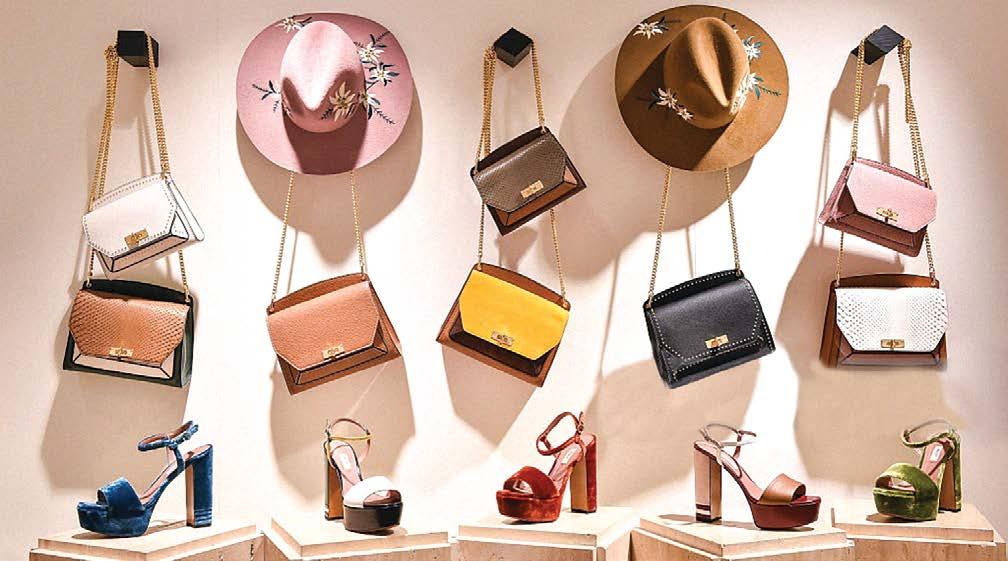
FreieStrasse 75
SET & SEKT
Founded in Basel in 2007 by Corinne Grüter, the concept behind this unique boutique is the desire to connect fashion, architecture, music and art.
Set & Sekt’s cutting edge interior was designed by Swiss architects Buchner & Bründler and the elite traveler will find unique, sophisticated clothing and accessories for men and women, which have been thoughtfully designed to add subtle glamour to modern day life.
Set & Sekt also offers the elite shopper the services of a personal shopping assistant.
Rümelinspl 5
BUCKLES & BELTS
Even the name makes a clear statement that this accessory brand is committed to belts and their products always satisfy fashion trends, in general, and individual needs as well.
Their products include a variety of 80 belts and twice as many buckles. With more than 5,000 mix-andmatch options, Buckles & Belts offers fashionable products, with supreme quality and an eye-catching look.
Hochbergerstrasse 70
CENTRAL MARKET ON MARKETPLATZ
Open: Monday, Wednesday, and Friday: 6am7pm. Tuesday, Thursday, Saturday: 6am-1.30pm. Every second and last Saturday of the month-until 6pm.
Central Market is Basel’s most prestigious market, and centrally located on the bustling Marktplatz in the shadow of the historic City Hall.
Specializing in fresh and organic produce, many flower stalls add vibrant color, while the pastry, spices, honey and bread stalls make a visit to Central Market a truly unforgettable shopping experience.
43 VOYAGER 5/2016 BASEL / SHOPPING
‘OLYMPIC GAMES’ OF THE CONTEMPORARY ART WORLD
Art Basel is the art world's most important contemporary and modernist art fairs. Ithas been held in the Swiss city of Basel every June for 46 years. Art Basel was renamed Art Basel in Basel in 2013 after the addition of Basel Miami to theroster in 2002 and Art BaselHong Kongin 2013.

So how did Art Basel achieve its eminent position? In 1967, an art market was founded in Colognethat was attended bythree Swiss gallery owners who then decided to found the Basel art fair in 1970.One of the gallery owners, art dealer and collector Ernest Beyeler,went on to become world-famous. Designed by Renzo Piano in Basel, the Foundation Beyeler is one of the best modern art museums in the world.
Some 90 international galleries and print publishers participate in Art Basel.At the beginning of 90s,Lorenzo
Rudolf became the head of Art Basel. Rudolfreduced theArt Basel selection committee from 30 to three influential gallery owners, adopted stricter participation rules, obtained UBS Bank sponsorshipand divided the fair into sections.
Under his lead, ArtBasel PRdirector Sam Kellerexpended the international campaign and created the first official website in 1995. He paid special attention to Chinese and Asian galleries. On Ernest Beyeler’srecommendation, Sam Keller became the head of the fairfrom2000 to 2007.
ART
IRENA POPIASHVILI
© Art Basel
15-18 44 VOYAGER 5/2016
ART BASEL 2017
JUNE
SAM KELLER HAD A SPECIAL TALENT FOR COMMUNICATING WITH PEOPLE. I WAS DIRECTOR OF SPENCER BROWNSTONE IN NEW YORK IN 1999WHEN I MET HIM FOR THE FIRST TIME. HE CAME TO SEEAN EXHIBITION. I HAD HEARD A LOT ABOUT HIS AMAZING MEMORY, ANDI EXPERIENCED THIS A YEAR LATER AT ART BASEL,WHEN HE RECALLED THE ARTISTSWE DISCUSSEDAND THE CONVERSATIONS THEMSELVES.
Keller developed Art Basel Miami and turned it into the leading North American art market. Art Basel Miami mainly targets Latin American art,competing with and almost entirely overshadowingthe local Miami Art Fair. Art Basel Miami became themeeting place for Latin and North American art collectors. The warm weather in December contributed to the success of Art Basel Miami, as well as the glamourous parties held in wealthy collectors’ homes and designer boutique hotels. Typically,the press reportson Art Basel Miami parties separately.
In 2011, new directorsMarc Spiegler and AnnetteSchönholzer decided to buy 60% of Art Hong Kong to gain a foothold in the Asian Art Fair. It was named Art Basel Hong Kong in 2013.

Art Basel is held at the MesseBaselconvention center, which includes a partially roofed platform designed by Swiss architectural firm Herzog & de Meuron in front of the fair area.
Art Basel consists of several sections, including Art Unlimited, Art Statements, Feature(modernist and contemporary art), Parcours(differentworks and installations in various parts of the city), Film (a week-long film programme) and print publications. Let’s discuss the selection of participants, before we go into details about the sections.

Onlythe best galleries may participate in Art Basel. Every year, they fill out application forms that are strictly evaluated by the selection committee. The committee is comprised of several well-known gallery owners, typicallyseven to nine of them.Legends circulate about how the committeemembersinspect the gallery list, read magazines reviews of the applicants and view their
 Thea Djordjadze / Untitled 2009 Wood, glass, lacquer, paper, clay, plaster, plastic, fabric © Thea Djordjadze, Courtesy Sprüth Magers
Thea Djordjadze / Untitled, 2009 Wood, paper mache, lacquer, paint © Thea Djordjadze, Courtesy Sprüth Magers
Ketuta Alexi-Mekshishvili / Installation view at Statements, Art Basel, 2016 Micky Schubert, Berlin / Photo © Eric Tschernow, 2016
Thea Djordjadze / Untitled 2009 Wood, glass, lacquer, paper, clay, plaster, plastic, fabric © Thea Djordjadze, Courtesy Sprüth Magers
Thea Djordjadze / Untitled, 2009 Wood, paper mache, lacquer, paint © Thea Djordjadze, Courtesy Sprüth Magers
Ketuta Alexi-Mekshishvili / Installation view at Statements, Art Basel, 2016 Micky Schubert, Berlin / Photo © Eric Tschernow, 2016
45 VOYAGER 5/2016
catalogs. Some galleries try foryears to get into the fair, tirelessly sendingapplications. Some galleries are placed on a waiting list. Art Basel is so prestigious thateven being on a waiting list is also a great acknowledgement.

The committee asks for a three-dimensional render of a gallery stand and then checks the real stand according to the pre-sent render. Bringing an artcollectorto see the gallery before the fair is prohibited. Paris-based gallery owner Emmanuel Perrotinonce brought in an art collector disguised as an installation assistant. Art Basel employees recognized him and made Perrotin leave. It took him years to regain the right to participate in Art Basel again.
VIP collector program: The VIPprogram and space for VIP collectors wasLorenzo Rudolf’s idea. The participating galleries invite their collectors to the VIP program. There are several VIP cardswith different colors to distinguish the privileges and advantages of the card holder.
VIP opening is usually on Tuesday.From 11am to3pm a queue forms by the entrance, and collectors then rush to get to their desired works first. Usually, galleries keep the year’s best works for Art Basel.Photos of works to be exhibited are sent in a few months in advance, and some galleries already have sold everything via preliminary agreements.
Often, a well-known collector will have several art consultants who visit the various sections taking photos of artworks and immediately sending them to the collector. The latter can then decide to buy them or not based on a photo sent by phone.
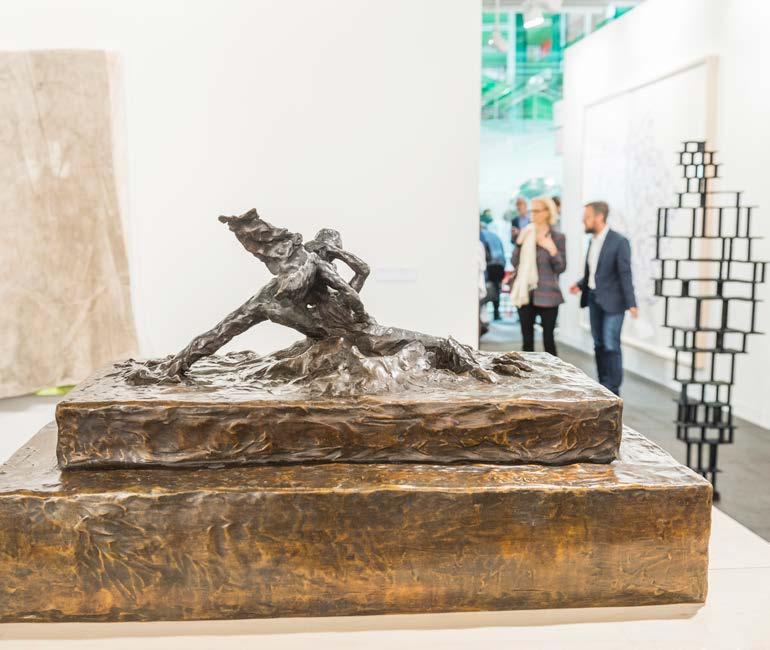
Charles Saatchi, for example, has acquiredart this way basedon photos sent by a consultant.
Famous galleries will not sell art to those who are not familiar with the art world without recommendations from a famous collector or an art consultant. This is done, in part, to protect the works of art, because when the gallery owner sells a painting to an unidentified collector, he/she has no guarantee that the collector will not sell the painting at auction.This arrangement is partly a result of galleries’ snobbishness.
One of the most interesting parts of the show is the Art Unlimited, curated by Gianni Jetzer. This is held in a huge hangar space, where the galleries present large-scale special solo projects. Such projects are often expensive, and when an artistis represented by several galleries, they often share the project costs.
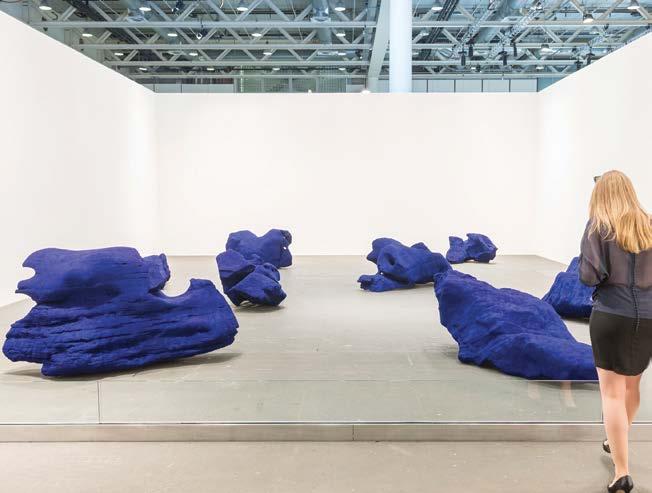
ART
© Art
© Art
1 2 3
© Art Basel
Basel
Basel
1. Gladstone Gallery, Lisson Gallery / Anish Kapoor
2. Galerie Daniel Templon / Chiharu Shiota
46 VOYAGER 5/2016
3. Galerie Xavier Hufkens
Sometimes, a historical exhibition by a famous artist is re-enacted, or unrealized projects are implemented. These spectacular museum-qualityexhibitionstarget institutional and corporate collections. A few years ago, the Berlin Gallery presented a solo project of Georgian artists, Tea Jorjadze, at Art Unlimited.
Art Statementis for young gallerists, whichexhibit small solo displaysby promising young artists. This year, Micky Schubert Gallery in Berlin presented a Ketuta AleqsiMeskhishvili photo exhibition.
The Feature section presents historical or thematic exhibitions.
Twentieth-century art work is usuallydisplayed on the first floor, where visitors may buy the masterpieces created at the beginning of the century. Many modernist art galleries have participated in Art Basel sinceitsfirst edition and occupy their “own” space at the fair. An information stand is locatedat the entrance, presenting fair plan and maps, and the fair catalog, which lists all the participating artists and galleries.

Cafes and restaurants are located in the courtyard of the convention center. The Kunsthalle bar is a popular place to hang out after the fair is closed. It is located in the yard of the contemporary art exhibition space. It is known as a place where the after-hours agreements are made.
Famous Basel museums organize special exhibitionsduring Art Basel.There is the Schaulager, built by a private collector, a storage and exhibition space for the collection; Renzo Piano's museum building; Basel Kunstvereinand the Museum of Applied Arts.
Several art fairs are held parallel to Art Basel.Listehas created a “newcomers” fair, inagreement with the Art Basel. It is also prestigious and intended only for young galleries. Two years ago, Georgian Gallery Nectarorganized an excellent presentation of the group exhibition.
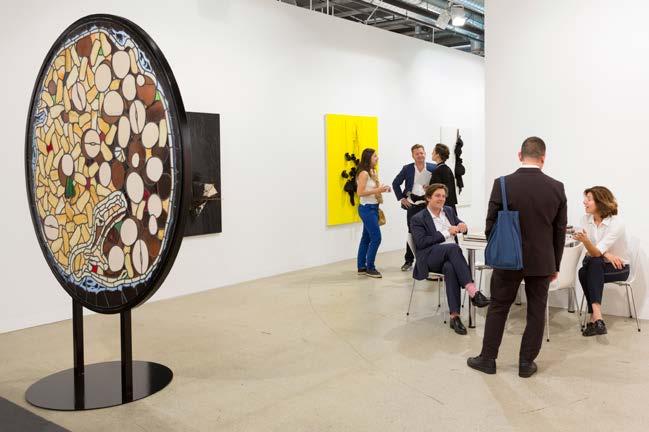
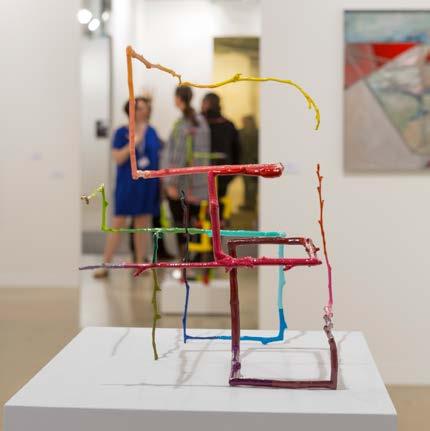
In addition, other smaller fairs operate too, such as Voltaand Miami Design.
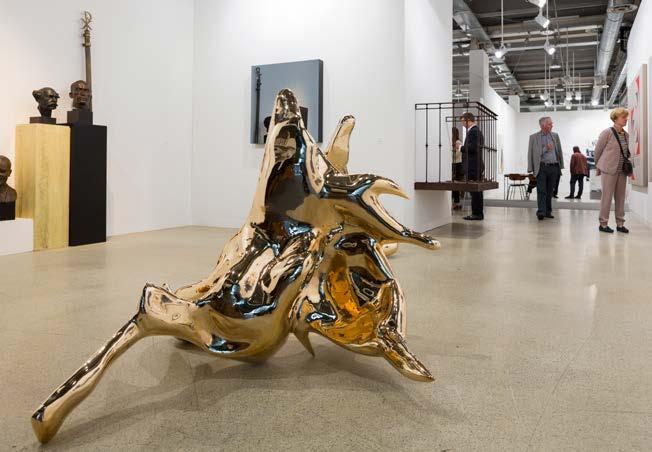
IF YOU ARE INTERESTED IN 20TH AND 21TH CENTURY ART AND ART COLLECTION, I RECOMMEND VISITING ART BASELTO PERSONALLY WITNESS THE ‘OLYMPIC GAMES’OF THE CONTEMPORARY ART WORLD.
© Art Basel
© Art Basel
© Art Basel
© Art Basel
Galleries 2016
4. Galerie Thomas
5. The Approach
6. Galleri Nicolai Wallner
4 5 6 7 47 VOYAGER 5/2016
7. Bortolami


HOW THE WHOLE WORLD “GOT INFECTED” WITH SWISS WINTER

WINTER
@ swiss-image.ch 50 VOYAGER 5/2016
Nino Daraseli
The owner of Baer hotel in St. Moritz enthusiastically told his English guests about the beauty of the local winter, and invited them to return in the winter and promised them snow, sun and a good temperature. He promised that they would be able to walk down the streets in their shirts– or he would pay their bills. This happened in the spring of 1864.
A blizzard came that year and the first English visitors came to stay to sledge, skate and play curling…they spent their first winter holidays in the Alps.
In 1904, when bobsleigh sportsmen laid a bobsleigh route from St. Moritz to Celerina, the British visitors’ guide “Two Seasons in Switzerland” praised the local winter and claimed that holidays in Switzerland would soon become prestigious.
Graubünden canton was the most popular place for winter holidays from the very beginning: English tourists visited Graubünden even before skiing became popular, instead of going to Egypt or the Riviera.
They founded the first sleigh club in Davos in 1870. They opened the biggest skating ring in 1877. As a result, this resort became the capital of Europe’s skating.
Englishmen “infected” thousands of people with this country of immaculately white snow; they began implementing many crazy ideas: bobsleigh and skeleton, fast rides, and sleighs. One popular way to spend time, sleighing, became a sport in Davos and spread to Klosters after the first tournament in 1883. It then became the cult sleigh resort.
Winter sport was considered the entertainment of the elite until the 1920. Mountain skiing made it available for all. The St. Moritz Olympic Games held in 1928 greatly contributed to this change.

Gstaad, St. Moritz, Zermatt and Davos gradually turned into famous brands. Railways were built to make travelling comfortable for guests; the railroad line Chur via Davos was built in 1890; Rhaetian Railway went up to St. Moritz and was built in 1904. It is now part of the UNESCO World Heritage list.

It soon became obvious that guests needed active entertainment in addition to sightseeing. Resorts started developing winter sports facilities. This is why the first funiculars was opened in 1912, from Murren to Allmendhubel and from St. Moritz to Chantarella. The first T-bar design ski lift was built in Davos. It was developed by a Swiss engineer called Ernst ("Ernest") Constam and a mountain instructor called Jack Ettinger.
The best resorts spend millions today on improving their ski lifts and infrastructure; however, the “gold mine” of Switzerland is its natural treasure: its great slopes, forests and rivers, glaciers and lakes, just like 150 years ago, during Johannes Badrutt’s time. Switzerland remains breathtakingly beautiful
Comment
2016/2017 Winter Season
The Zermatt-Aostatal skiing region is the most expensive winter resort.
A six-day ski pass costs 463 CHF; Zermatt-Cervinia is the second most expensive place at 434 CHF, while the Zermatt village is third at 380 CHF. Engadin St. Moritz is fourth, while Quatre Vallées-Verbier is fifth: skiing for a week costs 370 CHF there.
Gstaad and the Canton of Vaud are a little behind pricewise, but equal in service and relaxation. A skiing superpass costs 333 CHF. On average, one-week skiing in the Swiss Alps costs 330 CHF per person.
A snowless winter is impossible in the Swiss Confederation due to its climate, thus there is no chance of your holidays being spoiled.
51 VOYAGER 5/2016
ZERMATT IS THE GOLDEN STANDARD OF SKI RESORTS. EVERYTHING HERE IS LIKE A CHOCOLATE CANDY BOX: TYPICAL ALPINE VILLAGES, DOZENS OF SKI LIFTS THAT TAKE YOU ABOVE 3,000 METERS, WOMEN IN FUR VISITING LUXURY SHOPS, SKIERS THAT WEAR SKI OUTFITS ALL DAY LONG, HORSEDRAWN CARRIAGES INSTEAD OF CARS, ENTERTAINMENT IN THE NEIGHBORING ITALY, SNOW BUSES THAT RUN PRECISELY LIKE SWITCH WATCHES, AND ONE OF THE BEST SNOW PARKS IN EUROPE, WHICH GUARANTEES GOOD QUALITY SNOW. AND THEN, OF COURSE, THERE’S THE AMAZING PANORAMA.
"Matterhorn Ski Paradise” is a 380-kilometer ski slope, the highest in Europe (generally, Zermatt has lots of superlative features). All of the ski tracks offer amazing view of Matterhorn; you can ski across to Italy via Klein Matterhorn.
GRAVITY Snow Park is annually organized on Klein Matterhorn. Here is the 200-meter half pipe, super pipe and everything worthy of the Europe's biggest snow park.
SKI BORDER
We can argue about the main point that divides Switzerland and Italy: is it Matterhorn or Cervino?

One thing is certain: this pair is joined by cable cars, and offers guests a total of 400 kilometers of ski trails. It is the best for skiing and snowboarding. The main thing is not to stay on the "foreign" side of the slope after closing time.
FREERIDE
Although the routes are carefully selected and lifeguards patrol them constantly, it is better to not take "yellow" routes independently and hire a guide to scout the best places for the first time.
Skiing for 3-7 people (with a guide) costs 158 CHF, while freeride skiing with the guide costs 560 CHF (per person).

VISITORS CAN GO TO NEIGHBORING MONTE ROSA MASSIF (ITALY) FOR HELISKIING. THE MOST LUCRATIVE RIDE IS CALLED TOUR MONTE ROSA AND INCLUDES A SLOPE FROM 4200 METERS TO 2600 METERS. IT IS A PLEASURE WORTH 380 CHF (GROUP OF THREE RIDERS AND A GUIDE).
EVEN FAMILIAR SLOPES ARE FULL OF SILENCE AND SURPRISES AT MOONLIGHT, WITH FABULOUS LIGHT ILLUMINATING THE ICY HILLS. IF YOU ARE READY FOR SUCH ADVENTURES, TAKE A GOOD REST AFTER A FULL DAY OF SKIING, DRY YOUR OUTFITS AND SKI BOOTS AND HEAD TO THE SKI STATION AT 18:45. THE PRICE OF THIS ADVENTURE FOR ADULTS IS 70.50 CHF.
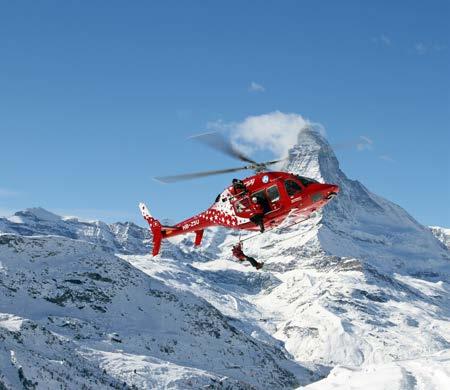
ZERMATT
WINTER
52 VOYAGER 5/2016
@ swiss-image.ch
IGLU DORF

A whole village and ice houses are built annually on the 2,700 meters altitude, where you can feel like an Eskimo.

PRATO BORNI
Zermatterhof hotel restaurant is one of the best in the Prato Borni resort. Its international menu is a mix of French and Italian cuisine.

LE GOURMET
Another contender for the title of best restaurant is located in the Hotel Alpenhof. 15 Gault Millau points and a Michelin star is the best recommendation for this place.

In fact, with the sauna and jacuzzi, fondue, bar, and Highland Vineyards Swiss hot white wine served on ice beds covered with fur, you’d probably like being an Eskimo. Of course, this is just a one-night adventure.
GRAND HOTEL ZERMATTERHOF
This hotel opened in 1879. It is the embodiment of everything that can be defined “fivestar". It offers about one hundred rooms, expensive restaurants, a spa center, private mini spaces, and casino ... Horse-drawn carriages wait outside the hotel to offer residents an alternative to a taxi.
KULMHOTEL GORNERGRAT
It would probably be considered a hotel were it not for its location; this is a fortress with an observatory dome. You can get here by train. Hotel rooms are called after the mountains. Stay here for one night to enjoy the stars.

FINDLERHOF-FRANZ & HEIDI
If you head to towards Findlen, you’ll encounter a fairy-tale small village with precious mountain restaurants. All of them offer breathtaking views of Matterhorn.
The most impressive and famous is Findelrhof (also called the "Franz" and "Heidi"). This culinary place is marked by 14 points of Gault Millau.
LE CORBEAU D’OR
The third competitor for the title of best restaurant is located in the Hotel Mirabeau- the Restaurant Le Corbeau d'Or.
Price per person for dinner here is 50-70 CHF.Please listen to the sommelier’s advice, since almost half of the Swiss vineyards are located on Matterhorn.

ZERMATT @ swiss-image.ch
53 VOYAGER 5/2016
The climate of St. Moritz is distinguished by its record number of sunny days. Many call it a “champagne climate” not because most of the visitors prefer champagne to other drinks but because of the winter “lights” that characterizes St. Moritz and whole Upper Engadine area, creating the effect of champagne sparkles in the air.

ST. MORITZ
SAINT MORITZ IS THE MOST GLAMOROUS SKIING RESORT IN THE WORLD. THE IDEA OF WINTER VACATIONS WAS BORN HERE 150 YEARS AGO. ST MORITZ IS CONSIDERED THE MOST POPULAR RESORT AMONGST SKI LOVERS DUE TO ITS ATTRACTIVENESS. THE NAME ITSELF HAS BECOME A SYNONYM FOR STYLE, ELEGANCE AND HIGH CLASS.
APRÈS-SKI
After skiing, many skiers visit Kings Club and the Palace Hotel, as well as the renaissance bar, Badrutt’s Palace, which is known as Mario’s Bar. The name was given after the barman who creates the best cocktails.

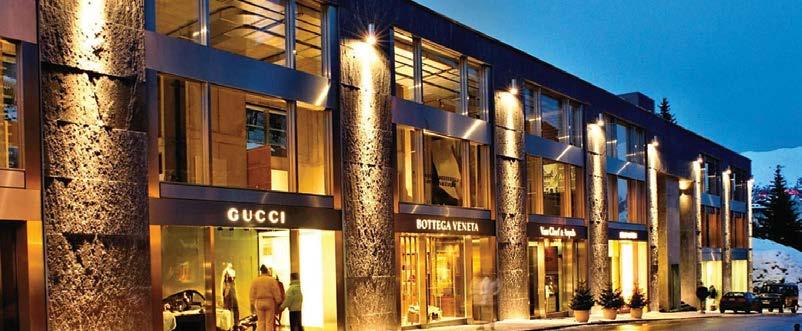
EACH VISITOR STOPPING BY ST. MORITZ FOR A MINIMUM OF TWO DAYS GETS A SPECIAL OFFER FOR ONLY 35 SWISS FRANCS; THIS INCLUDES ACCESS TO THE 350 KM LONG SKIING ROUTES, 57 METER CABLE CAR, 34 MOUNTAIN RESTAURANTS AND THE AMAZING PANORAMA OF ENGADINE, ALONG WITH FREE PUBLIC TRANSPORT. @ swiss-image.ch
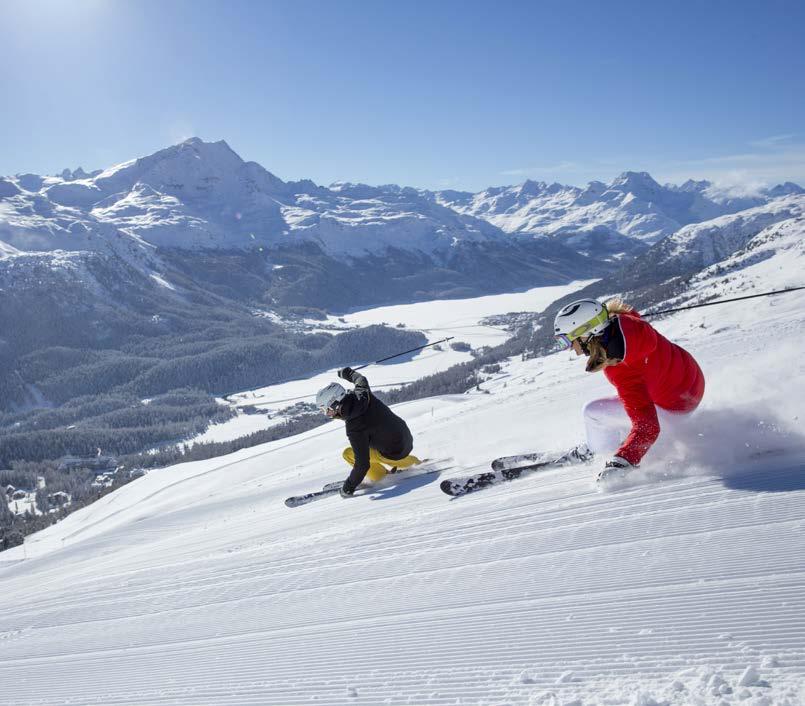
54 VOYAGER 5/2016
WINTER
Italian and Mediterranean cuisine is represented by the restaurant Dolce Vita, which is located in the center of St. Moritz, while the restaurant Crissini (at Hotel Crystal) offers tasty homemade pasta.

Simple but tasty Italian dishes are served at Roberto (St. Moritz Bade) and Tratoria Caruso (Hotel Laudinella).

TALVO BY DALSASS
The reputation of this restaurant can be judged in numbers: one Michelin star and 18 Gault Millau points.
Here you can taste the newest modern gastronomical blends--lobsters, local lamb and mutton.

KULM HOTEL
The history of Hotel Kulm starts in 1856. The interior of the hotel rooms and suites have been preserved for three centuries. The hotel offers an amazing kitchen, huge spa with thalassotherapy, swimming pool with panoramic view on ravine and ice rink, leaving you with unforgettable memories.
www.kulm.com
THE FACT THAT THE RESTAURANTS OF ST. MORITZ HAVE RECEIVED 489 GAULT MILLAU POINTS AND 7 MICHELIN STARS IN WINTER TIME, AND 379 GUALT MILLAU POINTS AND 5 MICHELIN STARS IN SUMMER TIME, MAKES IT A REAL HEAVEN FOR GOURMANDS. ST. MORITZ HAS BECOME A SYMBOL FOR REFINED AND EXQUISITE CUISINE. THE CULINARY LIFE OF THE CITY HAS BEEN MARKED WITH INNOVATIONS THAT GIVE IT A SPECIAL COSMOPOLITAN ATTRACTIVENESS.
BADRUTT PALACE
Life in St. Moritz has been heating up since 1896. This is the first choice for royal families who visit Switzerland. The pride of the hotel is its wellness spa palace.

Chef Nobu Matsuhisa performs magic with his dishes. The cuisine of Badrutt’s boutique palace is created according to Japanese and Peruvian gastronomic traditions.
CARLTON
The Cartlon had its first visitors in 1913. You can see the lake of St. Moritz from each of the rooms. The snow polo world cup is held on the ice rink of the lake. The spa is located on the first three floors of the hotel, 1,200 meters above sea level. The hotel has an open swimming pool that offers amazing views.
www.carlton-stmoritz.ru

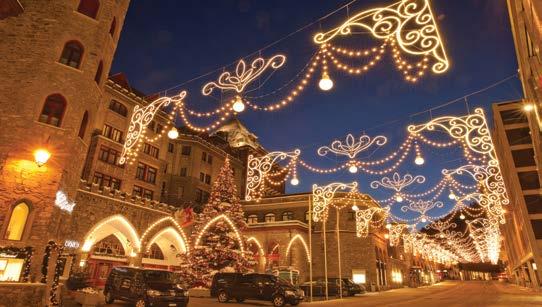

CHESA VEGLIA
For those who want to end up in a very exceptional place and have a great meal, we recommend the oldest restaurant, Chesa Veglia, built in 1658. This is a construction that stands in the middle of St. Moritz. Chesa Veglia is owned by Badrutt’s palace. The hotel has three exceptional restaurants: Swiss, Grill and Pizzeria. Here one can also find two bars with an amazing wine collection.
55 VOYAGER 5/2016
ST. MORITZ
SAAS-FEE
SAAS-FEE IS KNOWN AS THE PEARL OF THE ALPS. THIS RESORT, LOCATED IN THE HEART OF THE SAASTAL FIELD, RESEMBLES A PEARL PLACED IN THE OVAL "FRAME" OF THE 13 MOUNTAINS OVER 4,000M HIGH.

Its long season of fluffy snow, well set-up infrastructure, great choice of hotels, chalets and apartments at affordable prices, and quiet Alpine atmosphere have turned this place into a popular destination for family vacations.
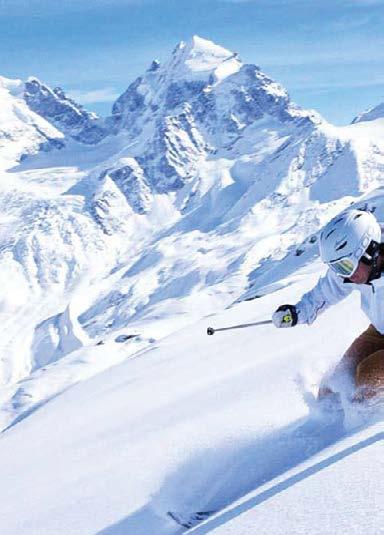


SKIING ALL YEAR ROUND
In Saas-Fee, the ski season lasts forever. The tracks are only closed from the second week of May to the end of June. In July they open again. For those who cannot imagine their life without the snow, there is a 20-kilometer track 3,600m up.
National teams from various countries practice here in the summer.
SAAS-FEE CITIZEN PASSPORT
A few years ago, the Saastal tourist valley voted to establish the Free Republic of Holidays Saas-Fee, and started to issue the respective documents to all of its guests. These electronic cards allow their owners to take advantage of numerous benefits during their stay in Switzerland. For example, a temporary citizen can use buses and cable cars for free (the only exception is the subway).
REVOLVING RESTAURANT
At the Mittelallalin station, a revolving restaurant set at the highest altitude will host you, but here you almost forget about the food because you cannot take your eyes off the fantastic panorama of the Mishabel mountain range, the Valais valley, the Bernese Alps and the Graubünden peak.
The restaurant takes one hour for a full turn and is definitely an hour well spent.
NO TO CARS!
There is a total of 270 electro cars in SaasFe and their quantity basically does not change. This is not only due to the fact that a special permit is required to own such a car but mainly because, despite their non-premium appearance, these "toys" are not cheap. For example, the smallest of them costs 60,000 Swiss francs; the more pricy will cost 120,000. Regular cars are restricted in Saas-Fe – the only mean of private transport allowed are these tiny electro cars.
THE HIGHEST SUBWAY
20 years ago, the residents of Saas-Fee decided that their life was impossible without a subway, and built a high-speed subway at the altitude of 3000-3500 meters. The train's last stop is at the altitude of 4027 meters, on the Allalin mountain peak, covered in ice. Metro Alpin is the highest-altitude subway in the world, with a length of almost 1.5 kilometers, and a travel time of 3.2 minutes.

56 VOYAGER 5/2016
WINTER
SAAS-FEE

VERBIER
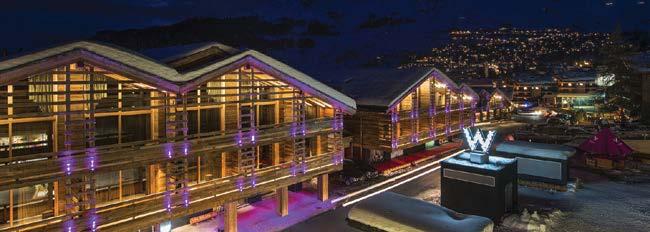
VERBIER IS THE CENTER OF GRAVITY FOR FOUR VALLEYS WITH SKIING TRACKS AND HUNDREDS OF CABLE CARS STRETCHED ACROSS 412 KILOMETERS, FREE-RIDE TRACKS FOR EXPERIENCED SKIERS, AND THE OPPORTUNITY TO PASS FROM ONE VALLEY TO THE OTHER. THERE ARE 150 SKI TRACKS RIGHT ABOVE VERBIER. IN ADDITION, THERE ARE 220 KM OF TRACKS IN THE SKIING SECTORS OF NENDAZ, LA TZOUMAZ, VEYSONNAZ, AND THYON.
PUB MONT FORT _ This pub is the most legendary place in Verbier. At various times, David Bowie, Jeremy Irons, Sarah Ferguson, Nigel Kennedy and others have spent time here.
A famous après-ski entertainment point can become the main stage of a rampant entertainment in the evening, and often people are seen in the morning running down to the lower station to bring up more champagne.
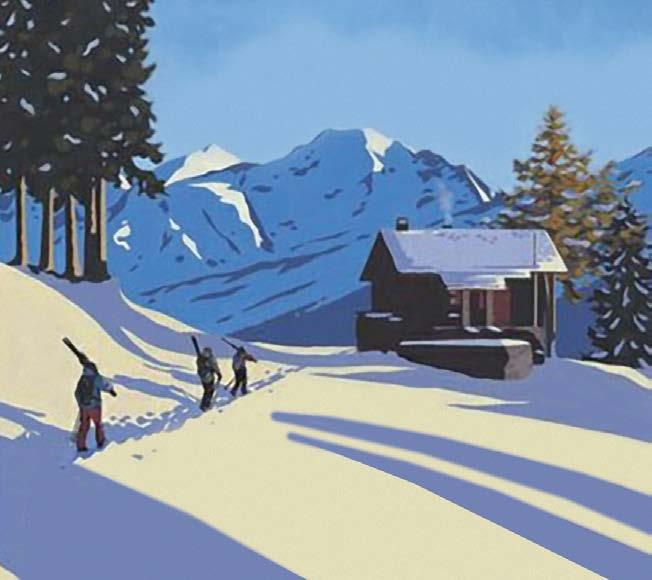

IGLOO BAR _ is on the Montford Mountain at the altitude of 3,300 meters and is the highest bar in Europe. A wonderful view of the whole four valleys region can be seen from here; moreover, both Matterhorn and Mont Blanc can be seen as well. The bar is tiny, so the hot wine, coffee, hot chocolate and tea with sandwiches and hot dogs are mostly offered to go.

LE MILLENIUM _ The key points of the restaurant’s menu are the veal and venison meat "duet", which are served with foie gras. Also do not miss the chance to taste the delicious shrimp in green sauce and wild ostrich meat with mushroom cream.
YOUCANENJOYTHE DISHES THAT SWISS CUISINE IS FAMOUS FOR - GOAT CHEESE SALAD AND CHEESE OR MEAT FONDUE,RIGHTTHERE ON THE VERBIER TRACKS.
W VERBIER _ is a grand complex of Trois Rocs, located just two steps away from the Medrana station. It has long become part of the Verbier landscape.
The grand project includes the "Verbier Hotel" with 123 rooms, two apartment complexes, a spa and a fitness center. Here you will also find the gastronomic restaurant "Arreola" run by wellknown chef, Serge Arreola, as well as a club and shopping center.
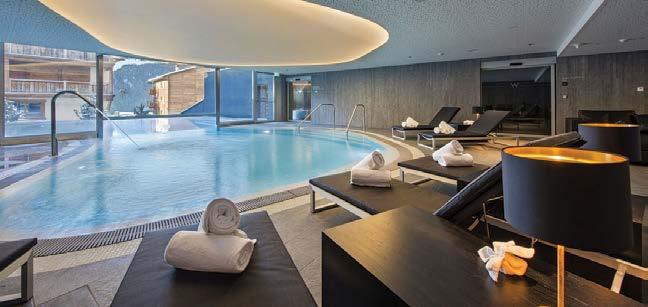

58 VOYAGER 5/2016
WINTER
VERBIER
@ swiss-image.ch
GSTAAD



GSTAAD IS ONE OF THE MOST RESPECTABLE RESORTS; IT'S IN CONSTANT COMPETITION WITH SAINT MORITZ. THE MAIN DIFFERENCE BETWEEN THE TWO IS THAT GSTAAD OFFERS A QUIETER, HOLISTIC ATMOSPHERE, WHICH IS WHY IT'S OFTEN CHOSEN BY CELEBRITIES WHO NEED TO GET AWAY FROM PRYING EYES FOR SOME TRUE RELAXATION. GSTAAD ALSO HAS THE HIGHEST CONCENTRATION OF MILLIONAIRES’ VILLAS AND MANSIONS OWNED BY SUPERSTARS IN THE ALPS.
The skiing zone comprises eight regions, including the only glacier in the district – Glacier 3000. In total this means that Gstaad offers 220 kilometers of skiing slopes.
THE SKIING ROUTES IN NEIGHBORING WASSERNGRAT, WISPILE AND EGGLI ARE MAINLY TRANQUIL, PLEASURABLE AND SPECTACULAR.
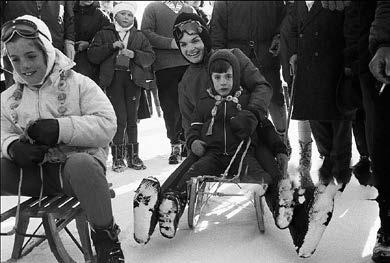
CHESERY _ this restaurant is officially unsurpassed by others in Gstaad and its high status is confirmed by Gault Millau scores and a Michelin star. The chef Robert Speth has a preference for Asian cuisine and treats the guests with mesmerizing seafood.
GSTAAD PALACe _ although the restaurant was built in 1913, its charm hasn't faded. The guestbook here is constantly updated with celebrities’ new autographs. The exceptional pride of the hotel lies in a number of gourmet restaurants marked with Gault Millau scores.
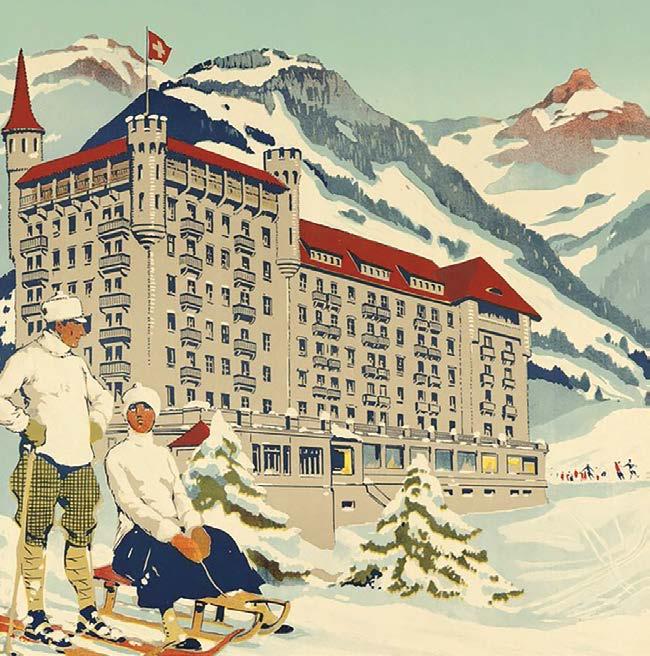

THE DISCREET ATMOSPHERE OF GSTAAD IS VERY WELL REFLECTED IN THE MOTTO OF THE RESORT: „COME UP _ SLOW DOWN“.

GOLFHOTEL LES HAUTS DE GSTAAD & SPA _ here you can enjoy the huge spa, treat yourself with the finest specialties found in the gourmet restaurants, take culinary masterclasses with Michelin star chefs, and in complete comfort revel in one of the 55 contemporary rooms of the hotel, stay at Chalet Gulfino or choose an apartment.

59 VOYAGER 5/2016
It's pretty normal here to encounter stars and elites at the Hermes, Prada, Louis Vuitton and Dior boutiques, previously visited by;
1. Elizabeth Taylor and Richard Burton; 2. Jacqueline Kennedy; 3. Bridget Bardot; 4. Grace Kelly
GSTAAD
@ swiss-image.ch
@ swiss-image.ch
DAVOS KLOSTERS
Davos Klosters is the highest Alpine city in Europe, located at 1,560 meters above sea level. There are 13,000 permanent inhabitants.
Davos was well known before skiing became a favorite vacation pastime. Since the 19th century visitors have come to be cured by its mountain air and sun. It was considered that the local climate could work magic.



DAVOS HAS WONDERFUL HOTELS, SHOPS AND A HUGE NUMBER OF ENTERTAINMENT OPTIONS, INCLUDING CASINOS, AND HUNDREDS OF RESTAURANTS, BARS AND CLUBS.
YOU COULD REST HERE FOR A COUPLE OF DAYS EVEN WITHOUT SKIING. DAVOS HAS THE BIGGEST ICE RINK IN EUROPE AND SKATING IS AS POPULAR AS SKIING.
Davos is the best place for vacations and discussions on the future of the world. This is proven by the fact that the World Economic Forum has taken place there annually since 1974, attended by the business and political elite.

THE WINTER SPORTS MUSEUM REPRESENTS THE HOMELAND OF MODERN WINTER SPORT SIGHTS. THE FORMER POST OFFICE BUILDING WHICH IS CURRENTLY THE MAIN ADMINISTRATIVE BUILDING, HAS BEEN AN IDEAL LOCATION FOR THE EXHIBITION OF RICH SPORT EQUIPMENT.
www.wintersportmuseum.ch
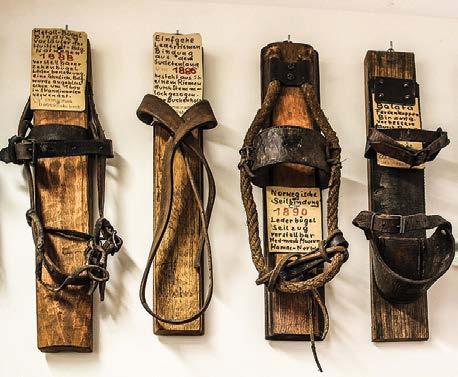
60 VOYAGER 5/2016
WINTER
INTERCONTINENTAL DAVOS _ represents a kind of manifesto of modern design. The effect of the oval capsule facade changes according to climate and observation angle. The Sky Lounge on the upper floor has become a unique gastronomical concept. Here you can enjoy wonderful views over Davos. The lower floors of the hotel, where lobby, bar, club, restaurant and enormous wellness center are located, also exhibit extravagant design.
WALDHOTEL _ a creation of the chef of the gastronomical restaurant, Martin Lafayette, was awarded 15 Gault Millau points and is filled with sharp contrasts.
Guests can choose dinner from the menu, or have a selection which is comprised of 8 different dishes: Asian soup from the tail of a lamb, Colin breast in truffle sauce and fried lamb, Irish style.
APRÈS-SKI
WALDHOTEL DAVOS _ Davos brings us to Tomas Mann (he created the Barghof prototype of this hotel in his novel The Magic Mountain).

To honor Mann’s name, Waldhotel has built a special “magic” chalet, where the price of a room starts from 700 Swiss francs.

TURMHOTEL VICTORIA
This cozy hotel is located next to the railway station. Due to its unique architecture and interior design, it has become the main subject for photo sessions in Davos. Bill Clinton’s appreciation letter can also be found in the guestbook of the hotel.

www.victoria-davos.ch
PÖSTLI CLUB
The Postli Club in the Morosani hotel is the most famous club in the resort. It has the best drinks and dance music, and the amazing environment will definitely suit your taste.
www.posthotel.morosani.ch

EX BAR
This is a popular après-ski spot. On Fridays and Saturdays the bar is open until morning.

www.ex-bar-davos.ch
DAVOS AND ITS NEIGHBOR KLOSTERS OFFER VISITORS SIX SKIING ZONES. IN TOTAL, THE SKI ROUTES ENCOMPASS 320 KM. DIFFERENT PARTS ARE CONNECTED THROUGH CABLE CARS AND DRIVING THROUGH DIFFERENT DISTRICTS IS POSSIBLE BY LOCAL MOUNTAIN BUS. DAVOS IS THE BEST PLACE FOR FREESTYLERS AND FREE-RIDERS AND THE PARKS OF THE AREA ARE OBJECTIVELY LISTED AS THE BEST IN THE COUNTRY.

61 VOYAGER 5/2016
DAVOS KLOSTERS
CRANS-MONTANA

A VARIETY OF LOCAL SLOPES ATTRACTS BOTH PROFESSIONAL AND BEGINNER SKIERS, ALTHOUGH THERE ARE ALSO MORE ATTRACTIVE OPTIONS LIKE THE PAS DU LOUP SLOPE AND ROUTE PISTE NATIONALE WHICH HOST THE CHAMPIONSHIPS. IT IS NOT SURPRISING THAT THE SPEED SKIING CONTEST WAS INVENTED IN CRANSMONTANA, IN 1907. ICE RINKS, INDOOR AND OUTDOOR SWIMMING POOLS, WELLNESS CENTERS, BRIGHTLYLIT SHOPS AT RUE DE PRADO... ALL CAN BE FOUND AT CRANSMONTANA.
APRÈS-SKI
ZERODIX
Zerodix is a classic Après-ski bar in the heart of Crans, closeby to the ski lift Cry d’Er, which is open from 8 AM to 8 PM.
You will enjoy breakfast in quiet surroundings here and after 8 you’ll be able to spend loud evenings with the other 'insiders'.
AMADEUS BAR
This bar thrives with a genuine nightlife. Dances, music, Jagerbomb cocktails – all together makes an ideal setting for energetic visitors.
MONK’IS BAR
This place offers a huge choice of alcoholic beverages and a few snacks too, but the bar is mostly visited for fun not for drinks. During winter season Monk’is Bar hosts theme parties and discos with great DJs.
www.monkis.ch
PIERRE ARNAUD ART FOUNDATION
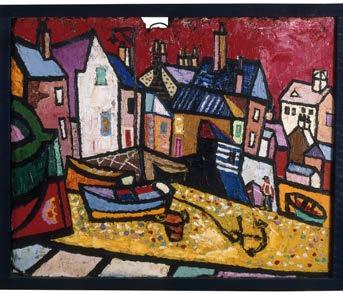
For the past 15 years Crans-montana has been known not only as an attractive sports center, but as a cultural metropolis. Museum Pierre Arnaud Art Foundation has become the symbol of this art capital.


It is famous not only for its 19th Century paintings collection, but also for its wonderful restaurant. You will be delighted with the cozy ambience, homelike and creative atmosphere at restaurant L'Indigo.
თავისი ახალგაზრდა კოლეგების, ამ რესტორნის მენიუს შემოქმედი მეტიუ მოროს და მისი გუნდის რეკომენდაციებს გადმოგცემთ.
www.fondationpierrearnaud.ch

62 VOYAGER 5/2016
In Crans-montana, two neighboring villages have fused in a way to form one of the most original Alpine resorts.
WINTER
ვახშმის დროს ცნობილი შეფი ფილიპ როშა
@ swiss-image.ch
LE СRANS HOTEL & SPA
Although its new renovations are evident, the Le Crans Hotel has also preserved the sense of being a traditional chalet. Each themed room with unique decor takes you to a different mountainous region, from the Himalayas to the Kilimanjaro.
Le Crans also offers a spa with Ayurveda massage and relaxing Bali procedures, a heated outdoor pool and a restaurant, Le MontBlanc, with its own wine cellar. Overall it offers a recipe for an ultimate holiday.
www.lecrans.com
HOTEL DE L’ETRIER
This is a traditional Alpine hotel with interiors of lovely exposed wood. Hotel De L'Etrier owns two restaurants. One of them, Le Fer à Cheval, offers local specialties.


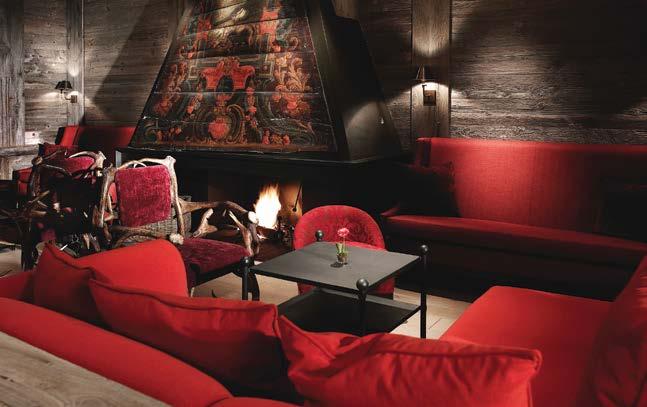
Everything essential for good rest is in place here –indoor and outdoor swimming pools, sauna, Turkish bath, and spa with relaxation and wellness procedures and programs. For those in search of new gourmet adventures, note the Michelin star owner restaurant L’Ours right beside the hotel.
L’Ours is run by the famous chef Franc Reynaud. This is truly a place of Haute Cuisine. All the dishes are made with fresh seasonal produce: if it’s season for truffles, they’ll make truffles. Lobster time is here? They’ll get the best ones for you. The restaurant is closed from Sunday night to Tuesday noon.
www.hoteletrier.ch; www.pasdelours.ch
GRAND HÔTEL DU GOLF & PALACE
The Grand Hotel initially served as cloakroom and a small restaurant for players of a then-newly popular game – golf. Nowadays this is a luxury hotel of interiors of natural wood furniture, simple gilding and heavy velvet.
This royal style is complimented by the fact that the Grand Hotel has hosted Spanish, Netherland and Belgium Royal Family members numerous times. The major draw of this hotel is its huge grounds surrounded by the Severiano Ballesteros valley.
In summertime, guests play golf on three hectares. The Grand Hotel is the real shelter of cosmopolitans who flock to the restaurants here: Le Chalet specializes in traditional cuisine, LE Baalbeck offers Lebanese specialties and Shangri-La offers features Chinese kitchen.
www.ghgp.ch
GUARDA GOLF
Guarda Golf is a tiny hotel with just 25 rooms and suites in designed in Alpine style. It's located just 5 minutes’ walk from Crans center in front of the Golf Club.

Guarda Golf houses two gourmet restaurants, however, the spa is the main source of pride. It offers exclusively the Brazilian brand Ivo Pitanguy to its clientele. The hotel has successfully passed Swiss Deluxe certification, which unites most the prestigious hotels of Switzerland.
www.hotelguardagolf.com

63 VOYAGER 5/2016
CRANS-MONTANA
OMEGA EUROPEAN MASTERS: TRADITIONALLY, THE NATIONAL GOLF TOURNAMENT IN CRANS-MONTANA TAKES PLACE IN SEPTEMBER.
GLACIER EXPRESS
Zermatt St. Moritz
Travel time: 7 hours and 45 minutes
The express service from Engadin to Matterhorn or vise-versa takes around 7.5 hours. There are faster alternatives too but if you want to have the best experience, you definitely need to choose the glacier express.
The slowest express is also one of the most famous in the world. It connects a couple of the best Swiss resorts – St. Moritz and Zermatt – and amazes its passengers with the country’s beau-
Recommendation
We advise you to buy a three-day travel pass flex (valid for one month) and to use it on all of the modes of public transport: trains, buses, ships from one region to another, public transport around the 75 Swiss cities, and get free entry into more than 470 museums
tiful landscape and engineering masterpieces. This red and white train goes through 91 tunnels and 291 bridges.
Don’t worry, you won’t miss anything as you can see the wonderful landscape from the panoramic wagons, including a 400 meter Swiss canyon, the Oberalp Pass and of course, the splendid Matterhorn.
ZERMATT :
GO UP TO THE GORNERGRAT GLACIER WITH A HANGING RAILWAY (3,089 M) AND END UP VERY CLOSE TO MATTERHORN, SURROUNDED BY 28 OTHER GLACIERS OVER 400 METERS HIGH
and receive a 50% discount off most mountain-railway tours for only 239.
If you have a day ticket, you can pay a 15 CHF supplement to travel on the world famous glacier express and Bernina express.
THE HIGHEST CABLE CAR IN EUROPE TAKES YOU TO MATTERHORN. THE PLATFORM OF THIS GLACIER, LOCATED 3,883 METERS HIGH, WILL CHARM YOU WITH THE MAGICAL WORLD OF SNOW.

64 VOYAGER 5/2016
TOURS

The Bernina Express connects the cold north to the warm south and easily overcomes steep slopes. This railroad is one of the most impressive in the world.
The Bernina Express goes through the Alps, which were passed by Hannibal’s army on elephants during his crusade.
From Kuri, the train goes up to Engadin, then through the Bernini pass (2,253 meters) and Poskiavo, and
BERNINA EXPRESS
KURI – TIRANO 4 hours and 5 minutes
DAVOS – TIRANO 3 hours and 50 minutes
ST. MORITZ – TIRANO 2 hours and 30 minutes
Lugano: You can reach the lake surrounded by palm trees from the glaciers that shine in the sun in just four hours!
The Popular Palm express connects snowy St. Moritz to Lugano, crossing the Italian border on its way. The yellow post bus drives you through very typical
later continues on its way through Italian territory from the Valterini ravine to Tirana. In total, the train passes through 55 tunnels and 196 bridges. From time to time, it goes up unimaginably steep slopes.
The railway routes of Albuli and Bernini that cross the Swiss-Italian border was included in the UNESCO World Heritage list in 2008 for the marvelous glacier Monterchi and spiral-shaped Viaduki Brusio
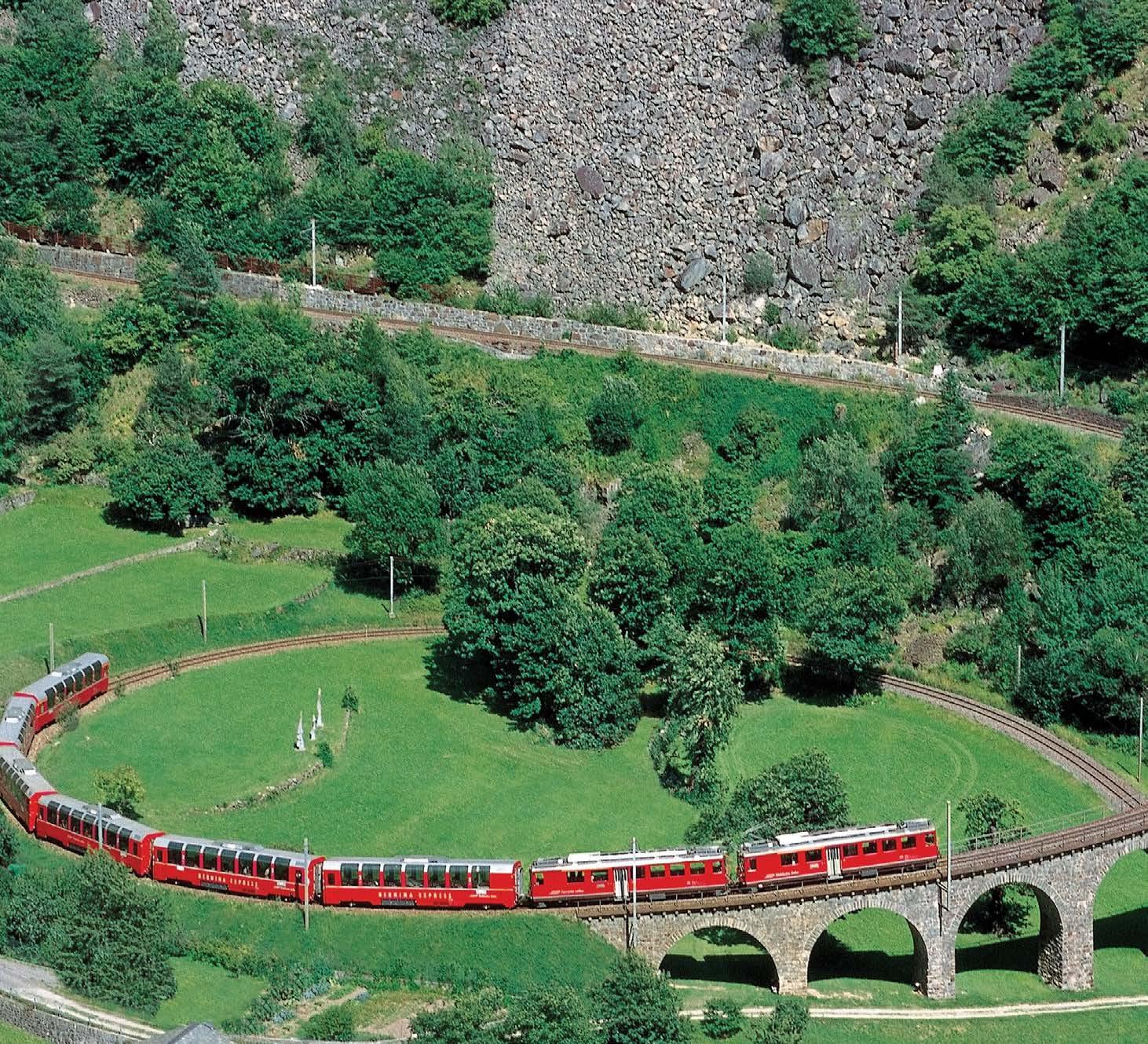
JUST IMAGINE A COUNTRY WHERE TRAVELING ON PUBLIC TRANSPORTATION GIVES YOU SUCH PLEASURE AND IS EQUAL TO RELAXATION.
Engadin villages, the romantic valley of Bergeli and the surroundings of Lake Como.
A cruise on Lake Lugano blends well with an excursion to Gandria, a small fishing village under the Monte Bre mountain, known for its elegant streets and restaurants located along the lake.
IF YOU LOVE TRAVELING, YOU ONLY NEED TO COMFORTABLY ENSCONCE YOURSELF IN THE PUBLIC TRANSPORT NETWORK AND THAT’S IT. THE MOST COMFORTABLE TRAIN WILL TAKE YOU AROUND THE WHOLE COUNTRY.
66 VOYAGER 5/2016
Population: 8 139 600
More foreigners live in Switzerland than in any other country in Europe. >1/5
Switzerland holds the second place in the world in terms of life expectancy, just behind Japan.
Average life expectancy:
Foreigners
Swiss nationals
Women ............. 86,1years
Men .... 80,5 years
Swiss GDP was $ 664.74 billion last year.
GDP per capita is $ 80,603.
The highest funicular station is located at an altitude of 3,820 meters – the Matterhorn Klein.
Aletsch glacier is the largest; it is 23 km long and is a part of the UNESCO World Heritage List.
SWITZERLAND
6% of Europe’s drinking water comes from Switzerland.
80% of drinking and industrial water supply comes from its groundwater sources.

Most of the fountains contain drinking water; its quality is constantly monitored.

56% of the generated energy comes from water.
40% of drinking water needs no processing before consumers acquire it.
The Swiss flag is the shape of a square; it is the only square flag in the word, if we do not consider the flag of the Vatican.
Neutrality is one of the key principles of Switzerland’s foreign policy. It does not engage in military conflicts or join military unions.

Switzerland has a network of mountain trails with a total length o f 62,000 km or more.
Approximately 23% of the territory is located at an altitude above 2,000 meters with 2% above 4,000 meters.
The Alps occupy 60% of the Swiss territory ; however, only 11% of the total population lives in the Alpine regions. 11%

67 VOYAGER 5/2016
STATISTICS
23.8%
76.2%
SWISS MADE
What is Switzerland? Switzerland is a small country in Europe, located mostly in the mountains. It was formed a long time ago and is probably distinguished for having the best of everything, like its old, private boarding schools, fruit jams, and other things.

Switzerland is a neutral country and neutrality has a long history of its own there. Switzerland is a country that was not destroyed in the 20th century, or in the time before; somehow, it was always peaceful, while the Swiss army was famous for its soldiers.
There were times when the Swiss army stood on both sides of European wars. While today the tradition is kept only in Vatican, where the guards are Swiss, it was a reality in the past; every door, every big entrance was guarded by the Swiss. The “Citizen Louis Capet” was guarded by the Swiss until the very end. This is why we
use the word “Swiss” to denote a bearded porter in a semi-military outfit that stands in front of hotels.
The Swiss were the people of war and different languages, different villages, free cities, science and justice; people of some kind of eternal trace of medieval taste and diligent work.
If a Swiss person puts one rock on top of another, these two rocks will stand forever. Not because these rocks are special but because very rarely do people put two rocks together for eternity. Very rarely do people take care of cheese in basements, as the locals do.
68 VOYAGER 5/2016
AKA MORCHILADZE
SWITZERLAND
@ swiss-image.ch
This is a country that was gradually created through negotiation and involvement of others; it was assembled from small lands. It is a country that has not been in war for a long time, though every man has been a soldier.
Every Swiss citizen who has ever served in the military or is in the reserve army has a government-issued machine gun at home. Switzerland has a population of seven million and not long ago had forty thousand soldiers. Now it has 280 thousand soldiers.
This is not just an expression of an old soul, but the viewpoint that no matter how peaceful your neighbors are, you must always remain on guard. Switzerland has so much and will have so much that this attitude is not surprising.
One Swiss, mustached old man told me that even Hitler did not dare to invade this country due to its country’s strength and readiness, and the old man was so sure of it that there was no point in arguing.
It is a beautiful country – very beautiful and colorful, with nature so tender, so strict that it often resembles a landscape painting.
A PLACE OF NETWORKS OF RAILROADS AND SERPENTINE ROADS, TUNNELS IN THE ALPS, SNOW, SKIS, RED CHEEKS, COWS, AND PEACE. PEOPLE HERE HAVE NOT CONQUERED NATURE: THEY HAVE JUST ADDED SOMETHING THAT WAS NECESSARY IN A CREATIVE AND COMFORTABLE WAY.
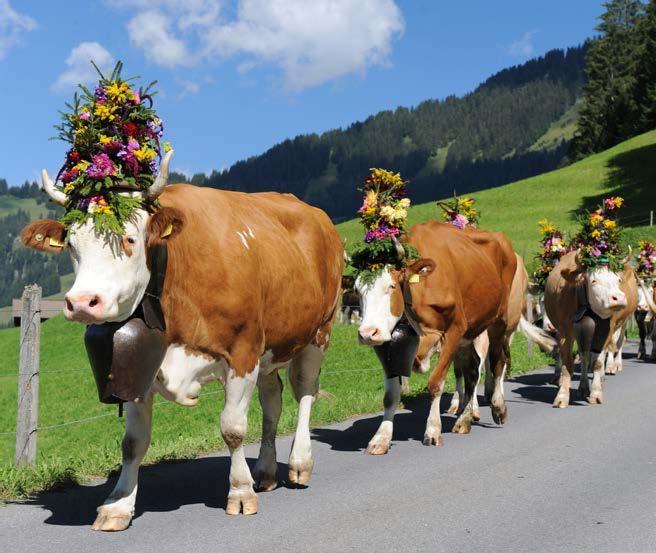

Everything in Switzerland has detailed legislation – even small matters. Every canton has its own constitution and people speak and write in four different languages. This is a country of referendums and direct democracy based on people’s choices.
People with character live here. They will never be untrue to their own selves, even for the greatest ideas, because they know that everything began a long time ago and everything should be arranged precisely and valuably.
The first time we touch Swiss culture is special. The first Soviet childhood Swiss memory is about the Swiss watch, “Omax” or something like that; a Swiss watch and Swiss clockwork – dependable, reliable.
I believe that a Swiss watch embodies many things, including Swiss banks. This watch will never stop and never mess up, just like the banks. Zurich’s money will never crack.
There are old sayings about “Swiss-made” and what not. The touch of a Swiss thing, the Swiss army knife Victorinox, the army knife that has been used for more than a century. You’d like to have it, though you’ll never use it. This is one of the rarest and
strangest knives in the world: it does not appear aggressive as a weapon, but is the most reliable, most needed and most easy-touse knife in the world. It is strange how it turned out this way. You can talk about the essence of Switzerland just by telling the story of this knife.
69 VOYAGER 5/2016
@ swiss-image.ch
And the cities, lakes and languages. The peace – the feeling that nothing goes on except mundane things, while huge history is behind everything. Sit down and light up a Swiss cigarette, in the mountains, in the middle of the winter season.
You’ll rarely see Swiss cigarettes abroad – maybe in Germany. Swiss cigarettes are different too; they don’t get common. Yes, they know a good taste here, they appreciate the flavor.
Switzerland has been a country that has united many nations for a long time and it has a corresponding cuisine: exquisite in the French canton, comforting in the German canton, fun in the Italian canton and tasty in every canton.



Switzerland has no coastline. God probably did not deem it necessary, as he placed numerous lakes in the Alps and the plateaus. Switzerland is a country were different cultures co-exist. So when you swim into the lake at one side and swim out at the other, you may find a totally different language and culture. You may even find yourself in an entirely different country.

70 VOYAGER 5/2016
PEOPLE WITH CHARACTER LIVE HERE. THEY WILL NEVER BE UNTRUE TO THEIR OWN SELVES, EVEN FOR THE GREATEST IDEAS, BECAUSE THEY KNOW THAT EVERYTHING BEGAN A LONG TIME AGO AND EVERYTHING SHOULD BE ARRANGED PRECISELY AND VALUABLY.
@ swiss-image.ch @ swiss-image.ch
Diversity is very close here and would be even closer if not for the mountains. The mountains are the real symbol of this country. They signify peace and at the same time host noisy winters.

They used to say in Tbilisi: here’s Mont Blanc, the highest point in Europe. Excluding our own mountains, of course. Mont Blanc is a white mountain and there are lots of monts there – Monte Rosa and what not, and Matterhorn among them, looking like the pointy hat of fairy tale character. They are the army of the Swiss, just like Caucasus is for us.
SWISS GUARDS
The Pontifical Swiss Guards (Cohors pedestris Helvetiorum a sacra custodia Pontificis) are the exclusive guards of Vatican City. Established in 1506 by Pope Julius II, it is the world’s oldest military unit.

At that time, Swiss guards were deemed the best soldiers in the world. Currently, the division comprises
Europe agreed that Switzerland had to be Switzerland in 1815 and no one was bothered by any kind of conqueror since, including Napoleon.
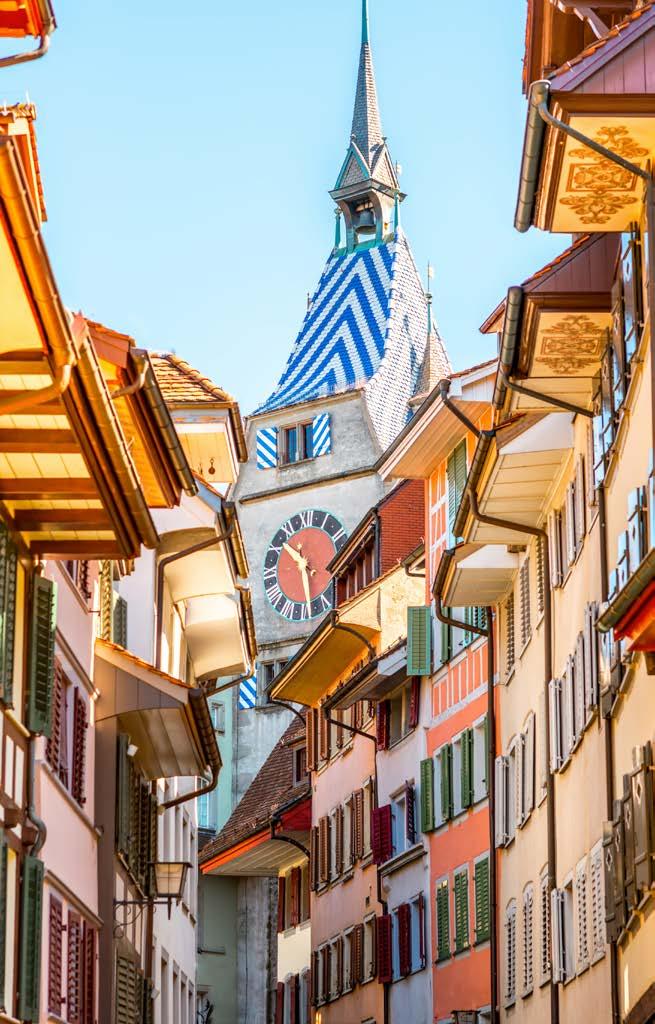
SWITZERLAND WAS OFFSHORE FOR A LONG TIME, BUT IT WAS ALSO OFFSHORE IN TERMS OF ITS SOUL, SOMEHOW STANDING ASIDE FROM THE CHAOTIC WORLD. HOW MANY FAMOUS PEOPLE LIVED HERE TOWARDS THE END OF THEIR LIVES! WE KNOW OF CHARLIE CHAPLIN, BUT THERE WERE SO MANY MORE! IT WAS NOT ONLY A RETREAT, BUT ALSO A SANCTUARY. OUR OWN GRIGOL ROBAKIDZE STAYED HERE TOWARDS THE END.
They say that the country is expensive. As the quote from an old film goes – everything good is expensive. Switzerland is a special country, different from everyone and everything, free and somehow steady. A great Swiss writer, Friedrich Durrenmatt, once wrote, when a state starts referring to itself as a homeland – the time for a great war is here. Who knows how it is somewhere else, but in Switzerland, you know for sure – this is a country where a state becomes a homeland with no war.
110 guards, trained by the Swiss armed forces. Guards are responsible for the safety of the Pope and his residence. To become a guard, one must be Roman Catholic, have undergone four months of mandatory military training, as well as possess a secondary education and be recommended by high church officials.
Potential guards must also be taller than 174 centimeters
and single, with short hair and a shaved beard. The official language of the unit is German. The age for recruits varies from 19 to 30 and duration of service can last from two to 25 years. Guards are allowed to get married after their first three years of service when they are granted the rank of a corporal.
However, their spouse must also be Roman Catholic.
71 VOYAGER 5/2016
A CARVED SPACE
Once travelling on a train, I found an interesting article in a French magazine. "Switzerland: a Mysterious Country by Our Side" wrote the author, astonished by the fact that Switzerland – associated mainly with chocolate, watches and cheese for the French – is actually a world-leader in creating and implementing technological innovations. The whole country is one great clockwork that develops in a harmonious and balanced manner all across its territory.
There are however, several unchanging aspects to Switzerland such as its famous Alpine scenery, in this otherwise multicultural and simultaneously united European country.
The Alpine scenery is compelling and simple: spotted cows, wooden houses on their stone foundations scattered over slopes. Lakes, trains, tunnels… But behind it lurks a sophisticated cultural mechanism, a national sense of intellectual prowess without pretention, all based on European philosophy and lifestyle of the most European country, where the three great cultures merge:
German, French and Italian. In addition of course, Switzerland has good financial resources but it is primarily driven by hard and productive work, order and education.
INFRASTRUCTURE
It is necessary to note another factor that led to this country's progress: a well-established and diverse infrastructure. Despite the difficult terrain and weather conditions, the Swiss have set their territory up just like Swiss watch: equipping it with tunnels, highways, power plants, cables, pipes – in short, everything to ensure that this giant "turbion" runs smoothly alongside of the beautiful scenery, green valleys and white mountains, underneath the big diamond of Mont Blanc.
SWISS ARCHITECTURE
You will traces of all architectural styles of European history in Switzerland, ranging from Neolithic structures and ruins of Ro-
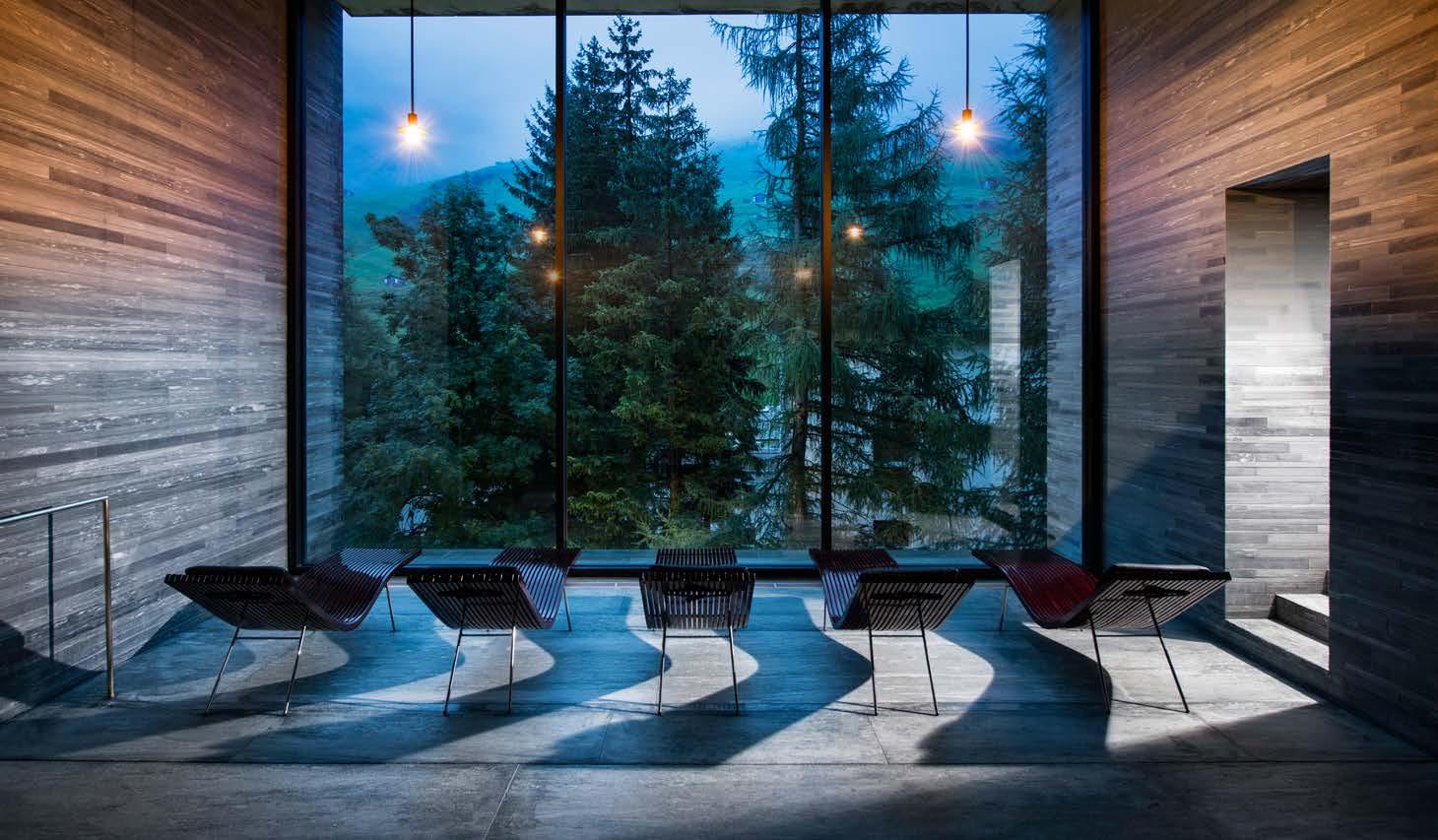
ARCHITECTURE
72 VOYAGER 5/2016
NIKA CHKHAIDZE
Therme Vals
man colonies to early Christian medieval buildings: the first of these dates from 350 A.D. Numerous monasteries were built in the Middle Ages while many of the dynastic families ruled their lands from castles.
During the X-XII centuries, the first towns with Gothic-style houses were built. In the rural areas, you can find traditional Swiss houses, whose choice of building materials and architecture changed with the altitude of the Alps.
The industrial revolution in the XIX century made the role of the engineers paramount. The Zurich Polytechnic Institute was founded in 1855. Many neoclassical buildings were constructed in this period.

Many Swiss architects had worked in various European countries from the Renaissance to the Baroque period, even the most influential Swiss architect of the XX century – Le Corbusier.


At this point, we come upon a very interesting fact: Le Corbusier, whose architectural modernist ideas swept like a storm across the world, from the Paris suburbs, through Gldani, to India’s Chandigarh, had limited opportunities in his own homeland. He only constructed one innovative building in Switzerland, which is simply a one-story villa by the Zurich Lake.
I don’t know what was the reason that the Swiss architecture followed a different path. Maybe the Swiss are generally quite traditional, and for this reason have tended to select a different architectural vision to that of Le Corbusier – in my opinion, a correct path. This disparity is interesting, as they say, the architecture of a nation reflects its inner state.
Modern Swiss architects rely mainly on an aesthetic generated by the phenomenological philosophies of Edmund Husserl and Martin Heidegger. They attempt to create a 'true' architecture free of anything modern or 'pretentious'. By this I am thinking of such architects as Herzog de Meuron, Gigon Guyer and Peter
73 VOYAGER 5/2016
“BEAUTY IS IN THE EYE OF THE BEHOLDER”
Therme Vals
"THERE IS A CERTAIN INTERACTION BETWEEN OBJECTS AND PEOPLE. THIS IS WHAT I TRY TO ACHIEVE AS AN ARCHITECT."
PETER ZUMTHOR
Zumthor. For them architecture remains as an object created in the 'Lebenswelt' and should be considered through numerous 'experiences'. Hence, every aspect of the building is important including how it fits into the environment, colors, materials, lighting and even the smell are approached phenomenologically. The works of acclaimed master of such approach-Peter Zumthor is particularly distinctive and interesting.
WITHDRAWAL
Phenomenology is a philosophical method of explaining the universe through the projection of subconscious onto exterior objects. Peter Zumthor might be considered the master of this approach. This method was mainly developed by German philosophers Heidegger and Husserl.
His architecture is uncompromising, honest and timid. He creates spaces where people live – where the sense of 'dwelling' is opened out. His goal as an architect is to put a stronger emphasis on the importance of regional architecture in the light of urbanization and globalization.
This is why the fact that this 'controversial' architect was awarded the Pritzker Prize in 2009 is very symbolic, since he truly is a local architect. On the slopes of the Alps with a small team, he is trying to create an authentic architecture that flies in the face of fleeting styles and ephemeral fashion. In his work you will not find anything similar to what the so-called starchitects are doing.
His small workshop selects the projects very rigorously; he pays great attention to working out the details and personally creates all of the blueprints. He is not looking for success, titles or awards. He is devoted to this approach because he loves architecture.
At the same time, his architecture is highly contemporary, basing its forms and solutions on a modernist style. Zumthor confesses to be a great admirer and follower of phenomenology. This is

how he describes his approach: "Once I was sitting in a cafe on a beautiful square of a lakeside town.
The square was surrounded by arcades and warmed by a midday sun. I was filled with a sudden feeling of joy. I asked myself: "What made me feel this way?" and the answer was - Everything! The Objects, the people, the air, the noise, the sounds, the colors, the forms, the textures and materials. And what else? My state of mind, my feelings. I realized that it is all inside of me. Then I closed my eyes and made this square disappear from my mind. Everything that I felt disappeared instantly. This led me to realize that the main thing that created my feelings was the atmosphere. There is a certain interaction between objects and people. This is what I try to achieve as an architect."
Peter Zumthor thinks that a good indicator of architectural quality is the atmosphere, created by a certain building – of a certain connection between the building and its environment that is emotional and not intellectual: a connection through space, matter, warmth, lighting, sounds and aroma. This is an attempt to harmoniously connect our whole beings and into unison with the outside world. This is where one can see a clear connection to Husserl’s idea of Lebenswelt- a “space-time” universe of objects, as we perceive them throughout our life; or Martin Heidegger’s idea of “existing in the universe” (Dasein in German).

He does not make 'landmarks' as such: he believes that the consciousness and the body are one inseparable being. Peter Zumthor creates a place where 'life' flows.
Childhood memories and personal impressions are very important to people. Their role in the development of architectural language is highly important as well. According to Peter Zumthor, one can be taught to re-express memories and subjective impressions in a form of architectural language just in the same way as you can learn a linguistic language.
ARCHITECTURE 74 VOYAGER 5/2016
ARCHITECTURAL SPACE SHOULD RECEIVE AND REGULATE ANY LIGHTING OR SOURCE OF LIGHT Bruder Klaus Kapelle (2007)
PHENOMENOLOGY IS A PHILOSOPHICAL METHOD OF EXPLAINING THE UNIVERSE THROUGH THE PROJECTION OF SUBCONSCIOUS ONTO EXTERIOR OBJECTS. PETER ZUMTHOR MIGHT BE CONSIDERED THE MASTER OF THIS APPROACH. THIS METHOD WAS MAINLY DEVELOPED BY
GERMAN
Zumthor's 'architectural language' can be summed up in 9 key points:
• Architectural language is anatomical; it resembles a body and its parts can be touched;
• It is physical – a harmonious relationship between many parts;
• It is acoustic – architectural space is like a musical instrument. It collects all of the sound vibrations, enhances them and alters them;
• It is thermal – the relationship between any space and the surface of material create a distinctive thermal effect;
• An architectural space that collects sensory 'ambiances' should regulate different kinds of 'limits'. For example, it should frame the outer view to minimize the differences between the interior and exterior;
• Architectural space should create intimate models by altering the relationship between scales in buildings between open and closed, distant and close, public and protected;
• An orderly and 'carved' architectural space should give bodies the means to roam freely ;
• Architectural space should be ready to host 'objects'. These objects should highlight and emphasize the initial architectural idea. Thus, a line of nails or a sofa emphasizes the colors of a wall or the shape of the windows;
• Finally, and importantly, architectural space should receive and regulate any lighting or source of light.
The highlights of Peter Zumthor’s projects are:
- Bruder Klaus Kapelle (2007)
- Kolumba Art Museum (2007)
- Therme Vals
- Saint Benedict Chapel (1988)

His works such as Therme Vals or the Saint Benedict Chapel are like sculptures carved from the monolith of reasoning and thought. The construction of the buildings is also like a sculptural process too. For example, to achieve the desired effect in the interior of Bruder Klaus Kapelle, a special coal was burnt on in the middle of the building for two weeks.


Starting from the 1960s, urbanization continuously creates 'junk spaces'. The poetic approach of architects like Zumthor opposes this trend. In order to preserve our connection to the environment, to our personal elements and our identity and within the framework of intensified globalization, we need to re-think our approach to architecture, spaces, and the environments in which we live.
In what kind of constructed environments do we want to live?
THE EXAMPLES WE FIND IN SWITZERLAND ARE VERY INTERESTING FOR US. THE NATURE OF THIS COUNTRY IS SO SIMILAR TO OURS. IF FROM THE HIGH SLOPES OF THEIR MOUNTAINS THEY COULD SEE THE WORLDWIDE ARCHITECTURAL 'MADNESS' AND DEVELOP THEIR ENVIRONMENT IN THE OPPOSITE DIRECTION, WHY CAN’T WE?! HARMONY AND PROPER DEVELOPMENT CAN BE ACHIEVED THROUGH HARD WORK AND PERSEVERANCE. SWITZERLAND AND ITS ARCHITECTURE IS A GREAT EXAMPLE OF THAT!
Saint Benedict Chapel (1988
75 VOYAGER 5/2016
PHILOSOPHERS HEIDEGGER AND HUSSERL.
FIRST TIME IN SWITZERLAND
LASHA BUGADZE
I was 17 when I visited Switzerland for the first time.
It was in 1995.
My father was 38 years old, just like I am now. He was an artist who had lived in Basel for a year. He painted on extraordinarily huge canvases, in his extraordinarily light and big studio.
He would have probably stayed in this city for a long time, but he got plagued by pragmatically inexplicable, though emotionally understandable nostalgia and homesickness for his apathetic motherland…though that's a different story and he’ll probably write about it in his book. Switzerland for me is always associated with this first visit.
At the same time, I believe that Switzerland has to be the country that is associated with my latest impressions, just like I have learnt from literature (and culture in general) and history.
For example, Herman Hesse, a precious influence on my teenage years, spent his last years in the Swiss village of Montagnola. An entry gate to his house carried a polite, yet strict note: 'Bitte keine besuche' ('please, do not visit'). Legend has it that Thomas Mann
“... Ich denke viel an Sie, Ihre sanfte Frau, Ihr schönes Haus, seine Landschaft und die mit Ihnen verbrachten wohltuenden Stunden. Ich war recht leidend damals, aber ich kann sagen, dass ich ruhiger und wohlgemuter geworden bin und meiner Arbeit nachgehe wie vorher. Ich habe meinen Kampf durchgekämpft”.
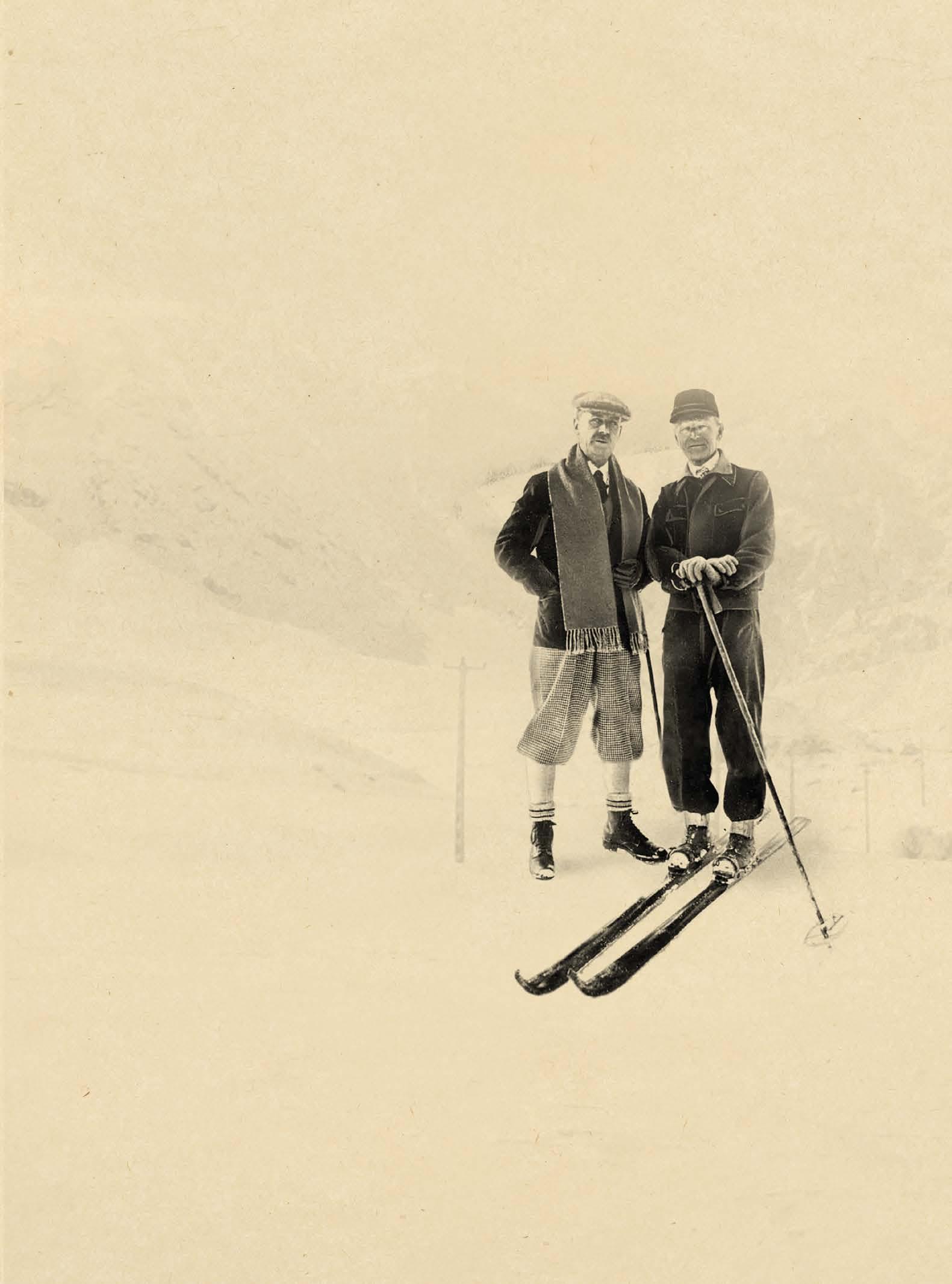 Hermann Hesse - Thomas Mann: Briefwechsel
Hermann Hesse - Thomas Mann: Briefwechsel
STORY 76 VOYAGER 5/2016
came by and left another note: 'All right, I will stop by the next time'.
Mann also moved to Switzerland towards the end of his life. He would not rest until his wife bought him a chair that was exactly like the one he had had in the USA. Katia Mann claimed that he wrote Dr. Faustus in that chair.
He got used to Switzerland only after he received his comfortable seat. When the American chair arrived at last, it came along with an army of genius emigrants – retired writers, conductors, philosophers, actors, politician and others.
They would surround the novelist who sat in his mysterious chair and listen to the fragments of his new story with great interest (and, let’s be honest, with occasional naps)…
Vladimir Nabokov, the writer who lyrically described pedophilia, also headed here when he got old. A statue of him sitting down was erected in the garden of the hotel where he used to sit during the end of his life.
It’s a bit uncomfortable for me to talk about my experiences after writing about these people, but I have to tell you how disappointed I was with Switzerland during my first day there. Remember what was going on in Georgia at that time, in 1995?
No electricity, cold, depression…that’s when I got transported not just to another country, but it felt, to another century and another planet.

Do you want to know what happened on that other planet?
The power was cut on the very first day! Right when I stepped inside a hot, regular-functioning shower, for the first time after 1990, as back at home we had to use water heated by the 'Atmore'--a device created by Georgian physicists that allowed only weak spurts of water; every now and again that water would conduct small amounts of electricity as well.
The other option was to take baths, as my grandma used to say, like courtesans from the Balzac novels: in the tub placed in the middle of the room. Just when I thought that the Swiss shower would wash away all of my 1990s sadness, the water became cooler and finally turned into a cold stream…
I thought that I had brought the Georgian curse to Switzerland and destroyed their version of the ninth electricity block. I felt even worse when I saw people’s shadows on the wall – Swiss friends visited my father to congratulate him with a holiday unfamiliar to me (and thus unacceptable). Unfamiliar (and thus, unacceptable) were their carnival clothing, the candles they had in their hands and masks that they wore. One of them had a drum over his shoulder (the kind that Oskar Matzerath has in the Günter Grass novel); he drummed with the drumsticks.
Everyone was very happy that we had no electricity and celebrated this lifestyle for several days. The unfamiliar holiday was called Basler Fasnacht. It was a tradition that got established centuries ago and now we had to live the next four or five days as if we were in the Middle Ages…
I thought I came to the future from Georgia, but I was transported back to the William Tell era!
I spent the next five days daydreaming of the Georgian physicists’ 'Atmore'.
But then the Fasnacht was over and my first impression and experiences really began. I was first paid for my work in Switzerland: the artist Andro Vekua and I cleaned the Goetheanum yard in the Dornach village and received a good pay for it. I visited my first McDonald's in Switzerland. I was very impressed. My Swiss acquaintances were very upset: they could not understand the shock that the Soviet teenager experienced when tasting absolutely foreign and novel food. I will never forget my reaction when I tasted a Big Mac for the first time. I think President Shevardnadze had the same sort of face when he first bit into a Big Mac at the opening of the McDonald’s in Tbilisi two years later.
I organized my first exhibition of graphic work here though I was unable to sell much. The hall was by our studio and everyone who came over for the exhibition looked inside the studio and acquired my fathers’ paintings. I bought my first CD in Switzerland (I used to collect vinyl recordings before) and started the life-long dilemma of 'is this performance better than the other?'
And finally, the most important thing: Switzerland was the place where I fell in love for the first time…the idea that everything comes to an end in Switzerland is false.
This is the country of beginnings.
77 VOYAGER 5/2016
EDUCATION
The Ambitious Charm of Swiss Education
MARIKA SHALIKASHVILI
SWISS EDUCATION IS SWITZERLAND’S CALLING CARD, JUST LIKE SWISS BANKS THAT WORK LIKE CLOCKWORK, IMPECCABLE WATCHES, DELICIOUS CHOCOLATE AND LUXURY WINTER RESORTS.
100,000 SWISS AND 100 STUDENTS FROM OTHER COUNTRIES ARE EDUCATED AT "SWISS FEDERATION OF PRIVATE SCHOOLS, SFPS 240”.
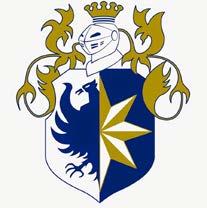
THESE SCHOOLS’ LONG HISTORIES AND FLAWLESS REPUTATION, AS WELL AS THE MULTICULTURAL SOCIETY OF SWITZERLAND WITH ITS HIGH QUALITY OF LIFE, EDUCATION AND POLITICAL STABILITY, IS WHAT DEFINES THE “SWISS RULES” OF EDUCATION.
AS IN OTHER CULTURES, DEMANDING TEACHING METHODS AND HIGHQUALITY INSTRUCTION IS VALUED HERE.
THE 15 MOST EXPENSIVE SCHOOLS IN EUROPE ARE LOCATED IN SWITZERLAND AND THE UK, ALTHOUGH SWITZERLAND IS THE CLEAR LEADER.
Le Rosey is also called the royal school due to the high number of a noble children who have attended it. The Shah of Iran, King Farouk of Egypt, and Rainier the Prince of Monaco have all studied here. The annual fee is 117,000 CHF; it is considered the world's most expensive school. This prestigious school’s history spans 135 years and, like Eton in Britain, is the unrivaled leader in education in the country.
The four hundred students of Le Rosey come from 63 countries; among them, 5 percent are British. The children of Elizabeth Taylor, John Lennon and Sir Roger Moore have studied there, as well as the grandchildren of the Duke of Kent and Winston Churchill. You may encounter Rothschilds and Borgheses there today.


The XIV-century château is located near Lake Geneva, covering 114,000 sq. meters, including 10 tennis courts, steam baths and saunas. The Le Rosey campus consists of a number of buildings.
There is a 1000-seat concert hall, a stable, a yacht and a fitness center on campus. From January to March, the winter school campus moves to Gstaad, where students practice winter sports after studying.

Lessons are conducted in English and French. One of every three applicants gets accepted. Unlike British boarding schools, Le Rosey is managed like a private business.

78 VOYAGER 5/2016
Gstaad Campus
EDUCATION LEVELS
Kindergarten was optional in a number of Swiss cities until recently, though children that attend kindergarten are believed to acquire the necessary skills to go to school and are much better equipped. Children of 5-6 years of age are considered kindergarten age.
They continue their education at a primary school from the age of 7. The methodology is regulated by each canton, and can sometimes dramatically differ from one other. On average, primary school education lasts 8-9 years.
Gymnasiums (varying according to canton) provide education in the native language, foreign languages, algebra, geometry, history, geography and other disciplines.
90 percent of Swiss youths (220,000 adolescents) that graduate from high school continue in further education.

MOST CHILDREN IN SWITZERLAND ATTEND A PUBLIC SCHOOL, WHERE EDUCATION IS PARTLY FUNDED BY THE STATE.

THE SWISS AUTHORITIES ANNUALLY INVEST CHF 31 BILLION IN EDUCATION.
SWISS TEACHERS ARE THE HIGHEST PAID IN EUROPE (SECOND ONLY TO LUXEMBOURG). A HIGH-SCHOOL TEACHER’S INCOME CONSTITUTES 90,000 CHF A YEAR, WHILE NEIGHBORING COUNTRIES PAY BETWEEN 46,500 CHF AND 48,300 CHF.
Switzerland's main state education institutions are the two universities under the control of the confederation – the two technical schools located Zurich and Lausanne: "The Swiss Federal Institute of Technology in Zurich" - Eidgenössische Technische Hochschule Zürich (ETHZ, 10 000 students) and "Lausanne Federal Polytechnic School" - École Polytechnique Fédérale de Lausanne (EPFL).
SWISS NATIONALS HAVE BEEN AWARDED 20 NOBEL PRIZES IN NATURAL SCIENCES.
A bachelor’s degree is received after three years of education. Courses are taught in French, German and Italian, according to the region. Master's students learn for a year and a half or two; courses are becoming more frequently delivered in English. To earn a doctoral degree, the student begins to work on research, which takes another three or four years on average.
RATING OF WORLD UNIVERSITIES:
ETH ZURICH – SWISS FEDERAL INSTITUTE OF TECHNOLOGY

ZURICH „შვეიცარიის ფედერალური ტექნოლოგიური ინსტიტუტი ციურიხში“, N9 ÉCOLE POLYTECHNIQUE FÉDÉRALE DE LAUSANNE „ლოზანის ფედერალური პოლიტექნიკური სკოლა“, N30
UNIVERSITY OF BASEL – „ბაზელის უნივერსიტეტი“, N98
VOCATIONAL EDUCATION
Swiss vocational schools offer about 250 specialty subjects. The long list of professions is based on research indicating the popular fields of work. Two-thirds of young people choose vocational education. Student have internships in specialized establishments three or four days a week.
Especially popular professions include: trade managers, nurses, assistants in public educational work, cooks, programmers and electricians.
Vocational education lasts three or four years. Sectoral education is the last stage of vocational education. It prepares young people for administration and industry and increases their chances of high-paid employment.
UNIVERSITY OF ZURICH – „ციურიხის უნივერსიტეტი“, N106
UNIVERSITY OF BERN – „ბერნის უნივერსიტეტი“, N110
79 VOYAGER 5/2016
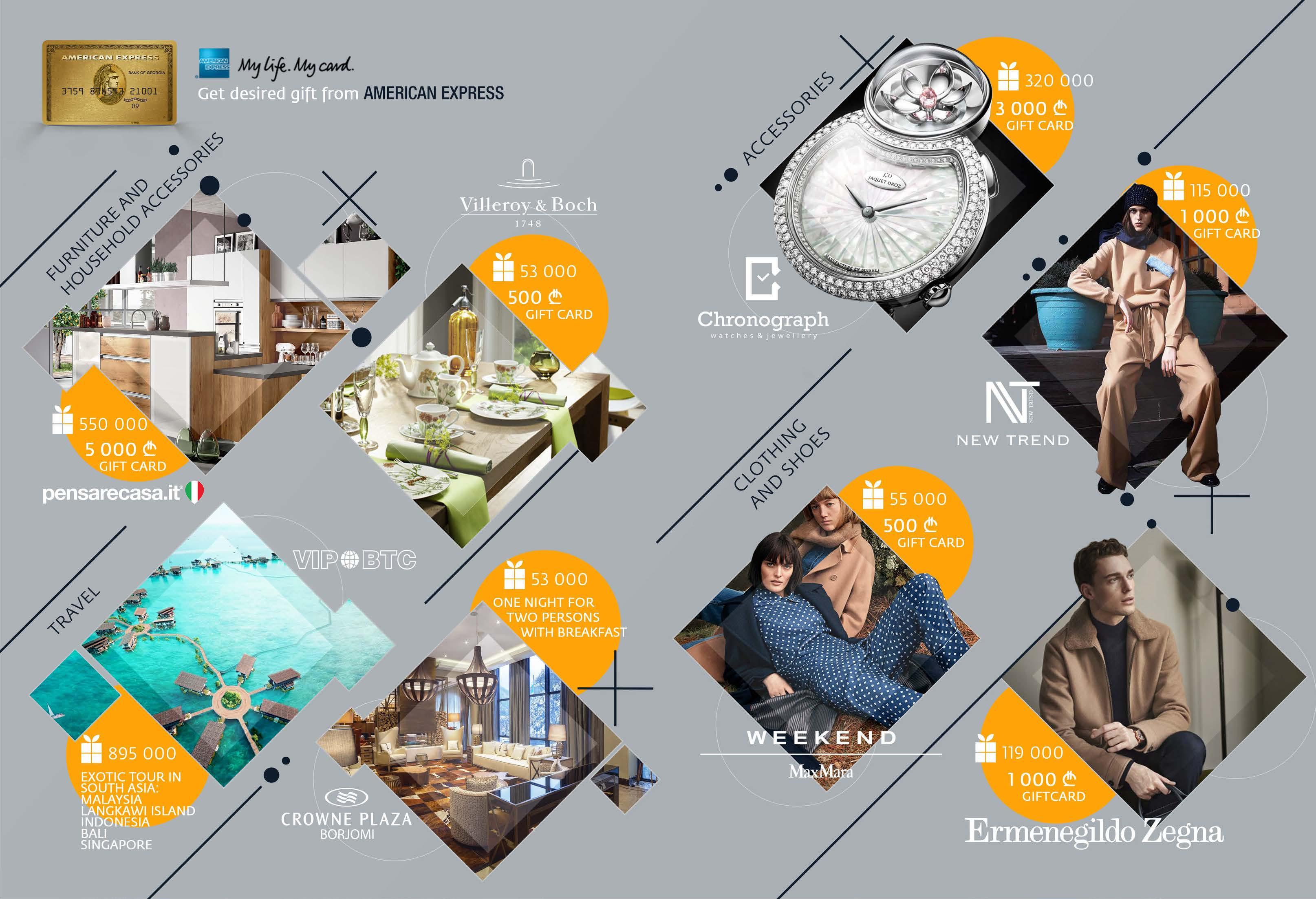

THE NOBLE DRAGON
2001, Wimbledon. The fourth round of the world’s most prestigious tennis tournament. A former champion and the ATP recordsman (14 Grand Slam titles) Pete Sampras is playing against a rising star, Roger Federer, who won the Wimbledon junior championship in 1998.
Is it Roge or Roger? Is he Swiss? - The journalists ask.

They do not know yet that in a few hours, this grueling five-set tennis thriller will result in the loss of the favorite player (6-7, 7-5, 4-6, 7-6, 5-7) and, with it, the end of the Sampras era!
THIS MAN SAYS HIS NAME IS ROGER. ONE OF THE STREETS WILL BE CALLED ROGER FEDERER ALLEY IN 2012, IN THE GERMAN CITY OF HALLE. HE WON’T WIN HERE, BUT HE WILL RECEIVE 17 GRAND SLAM TITLES, BREAKING SAMPRAS’ RECORD, AND LIKE A MYTHOLOGICAL KNIGHT WILL BECOME A DRAGON HIMSELF. A NOBLE DRAGON, HOWEVER...
SPORT
82 VOYAGER 5/2016
BIDZINA BARATASHVILI
I was surprised when I flew to Basel in May to attend the final of the Europa League. I was surprised even before I saw Saint James Park, an ultra-modern stadium, a cathedral and dozens of fountains scattered across the city. It turned out that Basel airport was not located in Basel, or even Switzerland, but is situated in the French Mulhouse territory and it is the only airport in the world that is co-financed by two states.
The organizers warmly received us and on the second day planned a tour of the city for us, during which the local chamber orchestra accompanied us as we walked the streets. Then they gave us a ride in a streetcar that was made at the beginning of the last century, showed us Roger Federer’s house, and told us interesting stories about him.
It’s not surprising that the local tennis complex bears the name “Federer”. Roger is the first Swiss to win a Grand Slam tournament and helped the national team win the Davis Cup (2014.) For the first time in history, the government issued a postage stamp of a living person. It depicted Federer at Wimbledon with the cup in his hands.
He really deserved it. However, I thought it was unusual that they also called the tram and the train after him.
Jacob Hlasek and Bulgarian Manuela Maleeva (who was married in Switzerland).
Federer has mixed heritage and dual citizenship: Roger’s mother, Linette Du Rand, was born in South Africa. Despite the fact that her quadrilingual son (English, French, German, Swiss German) initially competed only for Switzerland, South Africa cheered for him also.
Roger Federer was born on August 8, 1981 in Basel. Therefore, it is logical that his favorite number is 8, and his favorite animal is his zodiac sign – Leo (the lion)!
As you know, the lion is the king of animals, and Rogers has more than 40 titles (Betterer, Maestro, Fedex, Federer Express, Masterer, Teacherer, Professorer, Goderer, Rogerer, Winnerer, Greaterer, Swisserer, etc.). One of them is bound to be royal. Indeed, he is called King Roger in England. However, he is not a typical lion: he was vegan before he was 13 years old.
He has admitted that he has liked fondues since childhood, which he can still eat all day long. He is also fond of strawberry ice cream and Lindor chocolate truffles; he neutralizes the harmful effects of carbonated water by brushing his teeth three times a day.
Roger’s first coach, a 37-year-old Australian Peter Carter, who trained Roger since he was nine years old, died in a bus crash in South Africa in 2002. The 21-year-old Federer heard about it in Toronto and was very upset.

In 2005, he invited Peter's parents, Bobby and Diana, to the Australian Open and has been paying their travel fees every year since (Adelaide to Melbourne, first class). They always sit on the center court, right behind Federer’s personal coach.
Federer was asked to shake hands and take a commemorative photo with a cancer survivor, Beatriz Tinoco, in connection with The Make-A-Wish Foundation. Instead, Roger flew the whole family to Wimbledon, met her parents and introduced them to his close friends, Juan Martin Del Potro and Rafael Nadal, and even gave Beatriz some private coaching.
One of the main strategies of modern Swiss sports is relying on immigrants and their descendants for national interests. More than half of the national soccer teams has roots in Africa, Central and South America, the former Yugoslav countries and Albania. The same is true of tennis. In 1992, a Swiss team won the Hopman Cup for the first time. The winning duo were Prague-born
IN 2011, THE REPUTATION INSTITUTE SURVEYED 25 COUNTRIES AND FOUND FEDERER TO BE “THE MOST TRUSTED, BELOVED AND RESPECTED MAN” AFTER NELSON MANDELA. EVERYBODY CLAIMS THAT HE IS HUMBLE AND NOBLE.
83 VOYAGER 5/2016
In this context, it is unclear why the Swiss open annual tennis tournament organizers keep supplying him with local cows. It happened for the first time in 2003:
ROGER RETURNED HOME TRIUMPHANTLY FROM WIMBLEDON AND WON THE TOURNAMENT IN GSTAAD; HE WAS AWARDED WITH JULIETTE THE MILK COW. UNLIKE HER SHAKESPEAREAN NAMESAKE, ROGER’S JULIETTE LIVED HAPPILY EVER AFTER AND MOTHERED A CALF THE NEXT YEAR; ROGER CALLED THE CALF EDELWEISS.
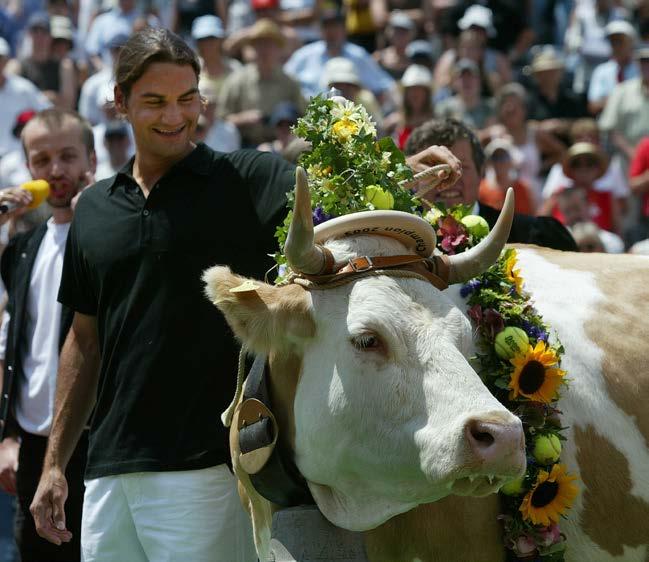
Meat-hating Roger could not decide whether to pursue a tennis or soccer career until the age of 12. He remains the biggest fan of the local “Basel” team and only misses St. James Park matches when he is overseas. He prefers to rest at home, in the Alpine village of Valbella and in the south of Zurich, in his villa in Wollerau. He also likes to travel further, to Dubai or the Maldives, and engage in his favorite activity: teaching his children to swim, playing video games, attending piano recitals to relax, and racing in Mercedes cars. He is terrified of rollercoasters.
Federer has been amazingly goal-oriented since his childhood. Roger’s friend and doubles partner, Yves Allegro, recalls in Rene Stauffer’s book “The Roger Federer Story: Quest for Perfection” that “Teachers asked us about our dreams when we were 16 years old. We all wished to get into the first top hundred, while he claimed, that he was going to get into the top ten, followed by being number#1 on the ATP! I started looking at him differently, from that day on”.
Federer’s triumphant ascent was not easy. At the beginning of the 1990s, Roger got involved in a junior tournament for the first time and suffered a terrible disappointment in the Basel’s children tournament: three years older Reto Schmidli won 6-0, 6-0.
“To be honest, I do not remember the game. I think I was 13 years old, and Rodger was 10” recalls Schmidli. The victory did nothing for him in sporting terms; he now works in the Basel police. “I still live in a suburb of Basel. I have never dreamt of being a professional tennis player. I decided to be a policeman, since this job requires risk and quick thinking too. People recognize me in the streets of Basel often, they smile and ask, you’re the one who won 6-0, 6-0 against Federer?!
Some might even feel in their hearts that Roger made millions, while I am just a policeman, but that doesn’t bother me. Personally, I have great respect for him. Unlike other athletes, the money has not changed him, he is as humble as before. I met him twice and both times he greeted me like an old acquaintance ".
It should be noted that Federer played against a Georgian tennis player Irakli Labadze in 1998 during the junior Wimbledon finals and won 6-4, 6-4.
He did not get past the quarter finals in his first 16 Grand Slam tournaments; however, he improved his game and broke record after record afterwards!
ANNA WINTOUR, EDITOR-IN-CHIEF OF AMERICAN VOGUE AND THE MOST INFLUENTIAL WOMEN IN MODERN FASHION, HAS NEVER MISSED A FEDERER MATCH SINCE 2002. SHE CHEERS ROGER, TOGETHER WITH MIROSLAVA FEDERER, AND IS HIS BIGGEST ADVISER IN TERMS OF HIS FASHION CHOICES. THANKS TO ANNA WINTOUR, FEDERER IS A FREQUENT VISITOR OF HIGH FASHION WEEKS AND A BELOVED RESPONDENT OF FASHION MAGAZINES.

4 dro SPORT
84 VOYAGER 5/2016
17 wins in Wimbledon, the Australian, French and US Open championships in singles; 10 finals in a row in these most prestigious competitions; six years summative tournament; Davis and Hopman cups; and Olympic gold and silver!

FEDERER HAS NEVER STOPPED BECAUSE OF INJURY ON THE FIELD OF PLAY. COLLEAGUES SAY HE DOES IT OUT OF RESPECT FOR HIS RIVAL PLAYERS, HE DOES NOT WANT TO UNDERPLAY THEIR SUCCESS!
Let’s also touch upon his personal life:
Roger is married to a tennis player Mirka Vavrinec (she was born in Slovakia but has lived in Switzerland with her family since she was 2). Mirka played for the Swiss tennis team and it was there that she met Roger, while they were preparing for the Sydney Olympics in 2000. They have only played together once, in 2002, during the Hopman Cup, which Roger won the previous year with Martina Hingis as his pair. This result was not repeated and later that year Mirka quit tennis altogether due to an injury.
The couple were married at Wenkenhof Villa in Riehen, near Basel, on 11 April 2009, in a small circle of friends. On July 23, their twin daughters were born, Myla Rose and Charlene Riva, and on May 6, 2014, the twin sons, Leo and Lennart!!! It is interesting that in 2010, Diana, Roger’s big sister also became a mother of twins.
TWO PAIRS OF TWINS IN ONE FAMILY HAS A MATHEMATICAL PROBABILITY OF A 1:700,000!
JOHN MCENROE
APTLY JOKED ABOUT IT: FEDERER EASILY OVERCOMES

EVEN THE MOST DIFFICULT TASKS!
Two pairs of twins in one family has a mathematical probability of a 1:700,000! John McEnroe aptly joked about it: Federer easily overcomes even the most difficult tasks!

In short, if necessary, the new generation of Federers can play all types of tennis (singles, doubles, mixed) and who knows, might even beat their father's records as well!

35-YEAROLD ROGER FEDERER MAY NEVER WIN AN 18TH GRAND SLAM, BUT THERE IS NO DOUBT THAT HE HAS BUILT AN IMPRESSIVE CAREER AND PERSONAL LIFE. IN THIS SENSE, HE IS THE GREATEST PLAYER TO EVER HAVE SET FOOT ON A TENNIS COURT!
85 VOYAGER 5/2016
AN OASIS OF RELAXATION
TEA SKHIERELI
Health and well-being--historically, these were the two main reasons why Switzerland was visited not only for skiing, but also for a longer stay. Everything here serves the protection of one’s own well-being, both physical and financial. One couldn’t find a better relaxation place than the Swiss sanatoriums in the nineteenth century. Long before Davos hosted the World Economic Forum, it acted like one big health center.
Robert Louis Stevenson wrote the last chapter of "Treasure Island" in Davos; this place had become a major setting for the action of Thomas Mann's "The Magic Mountain". Today, sanatoriums act like recreational resorts or spa-like resorts, but the
essence remains the same--visit Switzerland to rest and improve your health! Seventy specialized hotels and nine certified wellness resorts offer health programs based on fitness, hydro, thermal and cosmetic procedures as well as nutrition and relaxation.
Everything necessary for active or passive recreation is provided - the highest level of medical and sanitary procedures for a wide range of treatments, a "smart aging" program, wellness, excursions to beautiful places, healthy, delicious meals, etc. The goal of such resorts is not only to make guests feel better but also to teach them to take care of themselves.

SPA 86 VOYAGER 5/2016
TSCHUGGEN GRAND HOTEL AROSA
Guests of this top hotel will enjoy stunning views; take the Tschuggen-Express train to reach the Arosa ski resort.

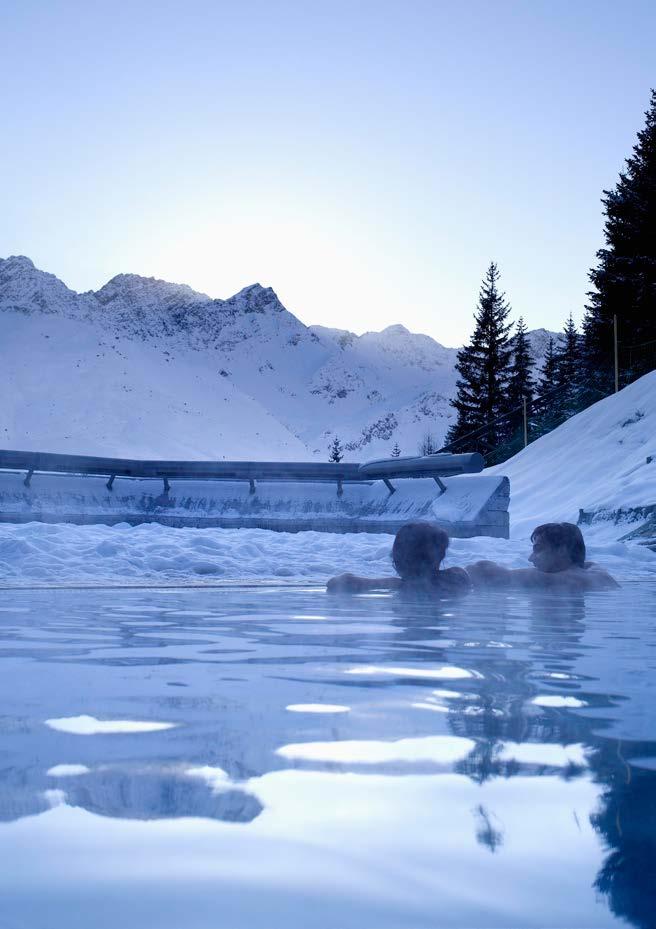
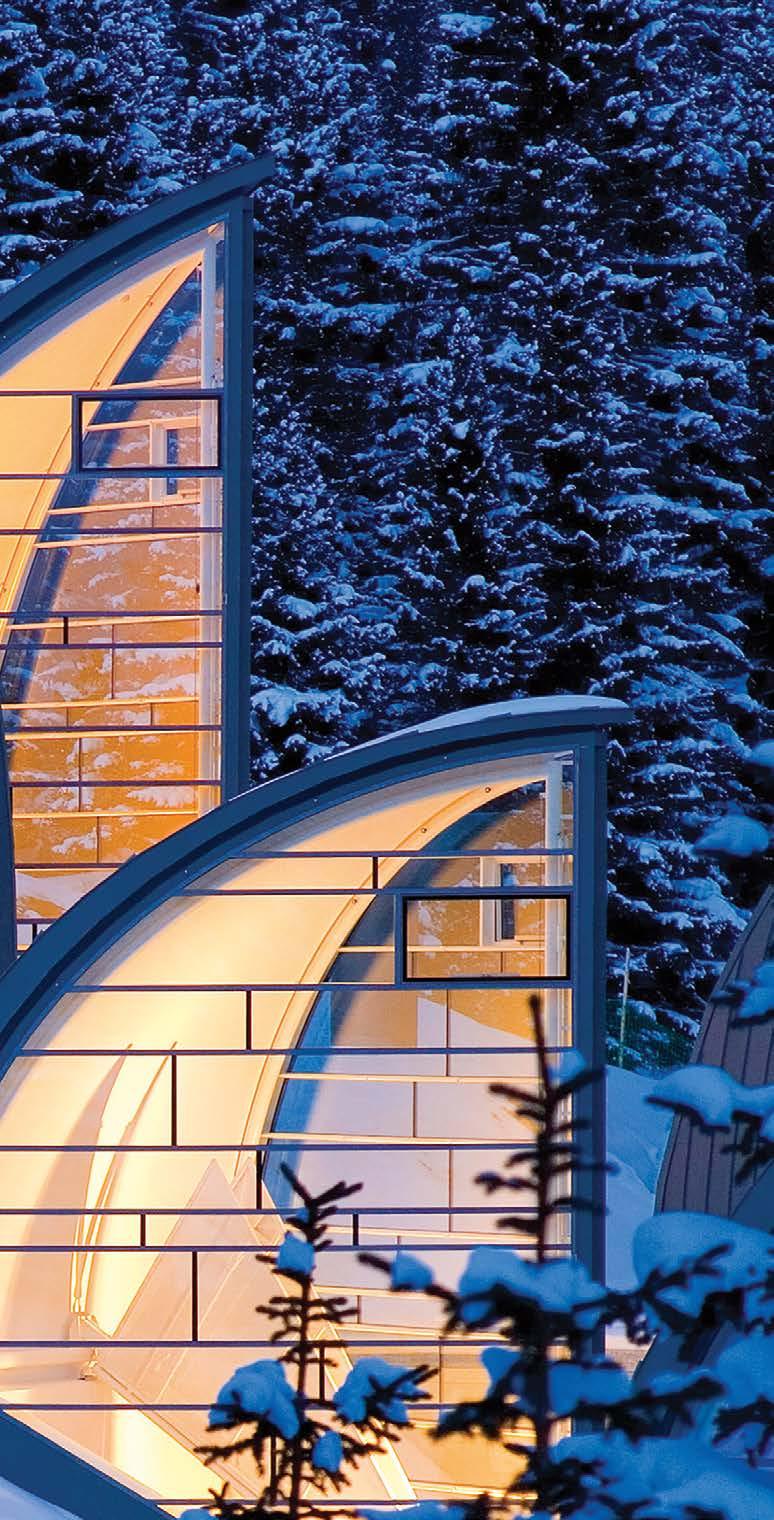
130 rooms were designed by Carlo Rampazzi, while the 5,000 sq. m wellness complex was designed by the famous Mario Botta.
It offers four floors of a magical world of water and wellness (Tschuggen Bergoase) that is steaming and flowing. Aesthetic procedures, stone caves, a private spa, medical wellness, fitness, meditation rooms and a fireplace are waiting for you.

Price: starting from 327 CHF.
Sonnenbergstrasse, Arosa www. tschuggen.ch
THE HOTEL'S OWN RAILWAY ALLOWS GUESTS TO PROMPTLY REACH THE SKI TRACKS.
AROSA IS LOCATED SOUTH OF DAVOS, IN THE MOUNTAINS (1740-1920 M) WITH CLEAN DRY AIR; IT IS ESPECIALLY GOOD FOR THE TREATMENT OF ANEMIA AND LUNGS. IT HAS A SUNNY, WINDLESS, AND FOGLESS CLIMATE.
87 VOYAGER 5/2016
MINERALBAD & SPA
Rigi Kaltbad
People have been taking baths in this small settlement for 600 years.
Celebrity architect Mario Botta designed this spa complex for relaxation; it is the best place for revitalization; there are pools, a spa, steam baths with grass, a relaxation area and lounge where mineral water rises and an underground "crystalline pool" where the light comes from crystal-like windows.
You may visit Mineralbad & Spa via cable car from Weggis or by mountain railway from Vitznau.
Rigi Kaltbad
www.mineralbad-rigikaltbad.ch
ENGADINE BAD
Scuol
There are more than twenty mineral water (drinking and medicinal) sources in Scuol and its surroundings. The Engadine Bad thermal center retains the historical appearance of the old Roman and Irish thermal baths.



Here you can enjoy the Swiss National Park, Tarasp fortress, ancient buildings and rich ethnic culture of the Engadine valley.
Everything is mesmerizing - large pools, jacuzzi, steam rooms, historical bathing rituals (soap brush massage, moisturizing cream massage) and a semi-darkened relaxation room, where guests, wrapped in sheets or blankets, enjoy the mountain scenery.
Via dals Bogns 323 www.engadinbad.ch
LA RÉSERVE
Genève
This luxury hotel, located on the shores of Lake Geneva, offers magnificent rooms designed by Jacques Garcia. It has two restaurants (French and Japanese). With its exclusive 2,000 sq.m. wellness complex and children's center, 17 beauty cabinets using La Prairie products, indoor and outdoor pools, hammam, sauna, solarium, aromatherapy suite and tennis courts, this hotel is for followers of a healthy lifestyle.
Route de Lausanne 301
www.lareserve.ch
OBERWAID KURHOTEL & PRIVATKLINIK
St. Gallen
This hotel has a medical center, where doctors use the latest technologies and treatment methods, creating a real paradise.
It offers a beautiful panorama of mountains and the Boden Lake, surrounded by well-kept gardens and parks.
Three restaurants - Seeblick (lake view), Parkblick (Park View) and Stübli - provide easily digestible “smart” food.
There is also a wonderful, large super modern wellness zone.
Rorschacher Strasse 311
www.oberwaid.ch
LIMMATHOF NOVUM SPA
Baden
Romans enjoyed the local thermal waters 2,000 years ago. Nineteen spas are located by the Limath River.
Limmathof Novum Spa is a true wellness oasis.
Guests are offered a pool and whirlpool, a Turkish bath, Doctor Kneipp therapeutic baths and private spa rooms; the local atmosphere and elegant design make your holiday unforgettable.
The mineral-rich water temperature is always 47 degrees. Its healing properties make you feel physical and spiritual harmony.
Bahnhofplatz 1
www.baden.ch
SWITZERLAND IS THE IDEAL PLACE FOR THE COMBINATION OF WINTER SKIING AND SPA.
S P A 88 VOYAGER 5/2016
LE GRAND BELLEVUE
Gstaad
The charm of the Swiss Alps is displayed here on a palm of a hand. You will leave the world-class spa, which offers a diversity of salt-saturated steam-cabin procedures, completely transformed and revitalized.

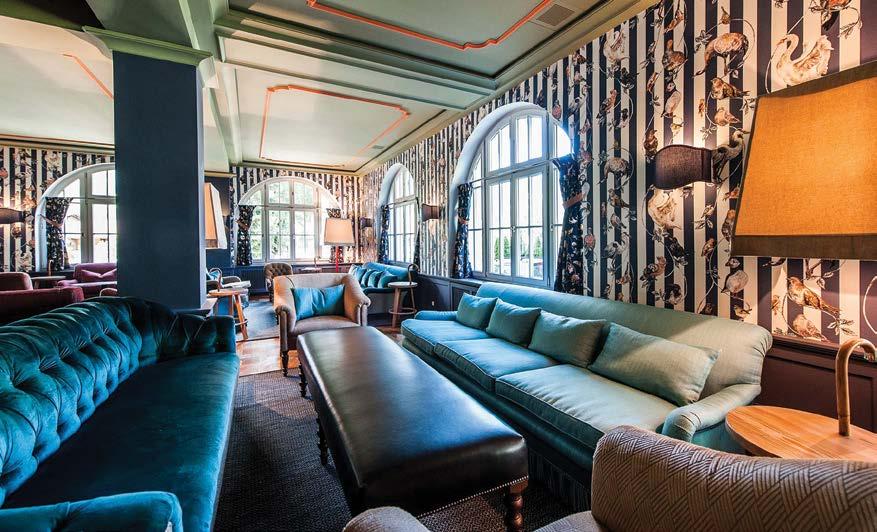
This recreational space is a real paradise: the world-class center stretches over 3,000 sq. meters standing out with its amazing opportunities. 11 procedural rooms and a skilled professional team of therapists will provide services that you couldn’t dream about.
However, before getting tension-relief massages, we recommend that you first visit the closed pool and jacuzzi, and then receive a treatment tailored personally to you.
In fully furnished procedure rooms, you can either start body revitalization exercises, get tanned or even study the basics of yoga. In short, you will leave this place feeling beautiful and inspired.

YOGA AND PILATES
“Le Grand Spa" team offers Europe's most famous yoga teachers’ special annual program to its customers. Yoga exercises take place in the bright yoga studio or in the nearby garden, from where you can see a breathtaking view of the Alps.
In addition, spa-cuisine chef, Urs Gschwend, has created a carefully calculated diet for the body's full recovery and purification. All of this gives the effect that no other similar institution can offer.
Untergstaadstrasse 17
Architecture lovers from around the world travel to this small village in the Graubunden canton. The spa resort is a unique masterpiece – a structure made of 60,000 greenish quartz stones. It is not only an embodiment of wonders of design but also a health palace.
30-degree water with healing minerals, aromatic steam baths, caves, hot and cold baths are all placed in the architect Peter Zumthor’s building, which is protected by the state.

7132 Vals www.7132.com
Recommendation
THE RHINE, WITH OZONE-PURIFIED, HEALING SALT WATER SPRINGS, COMING FROM DEPTHS OF 1,000 METERS.
BAD
YVERDON- THERMAL LAKE RESORT WITH BEACH SAND; ITS WATER CONTAINS MINERALS AND ESSENTIAL OILS.
LEUKERBAD- THE MOST PRESTIGIOUS SPA IN SOUTHWEST SWITZERLAND OFFERING A DIVERSE SELECTION OF INDOOR AND OUTDOOR BATHS, A JACUZZI AND A SAUNA.
SCUOL- SUNNY, HOT SPRINGS RESORT (1,250 M) OFFERS MAGICAL HOLIDAYS IN ANY SEASON.
LAUSANNE PALACE (LAUSANNE) - THAI, CHINESE, KOREAN MASSAGE AND MOROCCAN RELAXATION TECHNIQUES.
 7132 THERME Vals
ZURZACH- ANCIENT CITY ON
7132 THERME Vals
ZURZACH- ANCIENT CITY ON
89 VOYAGER 5/2016
LA PRAIRIE
From 1932, Clinique La Prairie is the only business in Europe offering the full complex of aesthetic medicine: diagnostics, exclusive cosmetics, plastic surgery (face and body shaping and rejuvenation, breast restoration), the Beautymed program for men and women (blood circulation, body reinforcement, manual massage, electrical stimulation), daily fitness and water gymnastics, and its expert rejuvenation program of revitalization through sheep embryo extract (CLP) injections, which strengthens the immune system, restores healthy cells, improves the hormonal metabolism, and stops the growth of cancer cells.
Clinique La Prairie has the latest equipment, which is backed up by the latest computer systems. It is recognized as a world-class laser surgery center.
Rue du Lac 142, Clarens-Montreux www.lapraiirie.ch
LEMANIC
The anti-aging program offers a unique blend of medical, surgical and aesthetic services. Rejuvenation and general improvement procedures are conducted through vitamin therapy and the use of purified cell extracts.
The aesthetic dermatology department works on skin rejuvenation, offering BEST (global endogenous recovery method), radio wave or wet lifting, Botox, cellulite correction, cryolipolysis, hair recovery etc. The laser surgery unit offers cell renewal procedures, the treatment of blood vessels, scars or acne, permanent hair removal, wrinkle correction and physical recovery.
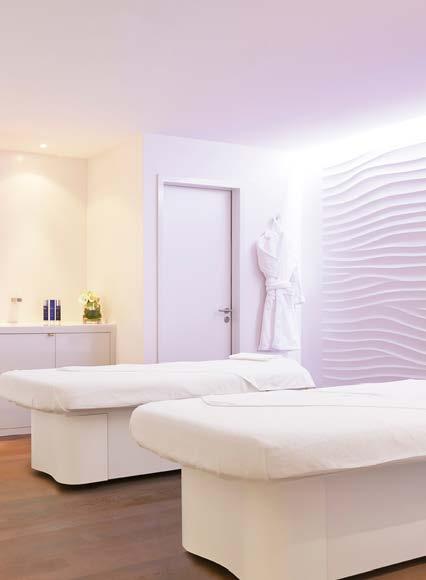
You can get involved in a program using oriental medicine and the European technology called Derma-SPA, which can greatly transform your muscles and skin.
Avenue de la Gare 2, Lausanne www.cliniclemanic.ch
This sunny, peaceful oasis alongside Lake Geneva provides a bio-molecular energy recovery method, a protein weight-loss program and the only Givenchy spa in Switzerland, where unique baths, saunas, jacuzzi and health procedures are waiting for you.



It is located in the center of the Lavaux region. Here, a luxurious vacation is combined with health care. Hotel Mirador has a concept of including treatment in its nature, where customers are offered the highest level of medical services as part of their vacation.
Here you can find dermatology, allergy and laser therapy clinics that offer anti-aging procedures through biological agents: a gentle lifting, Botox, wrinkle recovery, removal of spots and dead cells etc.
LE MIRADOR
Mirador 5, Chardonne www.mirador.ch
90 VOYAGER 5/2016 CLINICS
LA PRAIRIE
THE SWISS CONFEDERATION (LAT. CONFOEDERATIO HELVETICA) IS A FEDERAL REPUBLIC.
AREA: 41,293 KM2.
Distance from north to south: 220 km, from east to west: 348 KM
BORDER LENGTH: 1,881 KM.
Switzerland borders France to the west, Germany to the north, Austria and Liechtenstein to the east, and Italy to the south. THE HIGHEST VILLAGE IS JUF (GRAUBÜNDEN) AT 2,126 M; THE LOWEST VILLAGE IS ASCONA (TICINO) AT 96 M.
LARGEST CITIES: ZURICH - POPULATION 336,800; GENEVA - POPULATION
173,500; BASEL -POPULATION
168,700; BERN - POPULATION 122,700; WINTERTHUR - POPULATION 102,123; LUCERNE - POPULATION 57,000
Switzerland's population has doubled since the beginning of the XX century. Nearly three-quarters (74%) of the population reside in cities.
10% OF THE WORLD'S BILLIONAIRES LIVE IN SWITZERLAND. ZURICH AND GENEVA ARE IN THE TOP THREE OF THE WORLD'S MOST EXPENSIVE CITIES.
The country follows Central European time in winter. From the end of March to the end of October, the country moves to Daylight Saving Time – CET +1.
Switzerland has MORE THAN 1,500 LAKES. They are so PURE that in many places it is possible to drink the water directly from the lake.
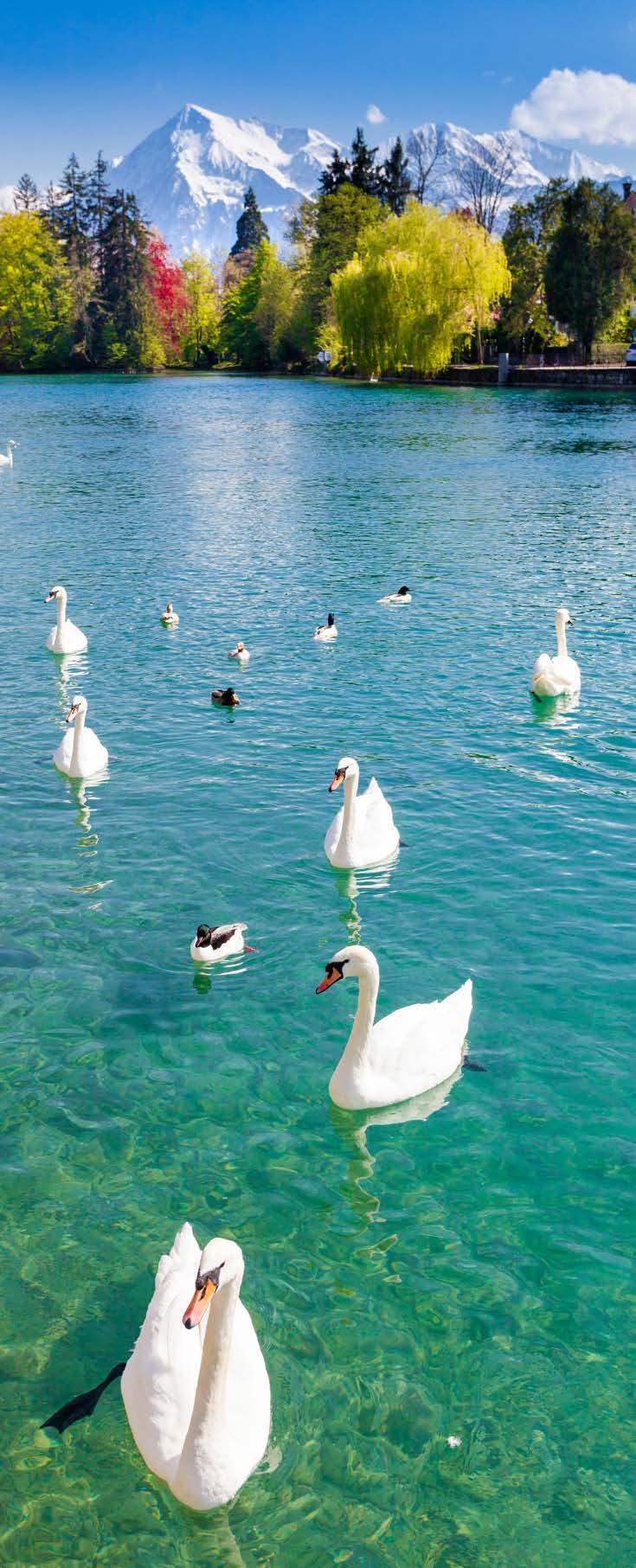
THE BIGGEST lakes: LAC LÉMAN, CONSTANCE LAGO MAGGIORE, LAKE
ZURICH The Rhine, Rhône, Ticino (Poe) and Inn (Danube) rivers originate in Switzerland’s takes. NATIONAL PARKS TAKE UP 14% OF THE COUNTRY’S TERRITORY. WHEREVER YOU ARE IN SWITZERLAND, THERE WILL SURELY BE A LAKE OR A RIVER WITHIN A 20 KM RADIUS.
91 VOYAGER 5/2016
ON THE VERGE OF COSMETICS AND MEDICINE
SALOME DADUNASHVILI
Switzerland has become a leading country in skincare and body revitalization. Here, body and soul are cured by the fresh air, clean water and beautiful mountains and the leading clinics, which were among the first to start an anti-aging campaign and have reached considerable success in this field. Swiss Line, the world-famous company that creates anti-aging skin care products, is located in Switzerland.

When Prince Michael Massalsky decided to found his own cosmetics company in 1989, he knew precisely what challenges women faced at the end of the 20th century.
“I had the advantage of being able to build up a picture of what the consumer really wanted and visualize the direction in which the industry was heading. Add the fact that the world’s population is getting older, and it became clear to me that anti-aging skincare would become a leading trend”.
Massalsky decided to start his company in Switzerland – the cleanest county in the world; its scientific base and natural resources are the ideal support to become a leader in the industry.
Prince Michael Massalsky had substantial experience before he founded his own company. He worked for Revlon and La Prairie for decades.
“Unlike in other countries where skincare has evolved based on fashion and fragrance, in Switzerland, medical and pharmaceutical research has created a deep understanding of cellular metabolism and its relationship to premature aging and this has fed into the development of skincare ingredients with a results-orientated focus.”
“WHEN I DECIDED TO START MY OWN BEAUTY BRAND, I KNEW EXACTLY WHAT I WANTED TO FOCUS ON – ANTIAGING SKINCARE. THIS IS HOW SWISS LINE WAS CREATED.”
PARAMEDICINE 92 VOYAGER 5/2016
“When I started Swiss line, I entered into a partnership with Dr. Alfred Pfister of the renowned cellular revitalization clinic, Clinique Lemana in Montreux”. The company was founded as a result of this partnership.
Swiss Line was very popular since it was the first product that gave the same effect as injections carried out in clinics. Its original formula contained stabilized cellular animal extracts, though in 2002, the brand scientists discovered biotechnology that enabled them to replace the animal extracts with plant extracts. This discovery was ahead of its time, and this is how Swiss Line reached a leading position.
“The timing of the scientists was perfect,” expands Michael. “The skincare industry was starting to focus on biotechnology and it was becoming clear that botanical extracts would be the future of skin care. At the same time, consumers’ perception of skincare was that animal extracts were old-fashioned and less desirable, in addition to being less ethical”.
“What makes Swiss line products stand out from those of our competitors is this guiding philosophy to combine back-to-nature simplicity with paramedical sophistication,” proclaims Michael proudly. His fanatic devotion to his work, pedantic attitude, and his own skin stands witness to his claims. Both men and women actively use Swiss Line today. Swiss Line products are a natural choice for them, since they are intended for both male and female use and do not have a strong odor, which accompanies many other cosmetics.
Today, alongside the original anti-aging Cell Shock range, Swiss Line offers Cell Shock White, with added brightening ingredients specially developed for Eastern skins; Force Vitale, containing elements inspired by the Alpine Ecosystem; and Water Shock, a cleansing range based on Swiss “wild water” from UNESCO’s Biosphere Reserve in Entlebuch.




“OUR GOAL IS TO PROVIDE HIGHQUALITY COSMETICS AND TO REMAIN INNOVATIVE LEADERS. WE WISH TO BRIDGE THE GAP BETWEEN COSMETICS AND MEDICAL SCIENCE.”
“WHAT MAKES SWISS LINE PRODUCTS STAND OUT FROM THOSE OF OUR COMPETITORS IS THIS GUIDING PHILOSOPHY TO COMBINE BACK-TO-NATURE SIMPLICITY WITH PARAMEDICAL SOPHISTICATION.”
93 VOYAGER 5/2016
“Our goal is to provide high-quality cosmetics and to remain innovative leaders. We wish to bridge the gap between cosmetics and medical science”.
“We wish to answer the ever-changing needs of skin in the 21st century”. To reach this goal, the company emphasized urban detox. Modern cities face the challenge of ecological stress. Swiss Line product help the skin to get rid of these toxins.
“My favorite product remains the Cell Shock Face Lifting Complex, which is one of our classics and bestsellers. To make it even better, we have now updated it with the addition of the Urban-Detox Complex, on top of its original formula. Facial serums such as these can be used day and night under moisturizers for a ‘minifacelift’ effect”.

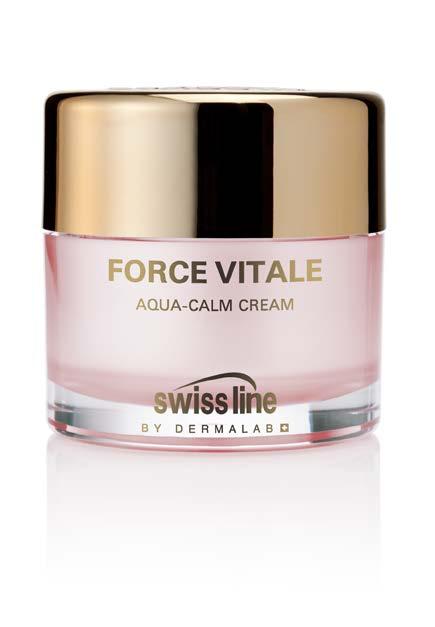
Swiss Line proudly presents two new and unique products: two essences containing the Urban-Detox Complex. Essences serve to prime skin to enhance the effects of all other products consumers use afterwards, while keeping skin moisture levels high and addressing signs of skin fatigue.
In order to serve clients better, Swiss Line offers an online questionnaire which helps consumers determine which Swiss Line product better suits their skin.

Swiss Line is proud of the fact that their products contain as much active ingredients as the test versions that are used in clinics during trials to define its efficacy. This determines the high price of their products and its high effectiveness.
Swiss Line’s skincare golden capsules has long been a luxury item. This magic treatment lights up the face and creates the effect of rested, young skin.
THIS PRODUCT IS JUST LIKE SWITZERLAND WHERE AMAZING NATURE COMBINES WITH HIGH TECHNOLOGIES.
DEEP KNOWLEDGE ABOUT MOLECULAR METABOLISM AND ITS EFFECTS ON ANTI-AGING WAS REVEALED BASED ON MEDICAL AND PHARMACEUTICAL RESEARCH.
PARAMEDICINE 94 VOYAGER 5/2016


Beauty Salon Frank Provost 22' Abashidze Str. +995 577 47 14 15; +995 597 99 55 22 E.mail: swissline@swissline.ge Find us on Facebook: Swiss Line Georgia
COMPETITION WITH OWN SELF
The Winner Receives Michelin Star
DADUNASHVILI
Guests of Hotel Dolder Grand ask for the best and receive the best. It's run by a native German chef, Heiko Nieder, who's the owner of a two Michelin Star restaurant. He is a real artist

His dishes are not only delicious, but also very beautiful, to the extent that you have to deliberate whether or not you’d like to destroy such a beauty. Our meeting is held on 9 A.M, which is mid-afternoon for Chef Heiko. He's already made most of the arrangements of his day, though his phone keeps ringing. He humbly apologizes as his eyes wander to the phone.
Chefs were not so popular when you started working in the industry. What was your motivation at the time?
I started cooking because I just love working with ingredients. I knew that I could do it. I loved the taste, smell, feel of it all – I wanted to be in this space. I was 14 years old when I first prepared food at home. My grandmother was a cook in a canteen that served butchers. She used to take me with her to the kitchen; though it is impossible nowadays, I preferred running among the pots to being in kindergarten.
Once my friend, a chef, asked me to help him prepare a big dinner and that is when I understood the value of working with excellent ingredients. I also love eating and maybe that’s the real reason why I became a chef (laughs).
Chefs and home cooking has become a new trend this last 10 years. The TV and Internet have made novel recipes popular and available. It's regarded as a good thing now. Only housewives used to cook at home in the past.
Today, young people stay at home and cook. I think more and more people will get involved in home cooking. They will visit restaurants for special food this is why I believe that chefs will stay popular. However, I feel sorry for the young chefs that face more difficult challenges – real life, I suppose.
What’s real life?
Something very hard and fantastic (laughs). I wake up at 6 A.M. but go to bed between 1 and 2 A.M. I may
96 VOYAGER 5/2016
SALOME
CHEF
I love good ingredients, I feel so happy when I see a wonderful lemon or a good fish, and I like to touch them.

sleep for an hour more during my holidays, but I have two small children and they won’t allow it. I am up all day, running around, plus great responsibility. That’s a chef’s life.
The mentioned tendency is probably due to the availability of all the ingredients. People look for inspiration in new tastes. What is a source of inspiration for you?
I am inspired by the diversity of ingredients. I love good ingredients, I feel so happy when I see a wonderful lemon or a good fish, and I like to touch them. I can’t travel much in search of the ingredients, due to my work schedule, so the produce is brought to me. Sometimes I call the suppliers and ask them: 'what do you have that's new? Please give me something special', and that’s what they do.
Seasonal cooking is also a trend. Do you cook seasonally?
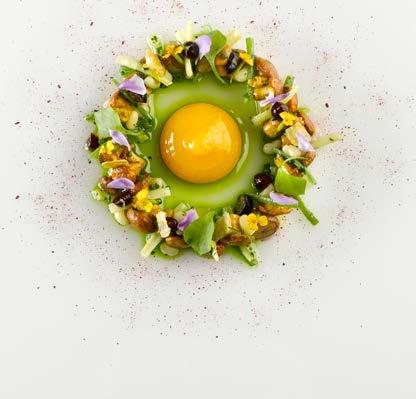
Seasonal cooking is paramount for me and our menu changes several times a year. We use only the best local produce. However, we can’t base our dishes on local ingredients exclusively, since our clients expect the finest and we have to use the world’s resources to present them with exiting food. We have to have the best caviar, scallops and oysters. This can run into pricing issues. The government manages the economy in Switzerland, so for example, if it is decided that only locally produced strawberries have to be sold this year, the country’s borders shut down and the taxes are so enormous that the imported goods are 10 times more ex-
pensive. The same goes for butter – we use so much butter! We have to manipulate these factors all the time. On the other hand, Switzerland has wonderful meat on offer. Ultimately, you have to plan carefully what you’re serving.
What dish would you recommend to taste when we visit Switzerland for the first time?


The cheese is the best here. You are aware that there are different sorts of cheeses. When I came to Switzerland, I understood that I had not tasted real Swiss cheese before. This cheese is not exported –Jersey Blue, Gruyere etc. You have to visit Switzerland if you want to taste the best quality cheeses.
Fondue is the most traditional dish but I also love graupensuppe – lentil soup; it is a delicious traditional soup. Also raclette, of course, though you have it taste in a good restaurant.
What about drinks, do you pair Swiss wine with your dishes?
Yes, we sell quite a large amount of Swiss wine and we offer it alongside the dishes. San Pietro is my favorite wine at the moment. Wine, just as cheese, is rarely exported and you won’t be able to try it anywhere but Switzerland. Additionally, small wineries only sell wholesale. They won’t sell you wine if they don’t know you as a client. The same goes for other produce as well
97 VOYAGER 5/2016
I BELIEVED THAT THE DISH HAD TO SPEAK FOR ITSELF. HOWEVER, WHEN I ARRIVED HERE, I LOOKED AROUND AND UNDERSTOOD THAT THE CLIENTS OF THIS RESTAURANT NEED SOMETHING MORE EXCLUSIVE.
WHEN I FIRST ARRIVED HERE, I WENT TO SEE THE MEAT SUPPLIERS. THEY HAD THE BEST VENISON. I WAS RUNNING BACK AND FORTH, SELECTING THE MEAT AND THEY LOOKED AT ME STRANGELY. LATER, I LEARNED THAT I WAS NOT A CLIENT FOR THEM – THEY ASSESSED WHETHER OR NOT THEY WANTED TO DO A BUSINESS WITH ME. THAT HAPPENS OFTEN IN SWITZERLAND.
Your dishes are so beautiful; that must be an additional talent.

I used to not decorate the dishes, I did not have many assistants. I believed that the dish had to speak for itself. However, when I arrived here, I looked around and understood that the clients of this restaurant need something more exclusive. Hence, I started developing in that area and now I like decorating food.
High class restaurants today present culinary shows. Restaurant is not just about eating food anymore. People need fun and surprise – what is your attitude?



I believe that if the dish is not super delicious, it does not matter what it looks like. Of course, we try to surprise and entertain the client, but a dinner should not turn into a Disneyland. This is a wonderful restaurant that uses only high-quality ingredients. We will offer you an aperitif before the menu. As you look through the menu, you will understand what to expect after the aperitif. It will turn into an evening to discuss, a dish to talk about. The taste should take diners away from the mundane. After 3 hours, when they leave, diners should remember not the taste of every dish, but that they have spent a wonderful evening.
Which dish makes you proud?
A lot of them and they change seasonally. At the moment it is mushrooms. I don’t like them much, but I prepare them very nicely (he shows me an entrée of exceptional beauty on his phone). I have to undergo 100 steps to make this dish. Every flower is delicately arranged on the plate. We also have wonderful lobsters
and I recommend trying them. It’s the white truffle season from September till the end of the winter. We prepare truffles with mountain potatoes; black truffles and eggs in wine are also very popular.
This profession is a big responsibility. Preparing 550 dishes a day is a very serious challenge but nothing motivates you to develop, if you have no inner engine that is always on. You have to compete with yourself all the time. That's how you deserve the stars and this is how you retain them. I taste every dish and tell my sous chefs that 'you have to savor your dishes, this is the key to perfection'.
98 VOYAGER 5/2016
CHEF
CHEESE, BREAD AND A GOOD HEART
NINO LURSMANASHVILI
Perhaps no other cuisine in the world is as comforting and enjoyable as Switzerland’s. In a country with fourofficial languages, local dishes have Italian, French and German influences. Everyone knows fondue, an‘interactive’ dish for sharing. What could be better thansitting around with friends, with a pan full of hot melted cheese and fishing for small pieces of bread in the yellow cheese lava? It is not surprising that cheese is the mainingredient of most of the dishes.
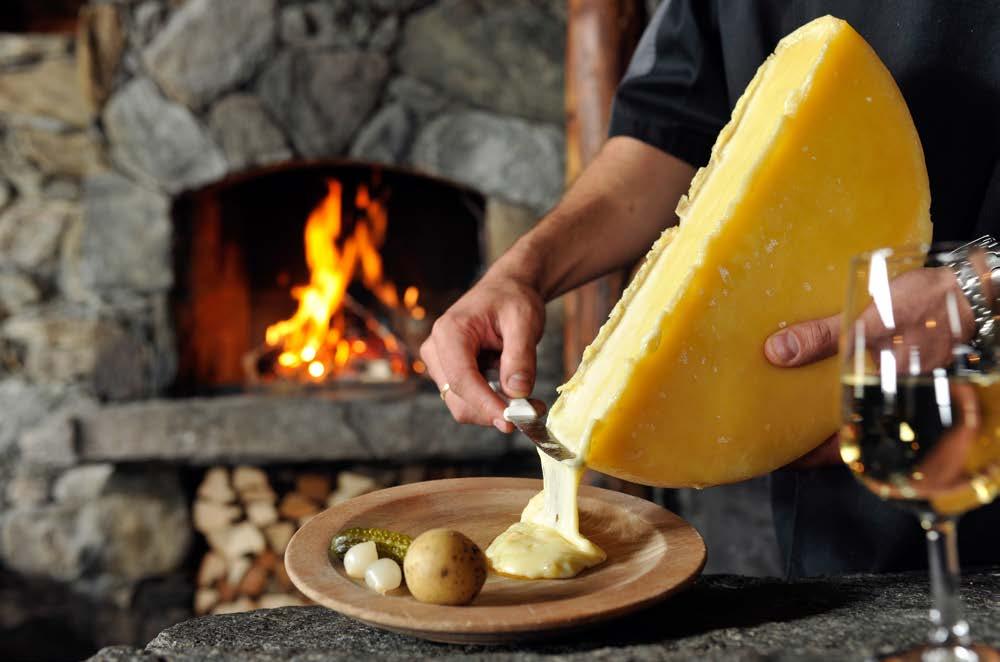
Fondue has become ahallmark of Swiss cuisine. It was created in responseto the cold Swiss winter and thanks to farmers’ ingenuity. Mountain villageswere cut off from the outside world, and village barns contained large numbers of dried cheeses by the end of the winter that could only be eaten melted. The previous day's left-overs were added to the dish, including boiled potatoes, bread, white wine and flavorings.
Today, every region has its own recipe for fondue. There is a Burgundy-style fondue (Fondue Bourguinonne), with simmering butter and beef pieces, accompanied by sauces, pickled cucumbers and onions.Aged cheeses (mostly aromatic, such as the easi-
THE FIRST SURVIVING FONDUE RECIPEWASWRITTEN IN GERMAN IN 1699. ITS TITLE WAS "HOW TO BOIL WINE WITH CHEESE",BUT THE SWISS KNEW HOW TO PREPARE RACLETTELONG BEFORE THAT. THEY BELIEVE THAT THE NAME ORIGINATED INTHE FRENCH WORD RACLER- “TO SCRAPE OFF”.
ly meltableRaclette) are heated, and the melted parts are scraped off and placed on a plate. Like fondue, it is served with boiled potatoes, smallpickled cucumbers and onions. It is eaten with small pieces of cheese.

99 VOYAGER 5/2016
GASTRONOMY
RÖSTI
Rösti was originally the breakfast of the German-speaking part of Switzerland. It is now a national dish, and the different regionsprepare it in a variety of ways.
Boiled potatoes are the main ingredient. The potatoes are peeled,grated, formed into large pattiesand roasted until the skin is golden on both sides.
This is the basic recipe, but then the fantasy begins.For example, Basel rösti includes lots of onions andTicinorösti has bacon and rosemary.In the Appenzell, they use paste of kazereches(horns) as well asbaconand Appenzellercheese.

SWISS SAFFRON DRESSING IS VERY POPULAR BECAUSE OF ITS RARITY AND UNIQUEAROMA. THIS HIGH-QUALITY PRODUCT IS PRODUCED ONLY IN THE SMALL SETTLEMENT OF MUND, IN THE VALAIS CANTON.
THE DARKRED PETALSARE HARVESTED BY HAND. 360,000 FLOWERS ARE NEEDED TO MAKE ONE KILO OF SAFFRON, SO THIS "RED GOLD" IS VERY EXPENSIVE.

TARTIFLETTE
Tartiflette originated near the Franco-Swiss border, in the Upper Savoy, near the Reblochon cheese area. Though the dish has been prepared since the 16thcentury, it only became popular in the 1980s, when unions stepped in to try to sell the local produce.
Today, it is an integral part of restaurant menusin mountain resorts, especially in Normandy.
It is made of a rural-style bacon, potato, sweet onions and creamy melted cheese, usually a Reblochon.
CAPUNS
The inhabitants of Surselva say that Capuns is not a food but a philosophy. Everyfamily prepares it according to the original, inherited rules: sausage or dried meat, with or withoutbread,pepper or spearmint, with cream or cheese.
Capuns creates an unforgettable culinary impression. Graubündencooks are masters of usingmangold (beet species) leaves to wrap the contents. This peasant’s dishisnow considered a delicacy.

MUND SAFFRON RISOTTO
This is a traditional dish of the Ticinoregion, usingValais ingredients. Risotto with saffron is a classicof Swiss cuisine,merging theculinary traditionoftwo cantons, Ticino and Valais.
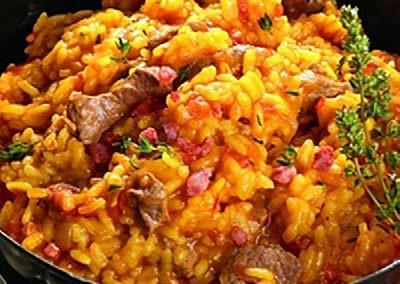
The saffron grown in the mountain village of Mund gives the delicious rice a unique flavor. Saffron risotto is a meal for refined gourmands.
ZURCHER GESCHNETZELTES
Zurich-style veal: this is a delicious and easy dish to prepare, containingveal with mushrooms and cream sauce.


The recipe for this entree first appeared in 1947 cookbook, and now Zurich-style veal (Züri-Gschnätzlets) is the region's classic dish.
The veal is simmered in white wine and beef broth with mushrooms.
100 VOYAGER 5/2016
PLAIN IN PIGNA
This dish symbolizes Engadin as much as the sun and the snow. Potatoes and meat are fried in a wood oven oncharcoal until crispy.
Cooked in this manner,Plain in Pignaachievesthe classic flavorsof traditional rural cuisine.

The interesting dish Gsottus first appeared in the canton of Valais. During winter months, local farmers used clay pots to smoke ham, fat, beef or mutton that was leftover from the previous day's dinner.
These ingredients were then abundantly mixed withonions and pears.
GERSTENSUPPE
SOUPS
Soup is an integral part of the Swiss dinner. It may have been the only hot mealofthe day for peasants and shepherds.
Swiss soups are simple. Historically, different soups were made according to the various ingredients that people had at hand in the different regions. For example, Ticino canton’sMinestronecontained tomatoes, rice, beans and grated cheese (Sbrinz,of course).

Busekucontained intestines, potatoes, peas and cheese;Graubündensoup was made of ground barley, while a simple, wine-based soup was prepared in Valles, requiring only white wineFendant, water, cream and a little spice.

The Graubünden barley flour soup gerstenis famous outside the region as well. Barley soupis centuries old and was prepared in a different way in all 150 parts of the valley, though grain remained the main ingredient everywhere.
Whichever option you choose, it is a delicious and rich dish. The soup is based on a variety of vegetables (including beans) and smoked or sundried meat.
WALLISER SPEZIALITÄTEN
The Valais cheese and meat platter is another traditional dish, once considered a snack forshepherds.
It contains some of the most delicious varieties of dried meat, salted thin pieces of lard, local cheese, raw smoked sausage, pickled cucumber and onions.In short, everything that housewives used to use.
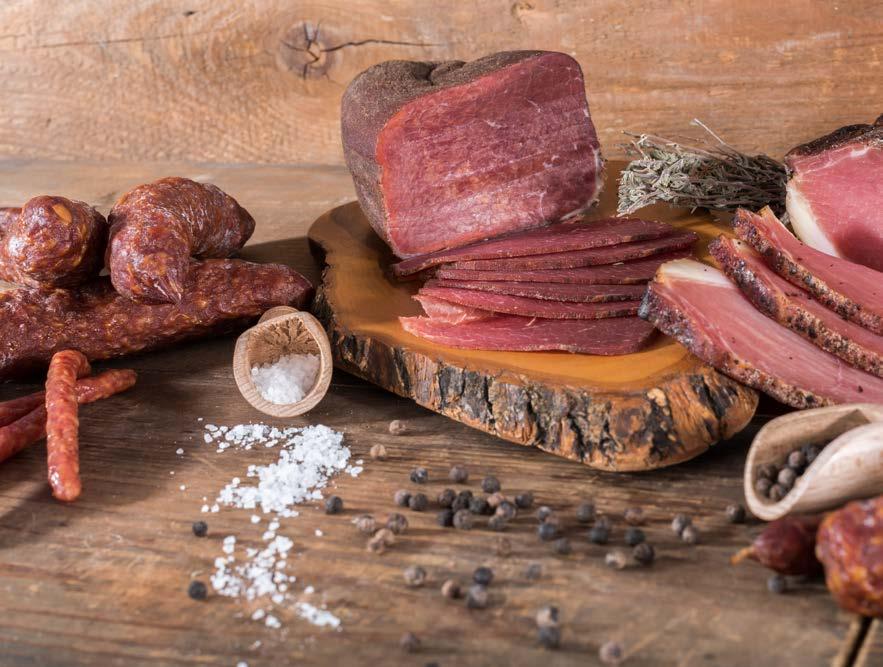
The tray assembly principle remains the same, but there are as many options as there are families in the canton of Valais.
BÄRNER ZÜPFE
Swiss Sunday breakfastis inconceivable without a Bern zorf. Thistraditional, homemade bread is baked in an oven and eatenwarm. Rolled, twisted bread originated inBern and was given as a gift for Christmas or New Year.
Now, the wholeof Switzerland enjoys zorf with a lavish Sundaybreakfast. The baker's experience is essential to achieve theideal zorf.

101 VOYAGER 5/2016 GASTRONOMY
GRUYÈRE HAS RETAINED THE TITLE OF BEST SWISS CHEESE IN 2016. JEAN-CLAUDE PITTET FROM COTTENS BECAME THE WINNER OF THE MOST COMPEETITIVE NATIONAL AWARD, SELECTED OUT OF 800 CHEESE PRODUCERS.

GRUYÈRE
Gruyere, a cheese created in the west of Switzerland, is known by gourmands around the world for its unique taste. This popular cheese has been prepared for centuries in the area around the village of Gruyere using the local traditional methods.
Some 400 liters of fresh milk are needed to prepare one 35 kg round head of cheese. The quality of the milk is of great importance, so the cows that give the milk for this special cheese are sent to pasture on the fresh grass of the Alpine meadows in the summer and are given mild dry hay in the winter. This "diet" does not allow for any kind of artificial interference.
During the long process of the cheese maturing, it is periodically rotated and greased with salt water, which accelerates the ripening and gives the product a unique taste, unique to Gruyere. This cheese has anAOC label of quality control, which is a guarantee that all of the components of the product are of the highest quality and are natural.
LA MAISON DU GRUYÈRE A PRINGY
A visit to the "Gruyere house" will be memorable not only for the refined taste. The light soft aroma of the Alpine meadows andhaystacks are constants companions on this trip to the world of cheese.

During the visit, you will have a chance to witness the process of the cheese producers and to taste authentic Gruyere on the restaurant terrace as well as shop for cheese and other delicacies and souvenirs of the region.

A characteristic dairy farm has been open for observation at the bottom of a castle hillnear the Gruyere village since 1969. Here you can learn about cheese-making traditions, which have been passed from generation to generation for centuries.
La Maison du Gruyère, Place de la Gare 3, CH-1663 Pringy-Gruyères
SBRINZ
Sbrinz is a dense piquant cheese, mostly served shredded. For a century now, Sbrinz has been made in Switzerland. The product is made in 32 cheese factoriesfrom the best unpasteurized milk. Sbrinz is a completely natural product, without any additives..
Sbrinz needs quite a long time to develop its disntinct taste. Its maturation can continue for up to 18 months; the older the age of the cheese, the more refined arethe piquant taste and unique features that it gains.
Since 2002, this type of cheese has beenlabeled with AOC..
YOU CAN GET TO GRUYERE FROM MONTREUX OR LAUSANNE BY TRAIN; THE JORNEY TAKES APPROXIMATELY 45 MINUTES.

The best Etivaz is made from milk of the highest quality, freshly acquired from a cow. This cheese from theVaud Canton is produced in the mountains.

Local shepherds know how to make real alpine cheese – with an intense, slightly fruity aroma and light notes of hazelnut..
Traditionally, the cheese is made on an open fire, on more than 30 alpine peaks, situated between the Les Diablerets glacier and the vinyards of Lake Geneva.
102 VOYAGER 5/2016
ETIVAZ
APPENZELLER
APPENZELLER
The most piquant of the local cheeses, it has been handmade using the same methods for over 700 years. This cheese is unique because it can only be produced in particular places:the cantons of Appenzell Innerrhoden and Appenzell Ausserrhoden, as well as in parts ofSt. Gallen and Thurgau.
In addition, it is necessary to maintain the traditional recipe, which creates the exclusive piquant taste.In the production stage, which continues for at least three months, the cheese is regularly rubbed with salt water mixed with aromatic herbs. The composition of the mix and the names of the herbs is kept a secret. A seal of quality is placed on the bottom of the cheese head and is a guarantee of its authenticity.
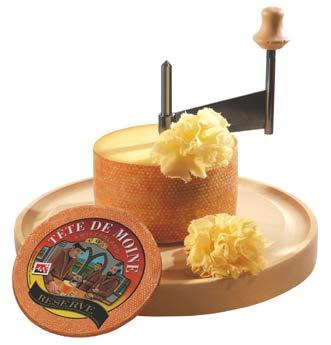
TÊTE DE MOINE OWES ITS FLAVOR TO NATURAL MOUNTAIN MILK. THE MILK IS KEPT ON PINE WOOD BARRELS FOR THREE MONTHS.
TÊTE DE MOINE
The Tête De Moine cheese of the Giura canton, whose name is translated as "a nun’s head", is a cylindrical semi-hard cheese with a silk-like texture that melts in the mouth.
Its main feature is that instead of cutting, the 800-gram heads of cheese are carefully scraped with special Girolle and Pirouette knives to produce shavings that look like roses. Such a method of serving increases the contact surface of the cheese with oxygen, resulting in a change of the structure and opening of a full range of flavors.
For the correct scraping, the blade is placed at such an angle that the consumer gets the cheese in thin shavings. This method was invented in the early 12th century in Bellelay Abbey, where the cheese was used as a means of payment.
VACHERIN FRIBOURGEOIS
It is a light cheese with a creamy taste, which is filled with a full pallete of aromas from the foothills of the Alps and the Alpine flora of the Fribourg heights.

Vacherin Fribourgeoishas special characteristics. It holds a special, leading place in the varities of cheese for its light, very refined taste with cream cheese texture.

Fresh and high quality milk is processed on a daily basis in the Fribourg canton, followed by a traditional and unique process of cheese production.The product is carefully cultivated and ripened. The cheese is used in the preparation of double fondue (half Gruyere and half Vacherin Fribourgeois).
EMMENTAL
Emental is called the king of Swiss cheese. It was named after the river valley of the river Emme, located in the cantonof Bern. Emmental is made from freshunprocessed milk. The cows are fed only natural grass and hay; you will not find any supplements in this milk. 12 liters of milk are needed to produce one kg of the cheese.
The diameter of the finished cheese is between 80 and 100 centimeters and it weighs75–100 kg. This cheese is characterized by its large holes, which are created in the process of fermentation and grow in a variety of sizes from the size of a cherry to a walnut.
It is a misconception that Swiss cheese must necesarilly have holes in it. What is known abroad as "Swiss cheese" is nothing more than "Emmental". Characteristic holes appear in the process of ripening the cheese. Carbon dioxide is created during the natural process of fermentation, which "cannot find its way out" of the solid mass of cheese.Subsequently holes develop as famous "cheese eyes".

103 VOYAGER 5/2016 GASTRONOMY
450 VARITIES OF CHEESE ARE MADE IN SWITZERLAND. THE SWISS CONSUME AN AVERAGE OF 21.49 KG OF CHEESE PER CAPITA ANNUALLY.
Comment
IS ONE OF THE BEST SWISS DELICACIES.
THE GREEN FAIRY
MARINA KIPSHIDZE
Absinthe emerged in 1792 in the city of Couvet on the Swiss-French border, where the Henriod sisters prepared medicines. An infusion of absinthe wormwood and anise called Bon Extrair d’Absinthe was created in a distillery, and the spirit also included chamomile, fennel, spinach, coriander, parsley roots, and melissa.The elixir was given out on prescription by Dr.Ordinaire, who had escaped the French Revolution to Switzerland, asan antitussive and reinvigorating medicine.
The secret recipe was purchased by Henry Dubied, who in collaboration with Henry-Louis Pernod successfullystarted mass production of absinthe in 1798. At the time, the drink was considered a remedy for all illnesses. Absinthe's popularity rose in the period 1830-1847 during France’s North African wars. The drinkwas given to soldiers as protection from disease. The tincture proved to be effective, and all French soldiers, from Madagascar to Indochina, used todrink it.
Absinthe became fashionable among colonists and immigrants, and it quickly spread to France. The New York Times reported at the time that 18-20 yearold French girls often developedcirrhosis of the liver from drinking undiluted absinthe. This drink flooded Paris cafes, conquered Europe and even reached America. Absinthe was an expensive pleasure, but soon cheaper, non-distilled versions appeared.
The “green fairy” (la fée verte) fascinated contemporary artists. It seemed to induce amagicalstate of creativity wherebyeven the muses themselves obeyed the artists.
EDOUARD MANET PAINTED THE FAMOUS ABSINTHE LOVERIN 1859, WHICH SECURED HIM A PERMANENT PLACE IN THE PARIS SALON,AN EXHIBITION SPACEFOR PRESTIGIOUS ARTISTS. OTHER "ABSINTHISTS",INCLUDING DEGAS, BAUDELAIRE, VERLAINE, ZOLA, VAN GOGH, TOULOUSELAUTREC, MODIGLIANI AND HUGO, OFTENUSED TO START THEIR MORNINGSIN MONTPARNASSEWITH THE “GREEN FAIRY”.
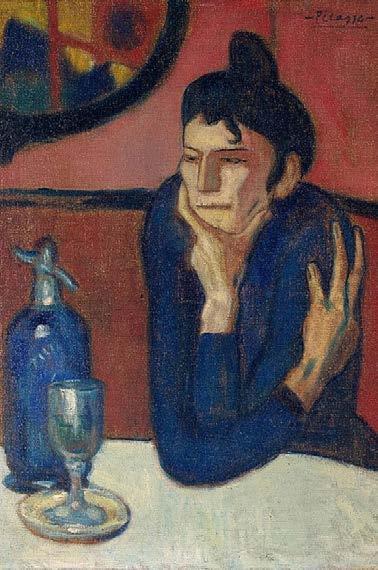
ABSINTHE VARIETIES

Green – classical, natural
Yellow – natural
Red – with pomegranate or wormwood extract
Brown – made with absinthe wormwood roots (as opposed to leaves or flowers)
BY THUJONE CONTENT:
ABSENTHE (France) – imitation of absinthe with low thujone content (1,5 – 10 mg/l). The absinthes produced in Europe contain lower levels of thujone.
SINOPALE, TOULOUSE LAUTREC – Swiss absinthe with medium thujone content (10 mg/l).
104 VOYAGER 5/2016
HOW TO SERVE
Drip absinthe into aglass overa sugar cube placed on aspoon held on the edge of the glass. Burn the soaked sugar, stir the resulting caramel into the drink and mix with triple the amount of water. Should the drink in the glass heat up, dilute with water.
In asecond method, a sugar cube is placed on a heated spoon held over a glass. Absinthe is poured on the spoon and flows into the glass, resulting in warm absinthe with melted sugar.
In July 1905, a Swiss farmerkilled his wife and children after having consumed numerous alcoholic drinks, including absinthe,brandy and three liters of wine.It was only the absinthe, however, that caused outrage in the press.
The story was featured on the front page of European newspapers, andsome 82,450 people signed a petition to ban the sale of absinthe in Switzerland. Aban was enacted in 1906, and in 1915 in France, on both the sale and production of absinthe.

The drink, by now considered a drug,was subsequently prohibitedinmany countries around the world, including the US, Belgium, Italy, Bulgaria and Germany. From 1930 to1980,absinthe existed in semi-legalstate, with people having access to pre-war reserves, contraband English products or similar alcoholic beverages made from anise or wormwood leaves.
POIRE WILLIAMS

Poire Williams is a Swiss fruit brandy (eau de vie) made from the Williams pear variety. Typically, the drink is served chilled after dinner. Some manufacturers liketo place a whole pear into the bottle. To achieve this, they place a bottle on a budding pear tree so that the fruitcan continue growing inside. Arguably the best Poire Williams is produced by Louis Morand under the Williaminebrand.
In 2004, the Swiss parliament voted to lift thecentury-old ban on absinthe, and Holland has since followed suit. Manufacturers must adhere to European Union rules - the thujone content in absinthe must not exceed 10 mg / l.
from 95$
1. Tuller Absinthe (Dornier)


2. Clandestine Recette Marianne (Franco Suisse)
3. Blanche Traditionelle (Brut D’Alambic)
4. Biker Medicine (Matter-Luginbühl)
5. Duplais Blanche (Matter-Luginbühl)
Recommendation
Williams pear varieties are grown only in Valais, and this origin is clearly stated on the label of the beverage. Ripe pears are harvested, crushed manually and fermented before distillation. One litre of 43% proof Williamine Morand beverage requires 12 kg of pears.For centuries, in the heart of the Alps, the land of glaciers cliffs, the river Rhône has turnedthis place into a fertile land.
The Alpine streams and clean air, combined withthe sun's warmth and evening coolness, create very special conditions for the cultivation of this fruit. The local soil is most suited to cultivating the Williams pears as well as the Luizet apricot variety.Apples, quince, raspberries, green plum and prunes are also grown in this area.
105 VOYAGER 5/2016
BEVERAGES
THE TOP FIVE SWISS ABSINTHES:
THE UNKNOWN SWISS WINE
TEA SKHIERELI
Switzerland is a country with a rich wine culture. Grape-pressing and wine-making has been common here since antiquity, and today the Swiss have a distinctive place among wine-loving nations with 44 million bottles consumed there annually.


Maybe this is why local wines are little known around the world –nothing is left to export . . .
My first impression is that Switzerland’s wines are almost as expensive as its watches.
My second impression: there are literally hundreds of different
grape varieties growing here. In the south-west, where the river Rhône crosses Switzerland's largest winemaking region of Valais, they grow more than 30 different grape varieties, most of which I had not heard of before.
Grapes from the vineyards planted on steep slopes are sometimes transported to factories using monorail carts or even helicopters. Many of the vineyards are very small, not exceeding 0.4 hectares.
It is surprising that so much wine is produced in such a small country and of such variety – from the rich taste of the light white wines to fruity rosés and velvety reds.
106 VOYAGER 5/2016
THE SWISS ARE AMONG THE BIGGEST WINE DRINKERS IN THE WORLD. AVERAGE ANNUAL CONSUMPTION IS 46 LITERS PER CAPITA.
Chasselas is considered to be the most outstanding of the grape varieties grown on Switzerland’s fertile land. The distinguished feature of the local wines is that they are not aged and are served as soon as they are ready; in general, Swiss do not store wine for more than three years. However, there are exceptions; e.g. Merlot and Dézaley receive their best features after aging.
Local wine lovers will tell you that Swiss wine should only be served with national dishes (fondue, raclette, etc.).
On the other hand, these wines are perfectly suited for exotic dishes, not to mention different varieties of cheese, goose liver or desserts.
The vineyards of the Swiss Confederation are considered to be among the most beautiful estates in the world. Such a great variety of grapes on such a small territory is due to the diverse climate conditions created by the Atlantic Ocean, the Mediterranean Sea and the continental climate. The formation of the Alps and its glaciers has created different types of soil in Switzerland.
A special role is played by a typical Swiss warm wind - Föhn, whose name was even given to a hair dryer.
AN AVERAGE OF 1.1 MILLION HECTOLITERS OF WINE IS PRODUCED IN SWITZERLAND ANNUALLY.
WHITE WINE VARIETIES USED TO DOMINATE THE SWISS MARKET BUT RED AND WHITE ARE CURRENTLY APPROXIMATELY EQUAL.
VINEYARDS IN SWITZERLAND COVER ALMOST 15,000 HECTARES, WHICH IS EQUAL TO THE ENTIRE AREA OF ALSACE.

THREE QUARTERS OF THE VINEYARDS ARE IN THE FRENCHSPEAKING REGIONS OF SWITZERLAND.
THE HIGHEST CONTRIBUTION TO THE WINE PRODUCTION COMES FROM THE VALAIS (5,136 HA), VAUD (3,851 HA), GENEVA (1,288 HA), ZURICH (620 HA) AND NEUCHÂTEL (600 HA) CANTONS.

The country sells only 2% of the locally produced wine abroad. The current strong position of the Swiss Franc has decreased this indicator further.
APPROXIMATELY 50 GRAPE VARIETIES ARE GROWN IN THE HIGH MOUNTAIN REGIONS OF SWITZERLAND (THE HIGHEST POINT BEING 1,100 M. ABOVE SEA LEVEL) ON AN AREA OF 15,000 HA; NO OTHER COUNTRY IN EUROPE GROWS GRAPES AT SUCH HIGH ALTITUDE.
SWISS WINE IS EXPENSIVE FOR TWO MAIN REASONS (A BOTTLE OF WHITE WINE STARTS FROM 14 CHF) – THE COMPLEXITY OF GROWING GRAPES IN THE CONDITIONS OF THE HIGH MOUNTAIN REGION AND THE SMALL VOLUME OF THE PRODUCT (200 MILLION BOTTLES PER YEAR, WHILE FRANCE PRODUCES SEVERAL BILLIONS OF BOTTLES ANNUALLY). ON AVERAGE, SWISS WINE PRODUCTION IS FOUR TIMES MORE EXPENSIVE THAN FRENCH.

WINE
107 VOYAGER 5/2016
CLASSIFICATION OF SWISS WINES : NO CLASSIFICATION SYSTEM FOR LOCAL SWISS WINES EXISTS, SO THE SWISS USE GERMAN OR FRENCH (APPELLATION D'ORIGINE CONTRÔLÉE) CLASSIFICATIONS. THEY ALSO TAKE INTO ACCOUNT LOCAL (CANTON) REGULATIONS.
THE FOLLOWING WINE-QUALITY CLASSIFICATION SYSTEM WAS ESTABLISHED IN THE 1990S:
I CATEGORY"CONTROLLED ORIGIN AND QUALITY OF WINES", MARKED BY THE ABBREVIATION АОС (APPELLATION D'ORIGINE CONTRÔLÉE) AND GRAND CRU AND NAMES OF THE CANTON;
II CATEGORYINCLUDES LOCAL WINES, INCLUDING THE PRODUCTION OF THE SPECIFIED REGION, WHICH GOES BEYOND THE CONFINES OF THE CANTON;
III CATEGORY - TABLE WINES, WITHOUT REFERENCE TO THE REGION'S PRODUCTION.
Historians believe that the Romans began production of wine on the territory of Switzerland in 100 BC. However, the local wine industry was highly influenced by France and Germany at a later stage.
For hundreds of years, Swiss winemakers worked mainly for the domestic market production; capacity has always been small – the vineyards in the mountainous countryside were small in size. However, Switzerland is distinctive for its 50 different grape varieties cultivated there.

White wines account for more than half of wine production; the rest are red and pink. There are distinctive "leaders" in this mixture of European
and endemic varieties. The most popular is white Chasselas, which is grown and produced only in Switzerland. A large portion of the red wines are made of Pinot Noir and Merlot in the Italian part of the country. Due to differences in soil and climate, these wines have individual distinctive characteristics. The local varieties recognized as the Swiss "jewels" are: Petite Arvine, Amigne, Humagne, and Heida - a very rare variety growing in the highest places of Europe.
Swiss wine, in line with world standards, has never been mass produced. Even today the key "players" are private or family owned winemakers, who inherited wine cellars and small wineries from their ancestors.
GRAPE VARIETIES

THE MOST COMMON WHITES:
• CHASSELAS;
• CHARDONNAY;
• PINOT BLANC;
• SILVANER;
• PINOT GRIS;

• MÜLLER THURGAU;
• MUSCAT;
• RIESLING;
THE MOST COMMON REDS:
• MERLOT;
• PINOT NOIR;
• CORNALIN;
• MALBEC;
• BONDOLA;
• HUMAGNE ROUGE.
108 VOYAGER 5/2016
შპიცის ვენახები
Dry white wines are more popular among the locals due to their rich palette of aromas and extraordinarily cheerful taste.
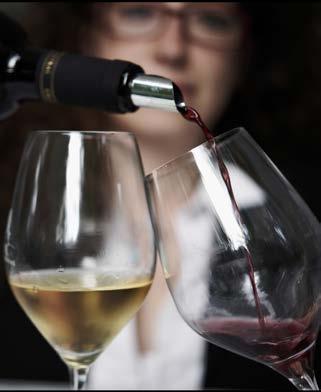
Local wine lovers drink fewer red wines (despite the relatively high price). Swiss red wine is characterized by its simple sour taste due to the fact that red grapes need more sun to ripen and therefore do not develop enough sweetness and aromas.
The white grape varieties cultivated in this land have a long history, and they are more suited to the mountainous conditions. The large diversity of grape varieties is due to the different microclimates around the country, so stylistically pure types of wines are hard to find in respect of the Swiss brands.
2013 DOMAINE DES MUSES PETITE ARVINE TRADITION

One never gets tired of sipping wine made from the Petite Arvines Swiss variety, characterized by its moderate acidity and dryness, in addition to its mild flavor. The alcohol content is 13.5%. You can enjoy it with dinner or for refreshment.
POPULAR SWISS WINE BRANDS:
• ARVINE – DRY WHITE, PRODUCED IN THE CANTON OF VALAIS;
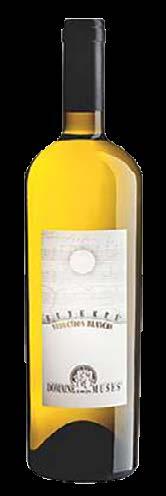
• HUMAGNE ROUGE – HIGH-QUALITY DRY RED, CANTON OF VALAIS;
• MERLOT DEL TICINO – DRY RED, TICINO CANTON;;

• RIESLING – DRY WHITE, WHICH IS GROWN IN SMALL QUANTITIES IN THE CANTON OF VALAIS;

• PINOT NOIR – DRY RED, WHICH ARE GROWN IN THE VALLEYS OF THE RHINE;
• FENDANT – DRY WHITE, CANTON OF VALAIS;
• BIANCO DI MERLOT – DRY WHITE, TICINO CANTON; CHASSELAS – WHITE LIGHT, THE TEMPLATE REGION;

• BLAUBUR-GUNDER – RED, PRODUCED IN SAFHAUZEN.
This famous white wine is the most common in Switzerland. It has a special lightness and refinement. Chasselas grapes are used to produce it, and the alcohol content is 11.5%.
Winemaker Robert Taramarcaz received his education in Dijon and a Burgundy charm comes through in this excellent wine. Like most Swiss wines, it is distinguished by saturation and leaves a dry, pleasant taste. The alcohol content is 13%.
109 VOYAGER 5/2016 WINE
FOR THEM, THE QUALITY OF THE WINE AND THE ORGANIC INGREDIENTS ARE A MATTER OF PRIDE, ESPECIALLY TODAY WHEN WINE CELLARS ARE EQUIPPED WITH MODERN TECHNOLOGIES. THE MOTTO OF SWISS WINEMAKERS IS: "THE QUALITY IS THE MOST IMPORTANT NOT THE QUANTITY".
2013 HENRI BADOUXAIGLE LES MURAILLES
2011 DOMAINE DES MUSES EUTERPE SÉDUCTION BLANCHE
€40 €37
€45
SWISS VITICULTURE GEOGRAPHY
90 percent of Swiss wine is made from 15 grape varieties. Of course, each of those varieties are grown in the soil best suited for them. Gourmands appreciate Human Rouge, White Arvid and especially the White Chasselas.

Wine is mainly produced in six regions.
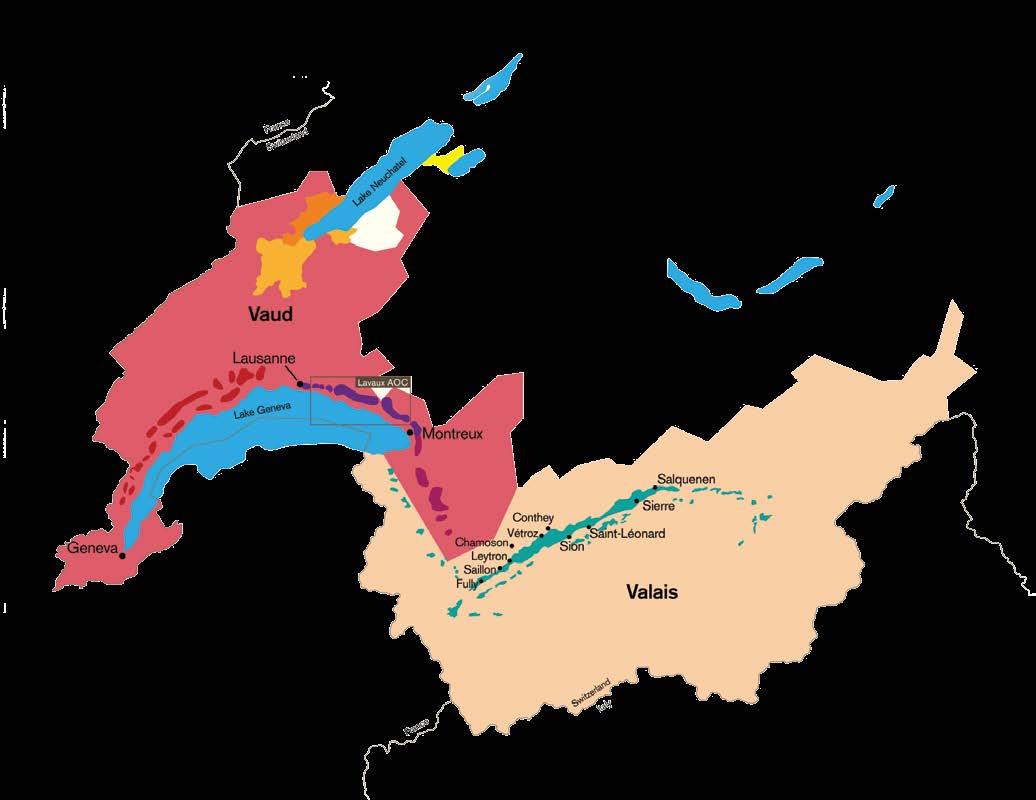
The Three Lakes (Neuchatel, Bill, Murten) region is located in the western part, alongside the Jura Mountains. Vineyards are situated on the banks of Lake Neuchatel and stretch from north to south. The Three Lakes region has strong wine production harvests.
In addition to traditional varieties, AT Di-perdri (CEilde-Perdrix) stands out for its glorious, elegant fruit and rose flavor. Sparkling wines and a few types of Chardonnay are produced here as well.
The vineyards are planted in different soils, giving the wine bouquet wonderful diversity and nuanced differences.
Vo includes the Lake Geneva area. It is divided into four main districts and produces a quarter of all Swiss wine. Fruity and light white Chasselas wines are produced here, with their delicate texture and color variety. The local red wines – Gamay and Pinot Noir – comprise a quarter of the production. The Dézaley winemaking tradition was founded by medieval monks. The proximity of the glaciers and lakes create climatic conditions for a good, diverse bouquet of wines.
The south-western corner of the canton of Geneva has the third most vineyards in the country. The mountains located west of Lake Geneva provide a complex and optimum best climate. The slopes do not freeze in spring and the vineyards that face the sun are rapidly heated in the morning. Here the most modern technologies in the field of winemaking are used. Gamay dominates among the red wines, but Pinot Noir and other red wines are no less important for this region, and the local Chasselas bouquet is very delicate and refined.
The Ticino region is located on the south slopes of the Alps towards Italy.
The Italian side of the Alps is distinguished by its sunny Mediterranean climate. The local vineyards are 90 percent Merlot variety. Ticino competes with the Bordeaux wine region of France.

Frequent sunny days and an abundance of precipitation makes Ticino wines special. Particular attention is paid to advanced production technologies.
Valais is the largest and most alpine region due to its location and climate. The local Swiss vineyard harvest makes up a third of the total wine production.
In some places, e.g., Visperterminen, the vineyards are located at an altitude of 1,100 meters. The pleasant, sunny, dry climate and wide variety of soils result in an amazingly rich, unique harvest.
A late harvest produces a full range of wines. The canton of Valais is a paradise for wine lovers.
110 VOYAGER 5/2016
Imagine vineyards spread on the Alpine hills and shiny lakes; high mountains around, medieval villages scattered here and there, 20-mile paved pedestrian paths weaving along vineyards: this is the Lavaux region of Switzerland.
I have never seen such beauty. Stretched between Lausanne and Montreux, alongside Lake Geneva, Lavaux’s 30 kilometers and 840 hectares of vineyards are among the world’s best panoramas. This unique cultural landscape is a result of many generations of winemakers' efforts and work.
That is why 14 settlements and six vineyards there have been protected by UNESCO since 2007. Some 200 estates located in Lavaux played a decisive role in the country’s economy.
The local population (28,000) is dedicated to protecting this place from the harmful influence of urbanization. Leading varieties include Chasselas, Gamay and Pinot Noir. Calamin, Chardonne, Dézaley, Epesses, Lutry, St-Saphorin, Vevey-Montreux, Villette wines are certified according to the АОС system, therefore, keep in mind while you are sipping them that you are enjoying the best quality wine.

Visit several small towns located between Montreux and Lausanne. I chose Vevey and directly from there I stopped at Chexbres Villages – a ten minute walk from there. The railway goes through the beautiful places between the vineyards, and each in turn offered stunning scenery of vineyard hills, Lake Geneva and the Alps.
THE WORLD'S MOST BEAUTIFUL WINE REGION: REGION LAVAUX IN SWITZERLAND
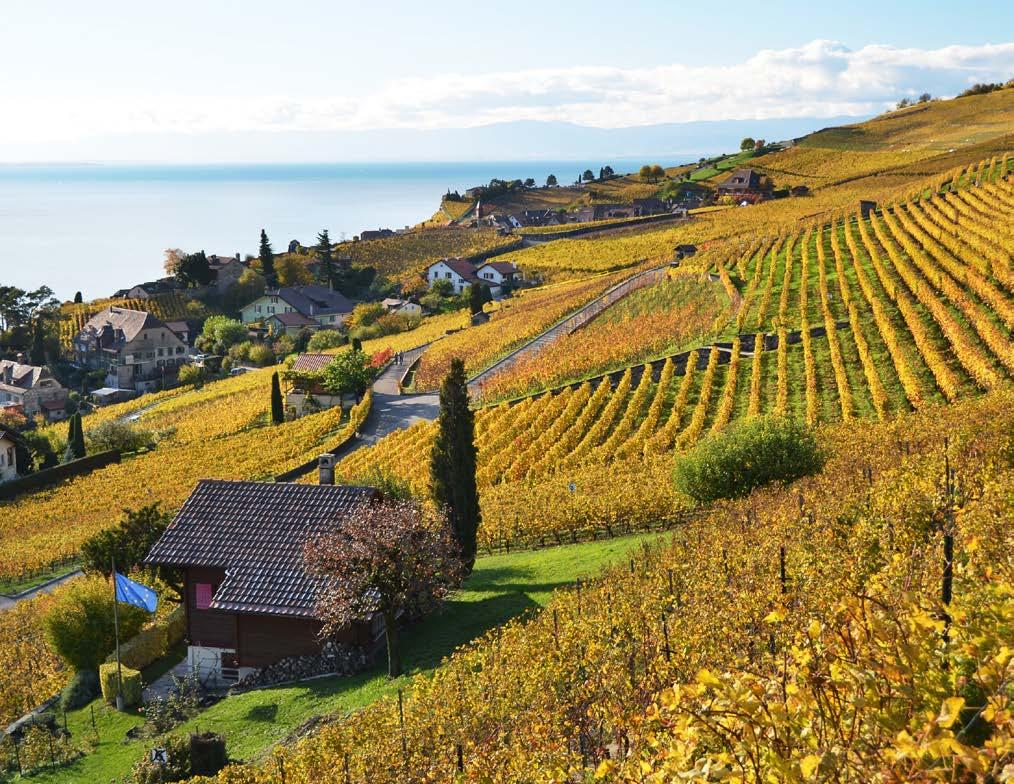
PAINTED IN BLUE AND YELLOW COLORS, A "VINEYARD STEAM ENGINE" (TRAIN DES VIGNES) IS THE MOST COMFORTABLE WAY TO TRAVEL. IN JUST 12 MINUTES, THIS TRAIN PASSES THROUGH LUXURIANT VINEYARDS AND TAKES YOU FROM VEVEY TO PUIDOUXCHEXBRES. HERE YOU CAN TASTE THE LOCAL WINE PRODUCTION AT ANY WINE CELLAR.

TO EXPERIENCE THE TRUE TASTE OF LOCAL DISHES, ONE MUST VISIT ONE OF THE EXCELLENT "PINTS" (SMALL RESTAURANTS).
IF YOU WANT TO TASTE EVERYTHING TOGETHER, GO DIRECTLY TO "VINORAMISA" - A SPECIAL AREA, WHERE YOU WILL BE ABLE TO TASTE 300 DIFFERENT TYPES OF WINE.
111 VOYAGER 5/2016 WINE
GUARDIANS OF TIME
THIS SMALL LIVING TICKING MECHANISM IS ONE OF THE HIGHEST INTELLECTUAL ACHIEVEMENTS OF CIVILIZATION. PEOPLE HAVE ALWAYS TRIED TO STOP THE TIME THAT RAN THROUGH THEIR FINGERS LIKE SAND, OR AT LEAST COUNT IT, OR SET SECONDS IN A FRAME AND COUNT MINUTES. THIS IS WHY CLOCKS CREATE A COMBINATION OF BEAUTY, PRACTICALITY AND SOCIAL STATUS THAT YOU CAN WEAR ON YOUR WRIST.
THIS IS THE ONLY MECHANISM IN THE WORLD THAT ALLOWS US TO GRASP THE TAIL OF SUCH AN EPHEMERAL SUBSTANCE AS TIME. THIS COMPLETELY SUBJECTIVE PHENOMENON OBEYS THE WILL OF SMALL AND BIG ARROWS ON THE DISPLAY OF THE MECHANISM.
Switzerland has always been a country where the price of time was highly valued, as well as the tools for its measurement. Swiss watches are constantly associated with reliability and permanence. Even in the volatile environment, placing these devices on the wrist helps people organize their own space with Swiss precision.
1868 IWC launched its traditional work and until the present day remains an example of new technologies and perfect design. The company was founded by the American-Florentine Ariosto Jones in Switzerland.

IWC’s headquarters and the Museum Shaphauzen carefully keep his work books, which are filled with details of clock mechanisms. With the support of the American production progress and the skilled Swiss workforce, a young watchmaker managed to start up an innovative and high-quality watch production venture.
IWC watches were particularly prized for their precision. At a time when watchmakers didn’t have high technologies at their disposal, they could only rely on their talent and experi-
 SALOME DADUNASHVILI
SALOME DADUNASHVILI
112 VOYAGER 5/2016 WATCHES
PORTUGIESER PERPETUAL CALENDAR
ence. IWC’s pocket watch was the equivalent of having ownership of quality and accuracy.
The company’s museum, Shaphauzen, displays all of the stages of development of IWC watches. If you are fascinated by clocks, their mechanisms and accuracy, you must visit this museum. At IWC, traditions are valued dearly. In 2015, they celebrated with great fanfare the anniversary of the Portugieser P75, which constitutes a symbol of style and prestige. A new collection was dedicated to the anniversary of this special watch and several variations of Portugieser were presented to the world. IWC has turned a number of watch models into legends. For example, in 2016 new models have been added to the IWCAQUATIMER and IWCPILOT’S WATCHES lines. The company does not cease to explore, as perfection has no limits.
YOU CAN VISIT THE SHAPHAUZEN MUSEUM IN THE IWC HEADQUARTERS – A MUSEUM OF A LEGENDARY COMPANY FROM ZURICH – IN TRAIN. YOU WILL SPEND SLIGHTLY MORE THAN AN HOUR ON THE JOURNEY. IT IS OPEN FROM TUESDAY TO FRIDAY FROM 15.00-17.00 AND ON SATURDAYS FROM 10.00 TO 15.00. THE PRICE OF A TICKET IS 6 CHF.
Baumgartenstrasse 15, Schaffhausen
How much does it cost to wear the lunar cycles, months, weeks and days, hours, minutes on the wrist, so that the weight on the wrist reminds you of the good job that you have done?
The watch that IWC created in honor of Antoine de Saint Exupery is a dream purchase for watch lovers. This watch satisfies all requirements. Part of the money received from sales of the watches are transferred to the Exupery charity fund and you will also have a very cool watch.


PERPETUAL CALENDAR
Its design was a genius invention, and opened the way for IWC watches in the world of high-art watches. The perpetual calendar takes into account all of the difficulties of calculating a leap year. This applies to any year evenly divisible by 4, and any century, which is evenly divisible by 400. The first year of the new millennium will not be a leap, if it is not evenly divisible by 400. In this case, clocks with an
The inscription on the clock: SWISS MADE is written if the following rules apply: certified and fully assembled in Switzerland; or more than half of the component parts are produced in Switzerland.
Some have the inscription GENEVA, which means that their quality is fully in line with the requirements, and production of at least one major operation was carried out in the Geneva canton.
indicative analog of the date need an artisan that sets the watch one day ahead in March, while in case of the digital display of the clock mechanism, the owner will be able to make adjustments on his own.
The chronographs of IWCPILOT'S WATCHES are really good; they are force-, sand- and water-resistant and, I believe, don’t burn in the fire, but I do not recommend testing this statement. This chronograph is truly created for flying. Its 44-millimeter steel frame protects the internal metal film, which, in turn, protects it from the magnetic fields that influence the accuracy of the clock. Sapphire glass allows the
ALL OF THE MODELS OF THE NEW SERIES ARE THE EPITOME OF EXCELLENCE AND RELIABILITY, AND ARE CREATED FOR THOSE WHO WANT TO FLY REALLY HIGH.
A more prestigious inscription is considered to bePOINÇON DE GENÈVE or GENEVA
SEAL(Geneva Seal), which is given to a product by the Facultative Control Bureau.
Watches have to meet 12 strict technical criteria.
If the parts of the clockwork are made in Switzerland, but the watch was assembled outside the country, these should be indicated on the details. Such a watch is not considered to be Swiss.
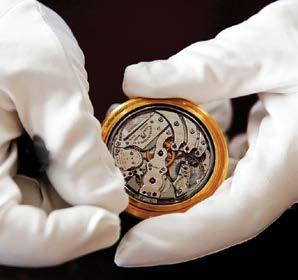
What is meant by établisseur, termineur de ébauche?
Companies that manufacture the main parts of a clock, assemble watches for them and sell them under its name are called établisseurs (manufacturers).

Termineurs (assemblers) are independent workshops or watchmakers that receive major parts from the manufacturing companies and assemble the watches; the final product
Big Pilot's Watch
chronograph to always be at the right height for the pilot when there is a sudden drop in pressure.
IWC PILOT’S WATCHES work 42 hours after their manual configuration.
is sold by the companies themselves. Ébauche means to manufacture the base of a watch mechanism, which consists of 60 parts.
"Antoine De Saint-Exupéry"
113 VOYAGER 5/2016
LES AMBASSADEURS
LES AMBASSADEURS IS DISTINGUISHED BY ITS VARIETY OF WATCHES.
IN THE SHOP SPREAD OVER SEVEN FLOORS, WATCHES AND JEWELRY ARE SOLD. THE SHOP SHOWCASES HUNDREDS OF SHINING DIAMONDS; HERE YOU CAN BUY JEWELRY FROM POMELATO, PASQUALE BRUNI, WELLENDORFF, MIKIMOTO, AND GRAFF.

The watches presented in the shop belong to the following labels: Longines, Breitling, Audemar Piguet, Jaeger - Le Coultre, Blancpain, Omega, A. Lange & Söhne, Cartier, Vacheron Constantin, Ulysse Nardin, and Breguet.
There is also a so-called connoisseur corner, where distinctive or limited re -
A Guide to the World of Watches
THE GENERAL PICTURE OF THE WATCH MANUFACTURING INDUSTRY IS FREQUENTLY CHANGING; THIS OR THAT FAMOUS BRAND CAN MOVE FROM ONE MAJOR PLAYER ANOTHER. SIGNIFICANT CHANGES OVER RECENT YEARS HAVE INCLUDED HARRY WINSTON’S ASSOCIATION WITH THE SWISS SWATCH GROUP, AS WELL AS THE PURCHASE BY FRENCH KERING OF ULYSSE NARDINE.

SWATCH GROUP
BREGUET, HARRY WINSTON, BLANCPAIN, GLASHÜTTE ORIGINAL, JAQUET DROZ, LÉON HATOT, OMEGA. LONGINES, RADO, UNION GLASHÜTTE. TISSOT, BALMAIN, CERTINA, MIDO, HAMILT ON; CALVIN KLEIN WATCHES + JEWELRY. SWATCH, FLIK FLAK.
The Swatch group is the world's largest watch manufacturing company, consisting of 18 brand names. Breguet is the most expensive, while Omega brings in the most revenue. It is the third largest producer of watches in the country.
The purchase of Harry Winston by the Swatch Group has not only strengthened its position in the jewelry sector, which had previously been regarded as a relatively modest sphere of its production, but has given the company greater access to the world diamond market.
RICHMOND GROUP
VACHERON CONSTANTIN, A. LANGE & SÖHNE, JAEGER-LECOULTRE, ROGER DUBUIS, PIAGET, IWC SCHAFFHAUSEN, OFFICINE PANERAI, RALPH LAUREN**, BAUME & MERCIER, CARTIER, VAN CLEEF & ARPELS, MONTBLANC, DUNHILL.
Compagnie Financière Richemont SA is a major market player in the jewelry sector and is the second biggest player in the world market after Louis Vuitton Moët Hennessy (LVMH). It owns 20 brands, 13 of which manufacture watches, but the company has no competitors in the sale of the luxury watches.
Richemont’s brands are grouped according to different sectors. Watches: Lange & Söhne, Baume & Mercier, IWCSchaffhausen, Jaeger-LeCoultre, Officine Panerai, Piaget, Ralph Lauren, Roger Dubuis da Vacheron Constantin; accessories: Maisons Cartier da Van Cleef & Arpels.
lease products are offered to particularly demanding customers. Les Ambassadeurs, which originally opened in Geneva, celebrated the opening of a Zurich shop in 1971 with great fanfare. Since then, the distinctive building on Banhofstrasse has constantly attracted visitors and dedicated and potential clients. The watches presented here are unique, and leading specialists can answer any questions about the products on offer.
This high-class store offers other services too, such as watch repair, cleaning, a warranty service, simple strap replacement, as well as watch appraisal, jewelry cleaning and repairs.
LES AMBASSADEURS ZURICH
Bahnhofstrasse 64 n
LES AMBASSADEURS GENEVA Rue du Rhône 62
FRANCK MULLER GROUP

FRANCK MULLER, PIERRE KUNZ, EUROPEAN COMPANY WATCH, RODOLPHE, MARTIN BRAUN, BARTHELAY, BACKES & STRAUSS**, PIERRE MICHAEL GOLAY, SMALTO TIMEPIECES*, ROBERTO CAVALLI*
Franck Muller Geneve is a Swiss group that also manufactures jewelry. Except for the primary brand Franck Muller, the group has purchased the rest of its companies over the past decade.
114 VOYAGER 5/2016 WATCHES
* Watches are produced under license agreement with the brand owner. ** Companies are the joint enterprises of the group and the brand.
BEYER
SOME HIGH-END WATCH STORES IN SWITZERLAND ARE NOT ONLY A GOOD CHOICE FOR THE CHRONOGRAPHS OF PRESTIGIOUS FIRMS BUT HAVE ALSO BUILT UP A SPECIAL TRUST OVER THE DECADES. A PURCHASE MEANS GAINING FRIENDS WHO WILL TIRELESSLY ANSWER ALL YOUR QUESTIONS, REPAIR AND CLEAN YOUR WATCH, AND IN SOME CASES EVEN ACCEPT TO TAKE IT BACK AFTER YEARS; HOWEVER, NOT ALL SHOPS HAVE THIS SERVICE.
There are a couple of such stores on Zurich's main shopping street, Banhofstrasse, but "Beyer" is the place to buy vintage watches.
The store will gladly purchase your old watch if it's in a good condition. Collecting and wearing antique or vintage watches are the fate of the chosen few as it requires big financial potential. A good quality, well-preserved series of certain watches can cost up to 500,000 CHF.
A shop were business order reigns, at first glance, looks more like a bank. Individual consultants will gladly show you all of the models, explain the advantages of each, tell the history of the firm and, if you wish, will show you the museum of "Beyer" watches. Vintage watches have a separate consultant, and, basically, these people handle difficult tasks from watch collectors: to find and buy the rare watches of the most successful series.
Not only collectors go after the vintage watches. Many people prefer to buy not the latest editions but a watch of a special series of “Rolex”.
This is often a more expensive desire. Watches are like wines – they don’t have an expiration date. It's a way to show, in certain circles, that money is new but the watch is old and prestigious.
The “Beyer” museum holds one of the best collections of watches in the world. The Beyer family always treated the time-counting history very carefully. Here
you will find exhibits dated from 1400 A.D. You can discover every modification of watches, from north clocks to sand chronometers, pocket and wall clocks.
The Beyers produce jewelry and watches themselves. The second floor of the store is dedicated to a jewelry workshop and the creation of handmade exclusive jewelry collection. A large part of the collection is sold far before it reaches the windows of the store, as the world's royal families represent the majority of clients in this workshop.
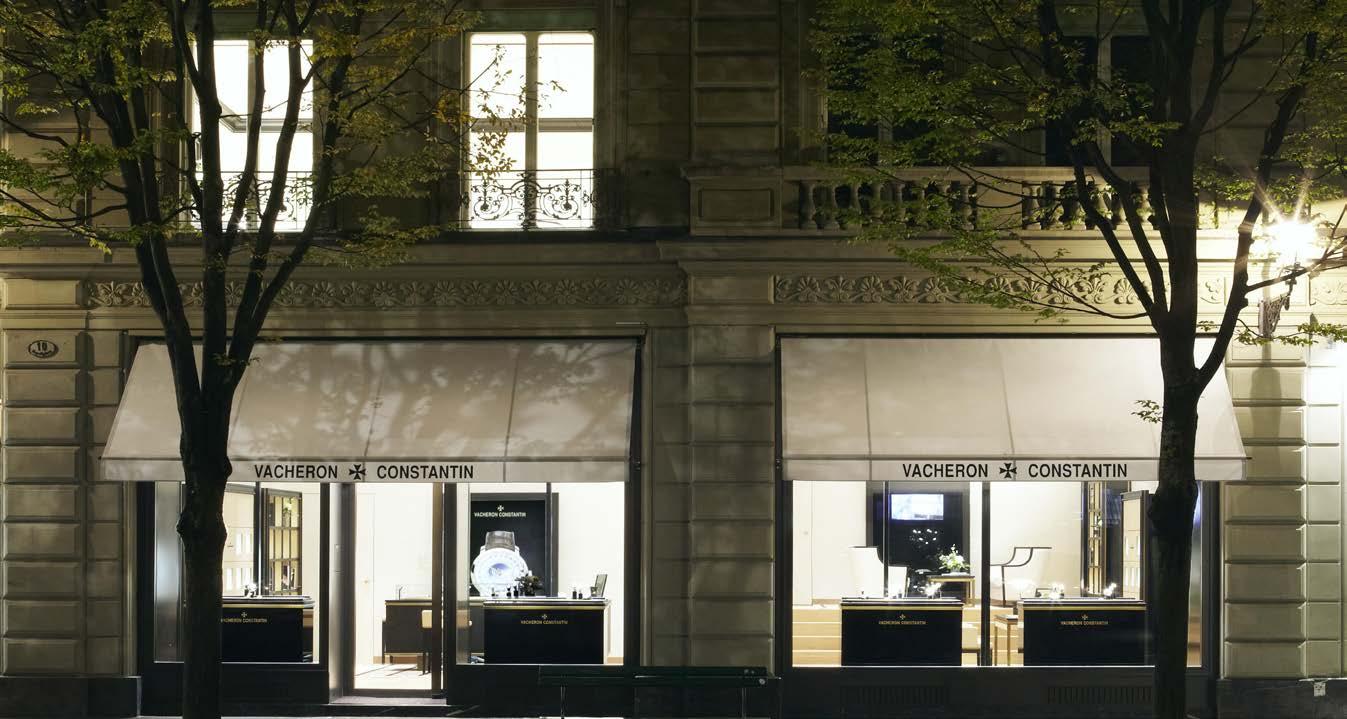
Apart from Beyer’s jewelry, you can buy here the masterpieces of Wellendorff, Chopard, Schoeffel, SCHEFFEL and Stenzhorn.
Watches that you can buy here are the production of Rolex, Patek Philippe, A. Lange & Söhne, Breguet, Jaeger-LeCoultre, Hublot, Breitling, Cartier, Chopard, Baume & Mercier, IWC, Tudor, and Jaquet Droz.

Beyer Watches and Jewellery

Bahnhofstrasse 31, Zürich
95% of all the watches produced in Switzerland are sold abroad. The main customers are from Hong Kong, the US, China, Italy and Japan. In 2015, the export value amounted 21.5 billion CHF. According to FONDATION DE LA HAUTE HORLOGERIE estimates, each year 40 million fake Swiss watches are sold on the market.
115 VOYAGER 5/2016
GENEVA
GENEVA IS RECOGNIZED AS A”WORLD CAPITAL” BECAUSE OF IT HUMANIST TRADITIONS, MULTICULTURAL SPIRIT, AS WELL AS BEING THE HEADQUARTERS OF THE UNITED NATIONS AND OF THE RED CROSS. IT IS ALSO THE INDUSTRIAL CENTER OF SWISS WATCHMAKING.
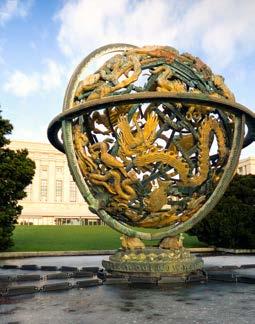



Jet d'Eau is the symbol of this 'smallest metropolis' – a 140 meter-high fountain, which erupts from Lake Geneva. Most of the big hotels and restaurants are located on the right side of the lake, whilst the heart of Geneva, its Old Town, business and shopping districts are located on the left bank.

Geneva is not a very large city, but it is lively, fun and somewhat cosmopolitan. It takes the least time to get from the center to the airport (only 4 km to cover), compared to other European cities.
ST. PETER’S CATHEDRAL
The foundation of the church was laid in 1150. It was remodeled in the XVIII century, so the first part of the building was built in the Romanesque style, followed by further construction in the Gothic style and finished during the Neoclassical era.
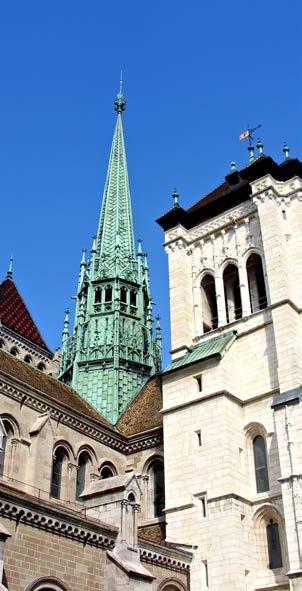
LIVING BY GENEVA LAKE ENSURES A SPECIAL, DISTINCTIVE LIFE. GENEVA’S NATURE IS BREATHTAKINGLY BEAUTIFUL. LEMAN LAKE IS SURROUNDED BY THE MOUNTAINS ON ALL SIDES – THE ALPS MOUNTAIN RANGE AND THE DRAMATIC PEAK OF MONT BLANC.
Walking by GENEVA LAKE is a unique experience. The most expensive and beautiful houses (they are called pieds dan l'eau, meaning 'feet in the water'), are built on the lakeshore so that the house owners can approach the water. You can’t see these palaces from the land, as they have high fences shielding them from the outside world. Tickets cost 31 CHF.
116 VOYAGER 5/2016
Palais des Nations
The world-famous symbol of Geneva watchmaking – a large clock, the Horloge Fleuri, can be found in the English Garden (Jardin Anglais)

PATEK PHILIPPE MUSEUM
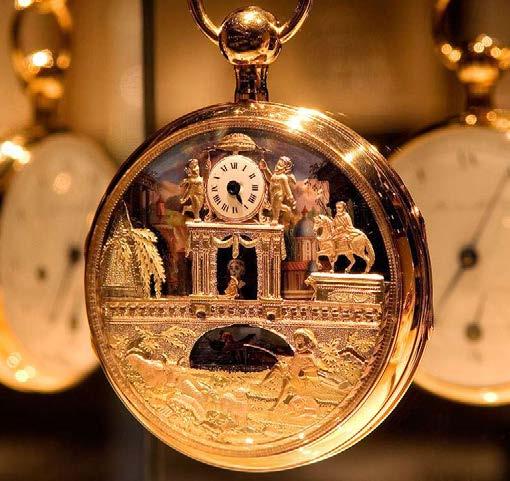
Even if you are not interested in any kind of clockwork, you have to see how the watches are made in Geneva, capital of watchmaking. Take a look at the outstanding examples of engineering and art history exhibited at the museum.
Rue des Vieux-Grenadiers 7
LES AMBASSADEURS
Geneva is the cradle of Swiss watchmaking. If you like modern design models, visit Les Ambassadeurs shops. Antique watch lovers are also advised to visit the Antiquorum auction house and the Plainpalais Farmers Market.
Rue du Rhône 62
MULTINATIONAL AND DIVERSE, GENEVA OFFERS A VARIED CULTURAL LIFE: AFTER ALL, MORE THAN 1200 RESTAURANTS CATER TO THE WISHES OF GOURMANDS FROM ALL OVER THE WORLD.
What are the most important questions of the modern physics? What is the 'Higgs boson' and what does it say about the formation of the universe?
What is CERN’s role, what is its purpose and objectives of the research? What experiments are conducted under its auspices?
CERN is ready and willing to allow anyone peek into the secrets of the universe, to describe the work that is going on in the world's largest physics laboratory, and offer permanent exhibitions. Visit it in groups, with friends or alone, on foot or bike; walk around, learn about CERN and it will cost you nothing.
Special tours are offered to individuals and groups, the number of which should not exceed 11 people. The CERN laboratory is located on both sides of the Swiss-French border, so you may need to cross the border. Make sure to bring a passport with a valid Schengen visa.

The guide will tell you about the establishment of the laboratory, inform you about its history and the latest scientific achievements, and will show you where experiments are currently being conducted. The common languages here are English and French and the tour lasts for two hours.
TOURS IN ENGLISH: 11: 00-13: 00 ON MONDAYSATURDAY; 13: 00-15: 00 ON MONDAY, TUESDAY, THURSDAY AND FRIDAY.
ADDITIONAL TOURS IN ENGLISH: 8: 45-10: 45 AND 15: 00-17: 00 ON MONDAY TO SATURDAY.
YOU MAY ALSO VISIT TWO ADDITIONAL PERMANENT EXHIBITIONS: 'MICROCOSM' AND 'SMALL PARTICLES IN THE UNIVERSE.'
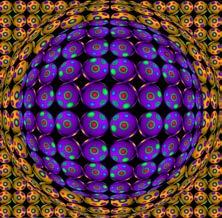
DUE TO THE MANY VISITORS, IT IS NECESSARY TO BOOK A TOUR AT LEAST 15 DAYS IN ADVANCE VIA THE CERN WEBSITE.
TRAINS RUN FROM THE GENEVA CORNAVIN RAILWAY STATION; ALTERNATIVELY, TAKE A #18 TRAM, ITS LAST STOP IS BY THE CERN ENTRANCE. THE RIDE COSTS 3 CHF.

117 VOYAGER 5/2016
CERN
GENEVA
LA PLANCHA
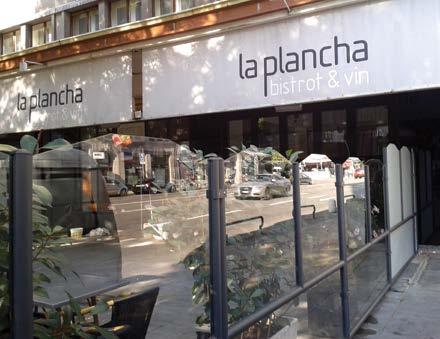
Located in the center of Geneva, near the Place des Eaux-Vives, La Plancha is an excellent example of a classic bistro. At the same time, it follows current trends. La Plancha is always busy during the daytime and offers a more relaxed and intimate setting in the evening. It often hosts alternating Geneva artists’ exhibitions, and hardly anyone can refuse the dishes proposed by the restaurant chef.
Place des Eaux-Vives 2
LE RELAIS DE L’ENTRECÔTE
This is the only restaurant in Geneva that forms queues, despite the fact that there is only one dish on the menu: entrecote with French fries and green salad. The price is 45 Swiss francs. You only choose the meat, how you’d like it done and a wine to pair it with. Reserving a table is not an option.
CHEZ PHILIPPE
Meat fans will have to visit this place, located at the Passage Des Lion; it creates an atmosphere of New York in a small enclave. The famous burger and salad bar is on the first floor, while a cozier and relatively intimate venue suited for private or business lunches is placed upstairs.
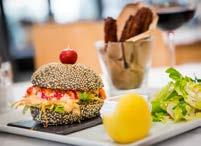
In summer you can sit on an open terrace and feel the closeness of the lake.
Meat menu is diverse and, optionally, you can taste: Australian Beef / Ireland Beef (Angus) / Ireland Beef (Hereford dry aged) / Japanese Beef (Wagyu
LE GRILL
Lake perch is Geneva's most famous delicacy.
It is impossible to fish as many as are eaten by diners on a daily basis, therefore, some types of Norwegian, or Saint Petersburg perch is served as well.
Kempinski Hotel restaurant Le Grill serves only the local perch, as it is only supplied by Swiss fishermen.

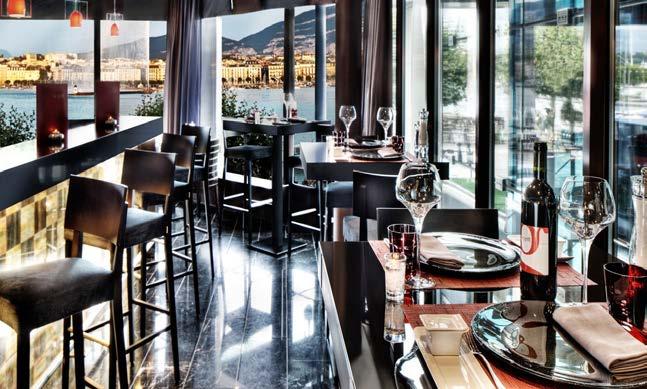

Here you can also enjoy delicious grilled tuna with sauce, which costs 46
Quai du Mont-Blanc 19
LE BISTROT DU BOUCHER
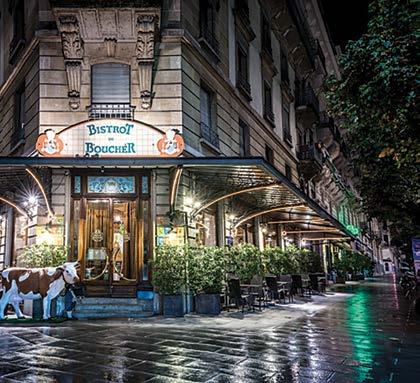
This place is a must visit for true meat lovers. Stake tartar, pot-aupeu ... everything is high quality and prepared in seconds!
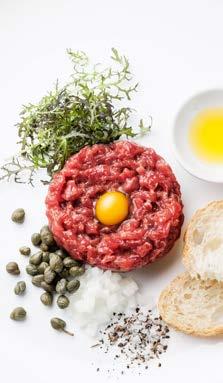
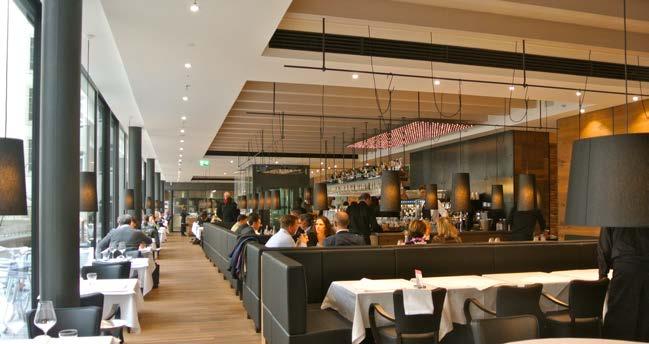
The family bistro madam-chef cooks the tartars herself, as her husband entertains the clients with conversation, while the small bistro team prepares the meat.
The décor is assembled accordingly: rococo ceiling, tiles, wooden chairs, and pictures on the walls – every single one of them depicts cows. A life-size cow also stands in the entrance of the bistro, ready to offer its gracious hospitality, as if telling us that the order will be soon ready.
Avenue Pictet-De-Rochemont 15
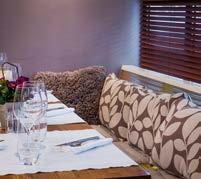
118 VOYAGER 5/2016
Rue Pierre Fatio 6
Kobe 12 +) / Porcfermier (GRTA Château du Crest - Jussy) Swiss Beef from the Alps (Molard stale 5 weeks on the bone) / Swiss Veal.
Passage des Lions, rue du Rhône 8
CHF.
LE TSÉ FUNG
Located at the Hôtel La Réserve Genève, Le Tse Fung is believed to be the best Chinese restaurant in Switzerland. The admirers of Peking roast duck often come up with business trips to travel to Geneva for a distinctive dinner in this restaurant. Try the Szechuan spicy shrimp; this entrée costs 30 CHF. Seafood soup is simply delicious and costs only 26 CHF.
Route de Lausanne 301
CAFÉ DU CENTRE
This place offers a variety of fish and seafood dishes, though meat fans can taste excellent delicacies as well. This is often tourists’ favorite café; nevertheless, locals also visit it with pleasure. Risotto with shrimp is among the best dishes, costing 42 CHF.
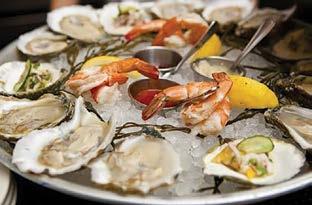

ROOFTOP 42
As the titles suggests, this bar is located on the roof of a house on a fashionable street (Rue du Rhône).
This is a free-spirited trendy environment, where all kinds of alcohol and original cocktails are served along with good food. Cocktail prices start at 15 CHF.
Rue du Rhône 2
LES VOILES

This is a place that serves cocktails to society belles dressed for the swimming and sailing season. You may have a tasty snack here as well, for example, an Italian burger with mozzarella and balsamic vinegar will cost you 27 CHF.
LIPP
A visit here is almost a mustdo for Geneva dwellers. Classically-dressed waiters in black and white do an excellent job. The menu offers a wide selection of classic French dishes, as well as the Swiss cuisine samples, such as: choucroute, confit duck, cassoulet, steaks, moules frit or other dishes prepared with seafood.
An extensive terrace makes this place even more attractive in the summer. If you have not determined where to eat during your stay in Geneva, LIPP is an excellent choice, especially since the restaurant is open until late, 7 days a week.


Despite the fact that LIPP is located on the last floor of the
Confédération Centre shopping mall, upon entering it feels like a typical French-style small restaurant, highlighted by an old-fashioned counter, soft seats and candlesticks.
Standard lunch costs 35 CHF, selected menu – 54/100 CHF.


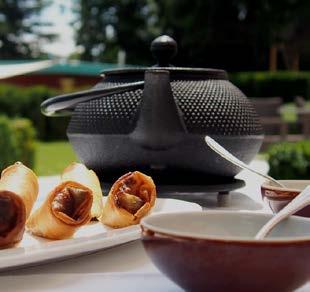
Rue de la Confédération 8
Recommendation
HOTELS AND RESTAURANTS AND TAXI FEES INCLUDE ADDITIONAL TAXES AND SERVICE CHARGE, SO YOU DO NOT HAVE TO TIP THE PERSONNEL, THOUGH IF YOU WANT TO SHOW YOUR APPRECIATION, YOU ARE FREE TO DO SO.
119 VOYAGER 5/2016
Quai de Cologny 5
Place du Molard 5
RESTAURANTS / GENEVA
RARELY ARE HISTORICAL HERITAGES PRESERVED AS CAREFULLY AS THEY ARE IN BERN, THE CAPITAL OF SWITZERLAND.


Boutiques, bars, and Old Town cabarets are spread across basements, whilst above Europe’s longest (6km long) arch gallery houses a mall and is a source of pride for the locals. It is called Lauben.
EINSTEIN
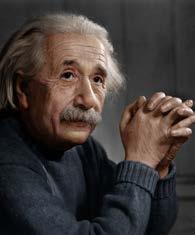
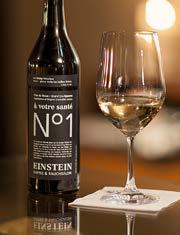
Everything is relative! Einstein lived in Bern for seven years, in the beginning of the 20th Century. He worked at a low position at the Swiss patent bureau and at the same time channeled his genius into the writing of astounding scientific works. The first among them, The Special Theory of Relativity was published in 1905.
Einstein lived in this building for two years. One of the best cafes in the town, named after him, a stylized 'Albert Einstein' is located here.

Kramgasse 49 / Münstergasse 44
ZUNFT ZU WEBERN
A great kitchen that offers traditional Swiss dishes awaits for the guests in the main hall and the basement.
Entrées prepared from freshly-caught local fish are a special delicacy here.
Gerechtigkeitsgasse 68
BEAR PARK
Bears are the heraldic symbol of Bern and are an inseparable part of the city. Make sure to visit the park where an actual bear family lives inside 6000 km of lush modern green space. You may also see the 'bear pit' (when accompanied by an animal handler). It is the oldest in the world.
Grosser Muristalden 6
BECK GLATZ
The marzipan Teddy bear Mandelbärli is the traditional confectionary souvenir of Bern. It is created in a famous confectionary shop, Beck Glatz. Here you may try delicious desserts, pastries and sandwiches. Legendary Mandelbärli is an ideal dessert to bring back as a gift for your loved ones.
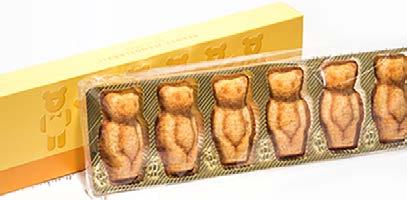
Waisenhausplatz 21
CLOCK TOWER ZYTGLOGGE
The stunning clock tower was erected in 1530. It is adorned by an astronomical clock with moving figurines.

ZENTRUM PAUL KLEE
The Paul Klee center opened at the edge of the city and offers an amazing exhibition of the artist’s works. It was designed by a great Italian architect, Renzo Piano and consists of three wave-like structures.
Monument im Fruchtland 3
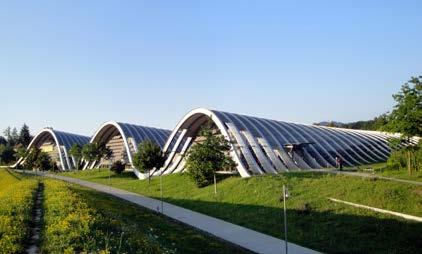
120 VOYAGER 5/2016
BERN
BERN HAS MORE THAN 100 FOUNTAINS; MANY OF THEM HAVE BEEN ADORNING THE CITY SQUARES SINCE THE 16TH CENTURY.
BERN
@ swiss-image.ch
LUCERNE IS A GATEWAY TO CENTRAL SWITZERLAND. IT ATTRACTS TOURISTS WITH ITS SIGHTS, BOUTIQUES, WATCH SHOPS, AND ROADS CUT THROUGH THE MOUNTAINS (A ROAD TO THE PILATUS, RIGI AND STANSERHORN PEAKS). LUCERNE IS LUCRATIVE FOR TOURISTS HEADING TO CENTRAL SWITZERLAND AND TRAVELERS THAT ENJOY THE MOUNTAINS. DECORATED WITH HISTORICAL FRESCOES, BUILDINGS ADORN THE COLORFUL SQUARES OF LUCERNE. THE OLD QUARTER (WEINMARKT) IS PEDESTRIAN STREET.
KAPELLBRÜCKE is the main symbol of the city; the medieval Chapel Bridge on the River Reuss, with a double roof and painted dome, was built in 1365. It houses 111 paintings of triangular shape, which tells the history of Switzerland.
LUZERN

MARLIN LUZERN PALACE
The only fish restaurant in Lucerne offers fish and seafood dishes. You can enjoy vegetarian dishes and other culinary masterpieces in exceptionally modern facilities. A variety of wines are featured in the collection Luzern Palace terrace, a comfortable lounge area, overlooks the lake and opens at 9 am. Morning starts with delicious tea or coffee and a varied menu of cocktails awaits you at noon.
Hotel Palace, Haldenstrasse 10
Lucerne blends tradition and modernity. This city is famous for its modern architectural structures: a futuristic convention center for cultural events was designed by the well-known French architect Jean Nouvel. It hosts a number of festivals throughout the year.


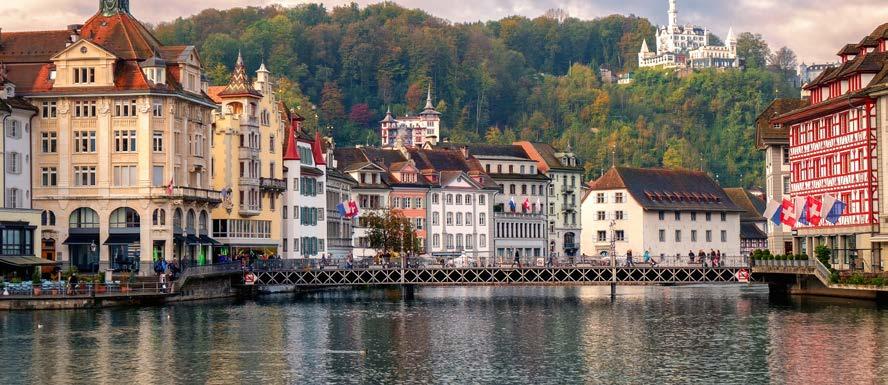
"Lucerne - the city of festivals": many cultural events are organized under this slogan. Lucerne Blue Balls Festival is held in July. Various genres (blues, jazz, soul, rock) of music stars perform on the modern built stage by a lake. Summer Night - this festival is held in August, tens of thousands of listeners come to enjoy the magic of classical music and fireworks on the lake.
MUSEUM SAMMLUNG ROSENGART

This is the "youngest" museum in Lucerne. It is popular for Pablo Picasso and Paul Klee’s works. 125 unique Klee paintings, done in watercolor and graphic prints, cover a whole period of the artist's work; featured Picasso paintings were created after 1938. In addition, a collection of great XIXXX century artists (Cezanne, Monet, Matisse, Braque, Leger, Miro, etc.) is exhibited as well.
Pilatusstrasse 10
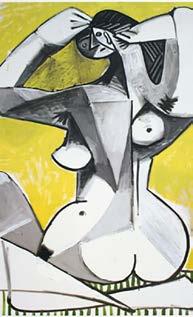

121 VOYAGER 5/2016 LUCERNE
A carved dying lion is a symbol of remembrance of the Swiss National Guardsmen, who died in 1792 defending the Tuileries Palace.
VEVEY IS THE SWISS RIVIERA PEARL LOCATED BY LAKE GENEVA; IT HAS A TEMPERATE CLIMATE AND VINEYARDS, AND OFFERS A BREATHTAKING PANORAMA OF THE ALPS.
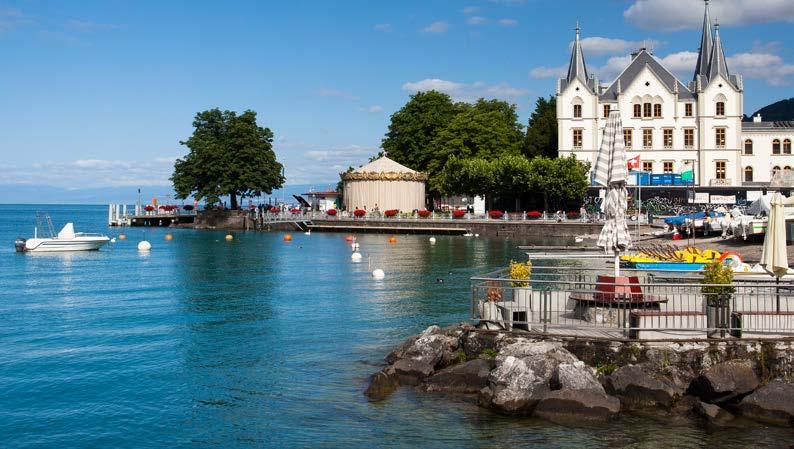
VEVEY IS THE CITY OF CHAPLIN AND NESTLE.
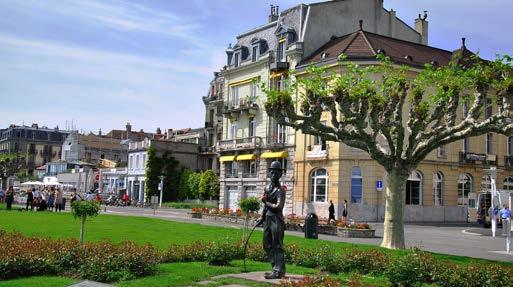
CHAPLIN'S WORLD

Chaplin's house (“Homeland of the Persecuted") is located at the Corsier sur Vevey Commune.
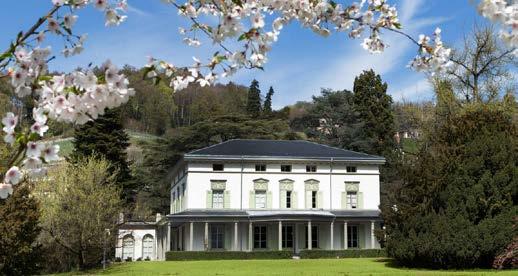
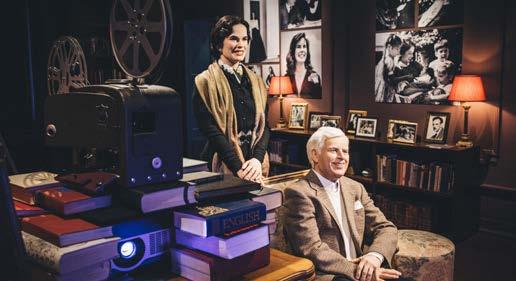

The actor lived here with his family for 25 years. The museum was opened this spring. We strongly recommend taking the time to visit this amazing place, wherever you are in Switzerland. A Corsier sur Vevey-bound bus leaves the railway station every 40 minutes. The bus ride takes approximately 15 minutes.
Charlie Chaplin was born in England where he started his career. The actor decided to settle in the United States, in 1912, during his tour of America.
Chaplin attended the "Limelight" world premiere in London after 40 years. He was unable to return home to the US, as the head of the FBI, J. Edgar Hoover, made big efforts to have the actor’s visa
Henri Nestle developed a milk powder production method and founded one of the world's largest companies in 1867. The Nestle chocolate factory and the company's headquarters are located in Vevey.
revoked. Chaplin was unable to return to the United States. The reason was accusations of anti-American activity and Communist sympathies. When he lost his home, Chaplin decided to move to Vevey – a small Swiss town on the shores of Lake Geneva, where he lived until his death.
Open every day: 10:00-18:00.
Route de Fenil 2
ALIMENTARIUM
Nestlé’s food Alimentarium is the only one in the world. This unique museum allows visitors to look inside the modern and historical kitchens of the local and world population.
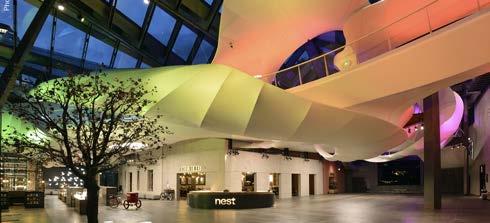
It offers interactive expositions on the ethno-cultural phenomena of food.
Quai Perdonnet Case Postale 13
THE EXHIBITION TELLS THE STORY OF THE ACTOR’S LIFE - PERSONAL ITEMS, PHOTOGRAPHS, MANUSCRIPTS, FAMILY ARCHIVES, POSTERS, AND WAX FIGURES OF THE CHARACTERS. THE HOUSE IS SURROUNDED BY 14 HECTARES OF PARKLAND WITH MAGNIFICENT VIEWS OF LAKE GENEVA. CHAPLIN'S FILMS ARE SCREENED HERE. YOU MAY TASTE THE WINE FROM THE LOCAL ESTATES AND BUY SOME SOUVENIRS FROM THE MUSEUM SHOP.
AN EIGHT-METER SCULPTURE OF A FORK IS LOCATED AT LAKE GENEVA AS AN ADVERTISEMENT FOR ALIMENTARIUM.

VEVEY 122 VOYAGER 5/2016
VEVEY

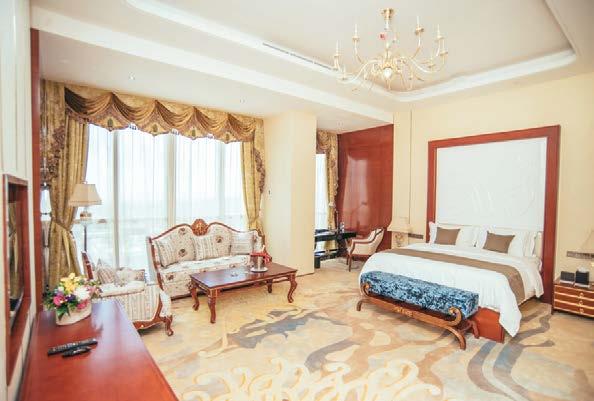


MONTREUX, THE CAPITAL OF THE SWISS RIVIERA, HAS A MILD CLIMATE AND BEAUTIFUL LAKE GENEVA COASTLINE; IT IS FULL OF LUXURY HOTELS. THERE ARE PLENTY OF RESTAURANTS AND CAFES WITH COZY TERRACES, WHICH OFFER DELICIOUS DISHES.


CHILLON TOWERS
Travel to Chillon castle, which is located on the island; With its defensive walls, towers and prison, it was an inspiration to Lord Byron.
In 1816, he wrote his “The Prisoner of Chillon”. Now the castle is a museum.

GRAND HOTEL SUISSE MAJESTIC
This hotel is located in the center of Montreux and is the perfect place to relax.
BAR 45 The Grand Hotel's lounge terrace is perfect for the summer season. Here you can enjoy the breathtaking view while a cozy atmosphere awaits in the warm winter garden from the autumn through to the spring.
Avenue des Alpes 45
A BRONZE STATUE OF FREDDIE MERCURY IS ERECTED ON THE COAST, ON PLACE DU MARCHÉ SQUARE. IT IS ALWAYS COVERED IN BOUQUETS. IT'S THE SINGER’S ONLY SCULPTURE IN THE WORLD. FREDDIE MERCURY DIED IN MONTREUX IN 1991.

FAIRMONT LE MONTREUX
PALACE This hotel was built during “La Belle Epoque” in 1906. It is a genuine pearl of architecture. It has 236 richly furnished rooms. Its superb views of the Alps and the lake and delicious cuisine attracts guests.
MP’S BAR & GRILL This place is famous for its grilled dishes. It has an elegant, cozy cocktail bar and a beautiful terrace with fresh alpine air. The
main part of the menu offers fresh fish and meat, as well as the chef’s unique dishes
MONTREUX JAZZ CAFE

If you choose to stay in Fairmont Le Montreux Palace, Montreux Jazz Café will certainly attract your attention with its fabulous design. It offers a wide variety of cuisine, the best wines of the region and a range of aperitifs.
MONTREUX IS KNOWN FOR ITS PRIVATE SCHOOLS, BEAUTY INSTITUTE, NIGHT CLUBS, CABARETS, BARS, FESTIVALS AND CASINOS. MOST OF THE BUILDINGS ARE LOCATED ON THE COASTLINE. THEY WERE CONSTRUCTED DURING “LA BELLE EPOQUE”, INCLUDING THE FAIRMONT LE MONTREUX PALACE AND CONVENTION CENTRE.
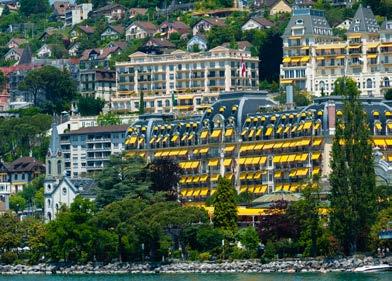
Montreux Jazz Festival's history dates back to the 1960s, and every year, in early July, the two-week event adds a new page to the history of jazz. The festival's main stage, Stravinsky Hall, is located in the complex where the main concerts are held every evening. Halls are named after famous musicians of the past such as the Stravinsky Hall and Miles Davis Hall. Musicians claim that these halls have perfect acoustics. Debutant musicians perform alongside celebrity performers.
There is another very interesting feature: euro, dollar or franc are not the main currencies here. During the festival, visitors can trade with the currency "jazz”, invented by the festival's founder. This is a metal coin perforated in the middle. Stores that accept these coins receive a considerable amount of tax benefits from the state. A Hall Music Pass allows the owner to attend the Montreux Jazz Lab, Stravinsky Hall and Miles Davis Hall events.
Ticket price per concert: CHF 60/120/140/180

MONTREUX 124 VOYAGER 5/2016
MONTREUX
PROVIDING PREMIUM QUALITY CONSTRUCTION SERVICES WITH PREMIUM QUALITY MATERIALS

USING ADVANCED FRAMING TECHNIQUES – ENERGY EFFICIENT, COST-EFFECTIVE GREEN FRAMING
BE THE OWNER OF ONE OF ONLY 10 APARTMENTS, COME HOME TO QUALITY, COMFORT AND EMBRACE THE LUXURY LIVING
Giving you home in the city’s most prestigious Vake district 13/8, Z. Paliashvili str.
RES IS COMMITTED TO MAKING A DIFFERENCE IN THE EXPERIENCE OF THE CUSTOMERS AND CHANGING THE CITY LANDSCAPE FOR THE BETTER BY RESTORING THE PAST AND BUILDING THE FUTURE. THEREFORE, THE COMPANY REPLACES DAMAGED AND ENDANGERED BUILDINGS WITH THE MOST RELEVANT, RELIABLE AND INNOVATIVE ARCHITECTURAL SOLUTIONS.
Sales office: 29, I. Chavchavadze ave. / Tel: 032 225 91 91
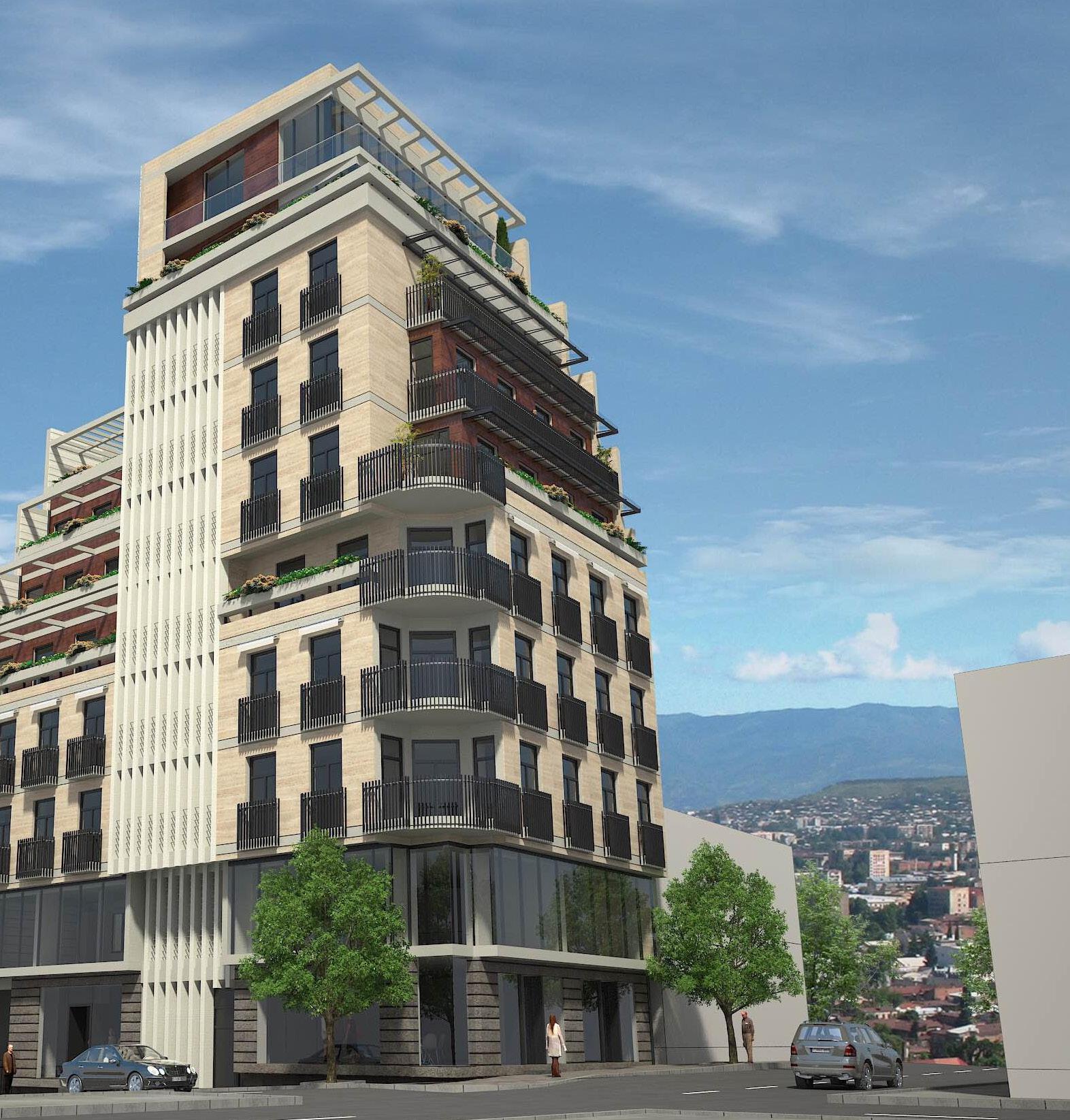
LUGANO, THE COUNTRY’S THIRD BANKING AND BUSINESS CENTER, IS A CITY OF WONDERFUL FLORAL PARKS, LUXURIOUS VILLAS AND ANCIENT CATHEDRALS.
LUGANO FEELS MEDITERRANEAN – A COMBINATION OF A MAJOR FINANCIAL CENTER AND SMALL-TOWN CHARM.
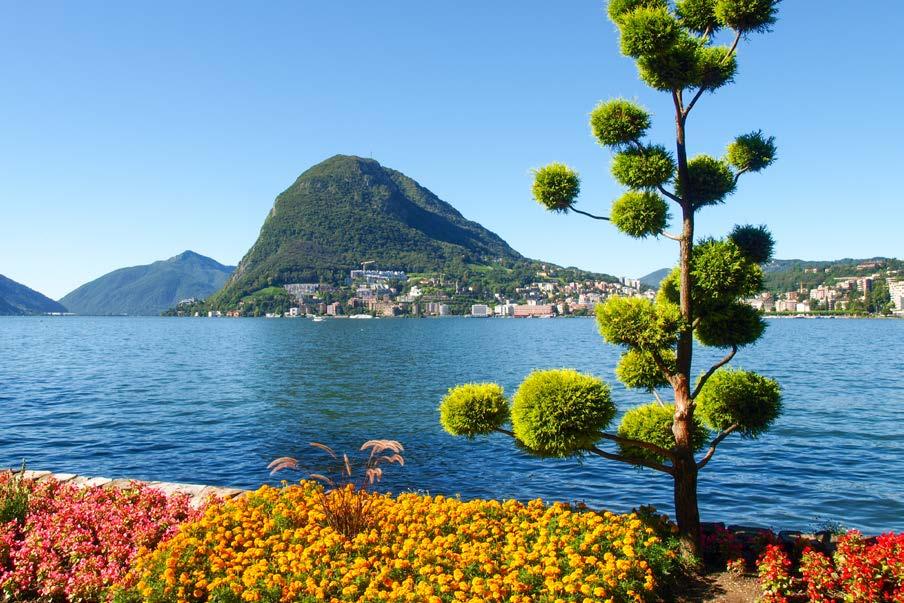

LUGANO’S LAKESIDE IS CALLED "OLD WORLD RIO DE JANEIRO" DUE TO ITS CLIMATE AND TEMPERAMENT. THIS IS AN ITALIAN SWITZERLAND – THE LARGEST CITY IN THE SWISS CANTON OF TICINO.
Church San Abbondino
LUGANO
LUGANO OFFERS UNIQUE MUSEUMS, MOUNTAINS, LAKES, PICTORIAL VIEWS, PALM TREES, OLIVE TREES, OPEN CAFES AND A UNIQUE ATMOSPHERE; THE CITY IS CALLED DOLCE FAR NIENTE, MEANING PLEASANT IDLENESS AND ENJOYMENT OF LIFE. WE RECOMMEND VISITING LUGANO IN THE SPRING WHEN THE CAMELLIAS ARE IN BLOOM.
PARCO CIVICO CIANI is a beautiful park near the center of town. It covers 63 thousand square meters and is the best place for walking and relaxing. Villa CIANI hosts the best museum in the city.
SANTA MARIA DEGLI ANGELI
The SANTA MARIA DEGLI ANGELI chapel was designed by the architect Mario Botta and decorated by the artist Enzo Cucchi. It is considered a miracle of modern architecture.
This is a compulsory destination for any guest in Lugano: the impressive building makes one think and also offers a different view of the surroundings. It is a special example of contemporary understanding of religious architecture.
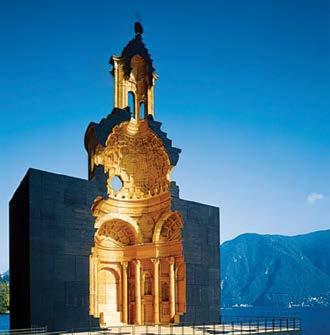
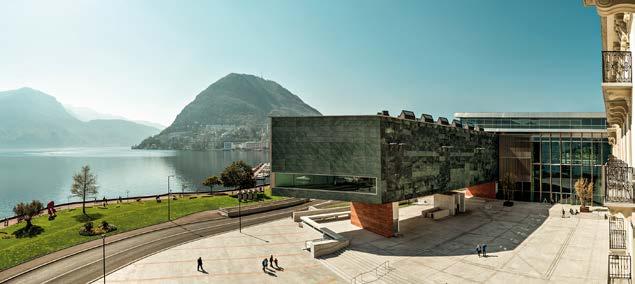
HERMANN HESSE MUSEUM

This cozy, small museum is located near the fortress, in which the writer lived for over half a century.
Hermann Hesse created several important works, including "Siddhartha", in this castle, in the picturesque village of Montalone. Today it is part of the city.
Ra Cürta 2
The Museum of Fine Arts in Lugano houses works of Klee, Renoir, Degas, and Pissarro.
Riva Caccia 5
THE GRAND HOTEL VILLA CASTAGNOLA AU LAC
This hotel boasts a superior location and subtropical park, and a comfortable and cozy atmosphere. It has 78 rooms, including 28 suites. All of the rooms have a terrace or balcony overlooking the lake. The standard room price starts at 450 CHF.
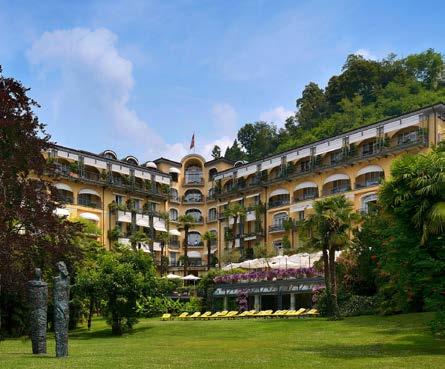 Viale Castagnola 31
Viale Castagnola 31
126 VOYAGER 5/2016
MASI LUGANI
This is an Italian Switzerland – the largest city in the Swiss canton of Ticino.
LUGANO



























































 Tea Skhirieli Editor-in-Chief
Tea Skhirieli Editor-in-Chief











 Spiegelgasse 1
Seestrasse 27
Gablerstrasse 15
Spiegelgasse 1
Seestrasse 27
Gablerstrasse 15

































































































 Felix und Nabor Straße 2 Bad Krozingen-Schmidhofen
Felix und Nabor Straße 2 Bad Krozingen-Schmidhofen













 Thea Djordjadze / Untitled 2009 Wood, glass, lacquer, paper, clay, plaster, plastic, fabric © Thea Djordjadze, Courtesy Sprüth Magers
Thea Djordjadze / Untitled, 2009 Wood, paper mache, lacquer, paint © Thea Djordjadze, Courtesy Sprüth Magers
Ketuta Alexi-Mekshishvili / Installation view at Statements, Art Basel, 2016 Micky Schubert, Berlin / Photo © Eric Tschernow, 2016
Thea Djordjadze / Untitled 2009 Wood, glass, lacquer, paper, clay, plaster, plastic, fabric © Thea Djordjadze, Courtesy Sprüth Magers
Thea Djordjadze / Untitled, 2009 Wood, paper mache, lacquer, paint © Thea Djordjadze, Courtesy Sprüth Magers
Ketuta Alexi-Mekshishvili / Installation view at Statements, Art Basel, 2016 Micky Schubert, Berlin / Photo © Eric Tschernow, 2016



































































































 Hermann Hesse - Thomas Mann: Briefwechsel
Hermann Hesse - Thomas Mann: Briefwechsel






























 7132 THERME Vals
ZURZACH- ANCIENT CITY ON
7132 THERME Vals
ZURZACH- ANCIENT CITY ON









































































 SALOME DADUNASHVILI
SALOME DADUNASHVILI















































































 Viale Castagnola 31
Viale Castagnola 31



